ST. ANDREW’S

FALL 2022 MAGAZINE
TALK OF THE T-DOCK
28 SHOW UP, WORK CLEAN, ASK QUESTIONS
A conversation with chef and cookbook author Gregory Gourdet ’93
Cleo Pahlmayer ’01 on her career in wine 40 TABLE TALK
Celebrating Commencement 2022, Class of 2020, and Reunion 2022

CAN’T HELP BUT CONNECT
Charles Kolb ’69 reflects on a new biography about author William Hollingsworth Whyte ’35 69
{ Third Form students in Dance Fundamentals smile big after performing a dance, choreographed by dance teacher Avi Gold, to Electric Love by Børns on the Engelhard stage during Arts Weekend 2022. }
ON THE COVER: Gregory Gourdet ’93 has a new suggestion for your “To Read” pile: his James Beard Award-winning Everyone’s Table, a cookbook stocked with the unique take on Haitian and Asian-inspired cuisine that makes his Portland restaurant, kaan, a standout. The former Top Chef contestant and judge is the star of our second installment of “If These Walls Could Talk,” in which current students interview an alumnus who previously lived in their room or dorm. The smart and flavorful conversation (please don’t read on an empty stomach) starts on page 28.
Photo by Zach Lewis.
2 LETTER FROM THE EDITOR 10 HEAD OF SCHOOL’S MESSAGE 12 AROUND CAMPUS
14 GO SAINTS
FEATURE STORIES
38 MAKING MOMENTS OF TOGETHERNESS
Alumni working in the food & beverage industry share wisdom & insights 46 SAINTS TOGETHER
62 ALUMNI REFLECTION
SPOTLIGHT:
CLASS NOTES
IN MEMORY
THE LAST WORD ST. ANDREW’S MAGAZINE | Fall 2022 VOLUME 44, ISSUE 2 This publication is printed with vegetable-based soy inks on paper with 10% post-consumer waste. Please complete the process by recycling your copy when finished.
VOLUNTEER
RANDY BRINTON ’64 76
80
84

Letter from the Editor

One of the core components of everything we do at St. Andrew’s is familystyle dining—and one of the silver linings of the pandemic has been our ability to get a sort of “A/B test” of life at St. Andrew’s with and without family-style meals in the middle of the day. Is it nice to be able to grab a plate from the servery and scarf down my lunch at my desk while getting additional work done? Sure. But is it better—is it good, in the virtuous sense of the word—to break bread with other people? Absolutely.
There’s more time and space in the day without family-style lunch cemented into the center of your schedule. There’s also, at least in my experience, less connection, less conversation, and more staring at a screen.
As a working mom, I prize any scrap of unstructured time I can get my hands on. And yet! And yet I know that without family-style lunch, I don’t get the chance (not being a teacher) to talk with our miraculous, marvelous students about whatever is on their minds, I don’t get a hit of the energy that fills the Dining Hall during post-meal announcements, I don’t have a lovely little midday conversation with my husband, and I don’t actually pay attention to what I’m eating. I just spend all that longed-for unstructured time scrunched over my laptop, dealing with the Sisyphean task of my email, or half-watching a webinar on social media trends, or—you get the idea. By creating a permanent space in the daily schedule at St. Andrew’s for sit-down meals taken together, we give students, faculty, and staff the chance to get to know one another and to serve one another, yes, but we do something more. We provide for a fundamental human need for connection through sustenance. And we don’t even have to choose what is the perhaps harder, but better thing to do—you just show up.
As you are all out and about in your post-St. Andrew’s lives reading this, you no longer have the luxury of simply showing up for a scheduled family-style meal each day. You have to make the time and the space to connect with others over food, and that is what this issue of the St. Andrew’s Magazine is all about. I hope what you see and read in these pages inspires you to host a dinner party (perhaps you can make something from the cookbook of Gregory Gourdet ’93; see page 28 for more); make a plan to visit one of the many alumni-run restaurants featured in these pages; share a bottle of Wayfair—a wine made by Cleo Pahlmeyer ’01, interview on page 38—with an old friend; or simply to take a seat at your neighborhood bar and introduce yourself to a stranger. Because what’s better than breaking bread with those you love? Not much, it turns out.
All my best,
Liz Torrey Director of Communications
SAS / ST. ANDREW’S MAGAZINE 2 / TALK OF THE T-DOCK
By creating a permanent space in the daily schedule at St. Andrew’s for sit-down meals taken together ...We provide for a fundamental human need for connection through sustenance.
ST. ANDREW’S MAGAZINE
DIRECTOR OF COMMUNICATIONS
Liz Torrey
COMMUNICATIONS TEAM
Amy Kates, Amy Kendig, Rachel Mavity
CLASS NOTES EDITOR
Chesa Profaci ’80
CONTRIBUTORS
Chris Hayes, Charles Kolb ’69, Anne Tergesen P’17,’22, George Windels ’22
PHOTOGRAPHY
Rhonda Bowman, Erin Farrell Photography, Zach Lewis, On the Move Photography
MAIL LETTERS TO:
St. Andrew’s Magazine, 350 Noxontown Road, Middletown, DE 19709-1605
GENERAL EMAIL: magazine@standrews-de.org
CLASS NOTES EMAIL: classnotes@standrews-de.org
St. Andrew’s Magazine is published by the Communications Office for alumni, parents, grandparents and friends of St. Andrew’s School. Printed by Pavsner Press in Baltimore, Md. Copyright 2022.
Mission Statement of St. Andrew’s School
In 1929, the School’s Founder, A. Felix duPont, wrote: The purpose of St. Andrew’s School is to provide secondary education of a definitely Christian character at a minimum cost consistent with modern equipment and highest standards.
We continue to cultivate in our students a deep and lasting desire for learning; a willingness to ask questions and pursue skeptical, independent inquiry; and an appreciation of the liberal arts as a source of wisdom, perspective, and hope. We encourage our students to model their own work on that of practicing scholars, artists and scientists and to develop those expressive and analytical skills necessary for meaningful lives as engaged citizens. We seek to inspire in them a commitment to justice and peace.
Our students and faculty live in a residential community founded on ethical principles and Christian beliefs. We expect our faculty and staff to make our students’ interests primary, to maintain professional roles with students and to act as role models at all times, to set and maintain healthy boundaries with students, to encourage student autonomy and independence, to act transparently with students, and to support each student’s developmental growth and social integration at the School. Our students collaborate with dynamic adults and pursue their passions in a co-curriculum that includes athletics, community service and the arts. We encourage our students to find the balance between living in and contributing to the community and developing themselves as leaders and individuals.
As an Episcopal School, St. Andrew’s is grounded in and upheld by our Episcopal identity, welcoming persons regardless of their religious background. We are called to help students explore their spirituality and faith as we nurture their understanding and appreciation of all world religions. We urge students to be actively involved in community service with the understanding that all members of the community share responsibility for improving the world in which we live.
St. Andrew’s is committed to the sustainability and preservation of its land, water and other natural resources. We honor this commitment by what we teach and by how we live in community and harmony with the natural world.
On our campus, students, faculty, and staff from a variety of backgrounds work together to create a vibrant and diverse community. St. Andrew’s historic and exceptional financial aid program makes this possible, enabling the School to admit students regardless of their financial needs.
BOARD OF TRUSTEES
Scott M. Sipprelle ’81 P’08, Chair
Henry duP. Ridgely ’67, Vice Chair
Kellie S. Doucette ’88 P’18,’18,’21, Secretary
Richard B. Vaughan ’88 P’24, Treasurer
Mercedes Abramo P’18,’22
Michael Atalay ’84 P’17,’19,’23
Aaron Barnes P’21,’24
The Rt. Rev. Kevin S. Brown Bishop of Delaware
Mati Buccini P’21,’23
Porter Durham P’13,’25
Charles P. Durkin ’97
John Eisenbrey, Jr. ’74 P’01,’05,’07
Ari K. Ellis ’89
Moira Forbes ’97
Grace Gahagan ’10
Edith “Sis” Johnson P’11
Monica Matouk ’84 P’18,’21,’23
Joy McGrath ’92
Head of School
L. Heather Mitchell ’92
Paul F. Murphy P’17,’19,’22
Laurisa S. Schutt P’18,’23
Kate Sidebottom Simpson ’96
Andrea Sin P’16,’17
Jennifer B. Thomas P’22
TRUSTEES EMERITI
Katharine duP. Gahagan GP’10,’11, Chair Emeritus
J. Kent Sweezey ’70, Chair Emeritus
Sabina B. Forbes P’97,’06 GP’21
Monie T. Hardwick P’02,’04,’07
Maureen K. Harrington P’91,’93,’96,’99,’02
Timothy W. Peters ’66 P’91,’93 GP’19,’21,’24
Steven B. Pfeiffer P’95,’97,’00,’04,’09
Sally E. Pingree P’01
Caroline duP. Prickett GP’18,’20
Edward M. Strong ’66 P’07,’10
Alexander D. Stuart P’09
FALL 2022 3
Julissa Hernandez ’25 works out a problem on the glass walls of her Algebra classroom in Amos Hall while classmate Luke Ketzner ’25 looks on.
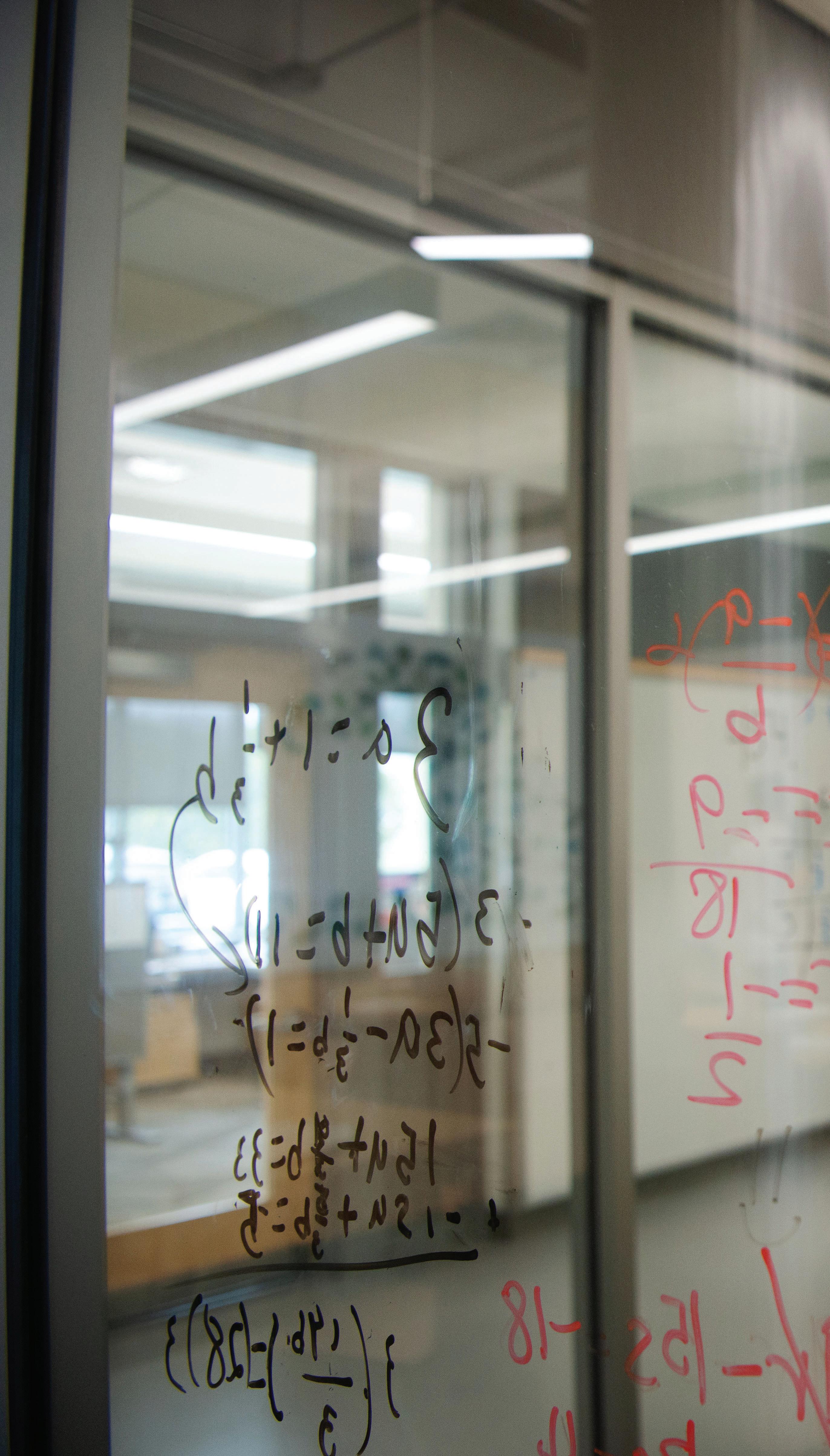
SAS / ST. ANDREW’S MAGAZINE 4 / TALK OF THE T-DOCK

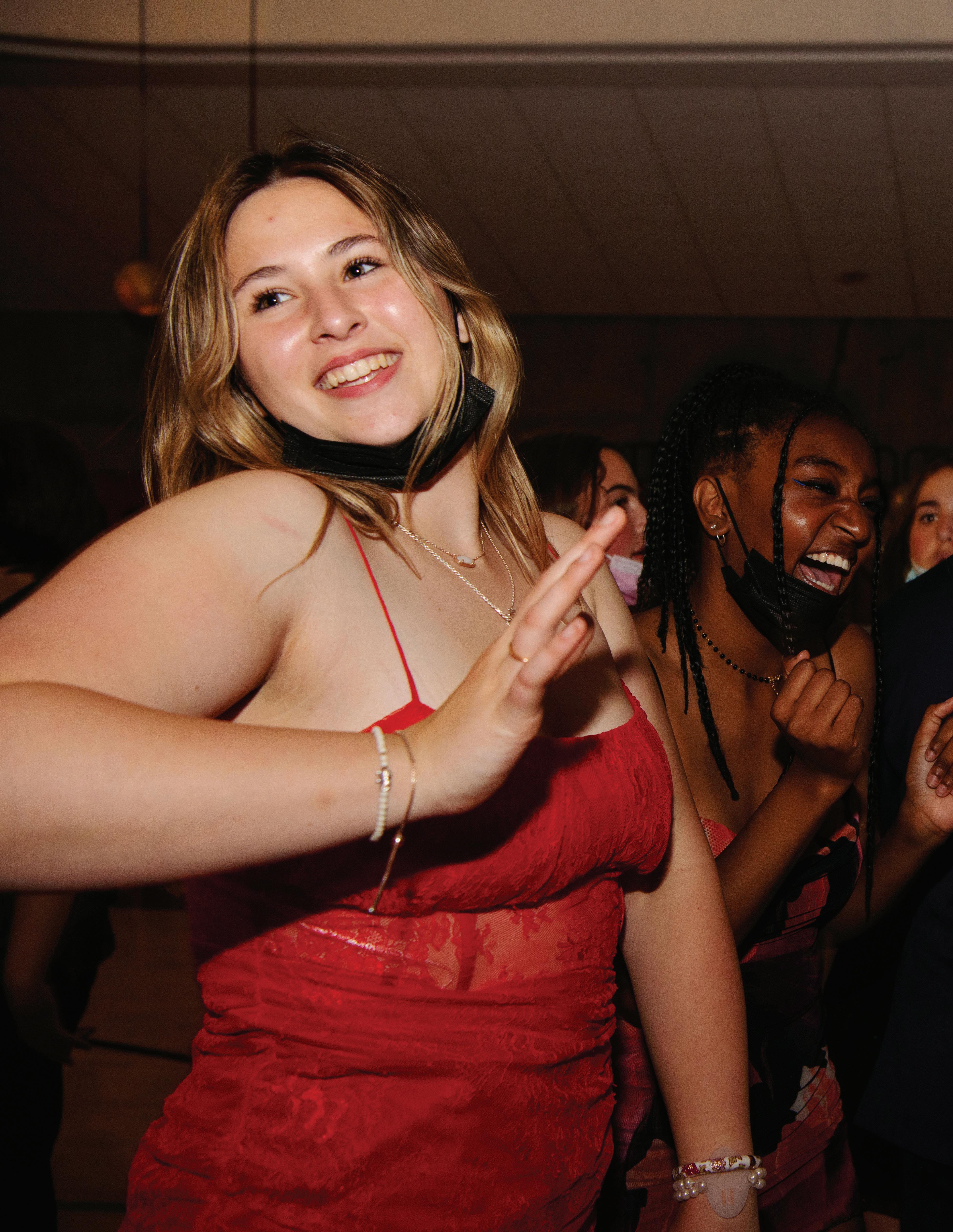

Members of the school’s South Asian Affinity Group—seen here with their faculty advisor Neemu Reddy (front row, far left)—organized the annual Holi celebration chapel for a sunny Friday afternoon in March. Holi is the Hindu festival of spring, and one of its traditional celebrations is a “festival of colors,” in which a community gathers to frolic and cover each other with colored powders. For this year’s Holi celebration, the SAS community first gathered in chapel to hear student reflections on the holiday, then migrated to the Front Lawn to douse each other with the rainbow.
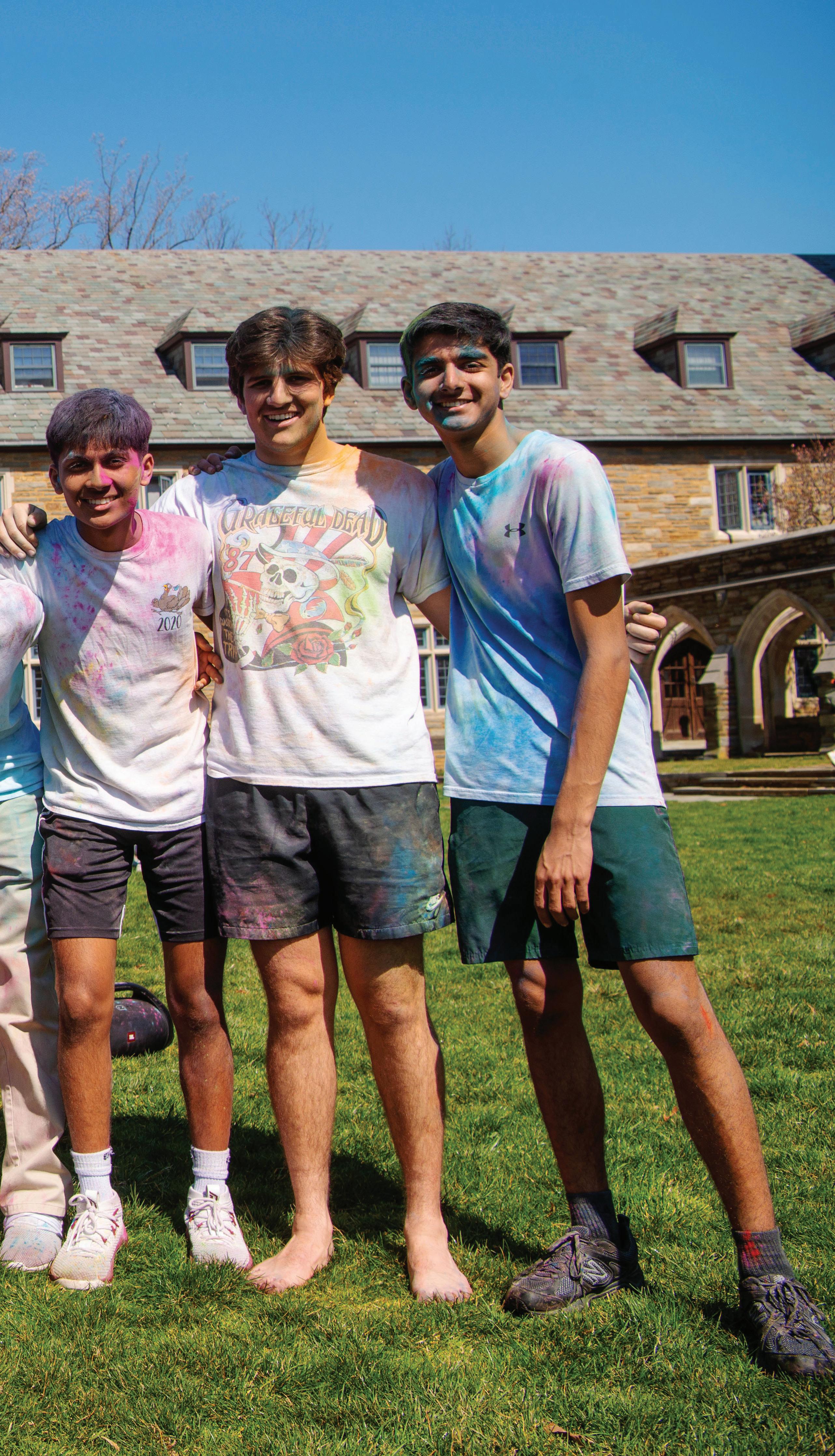
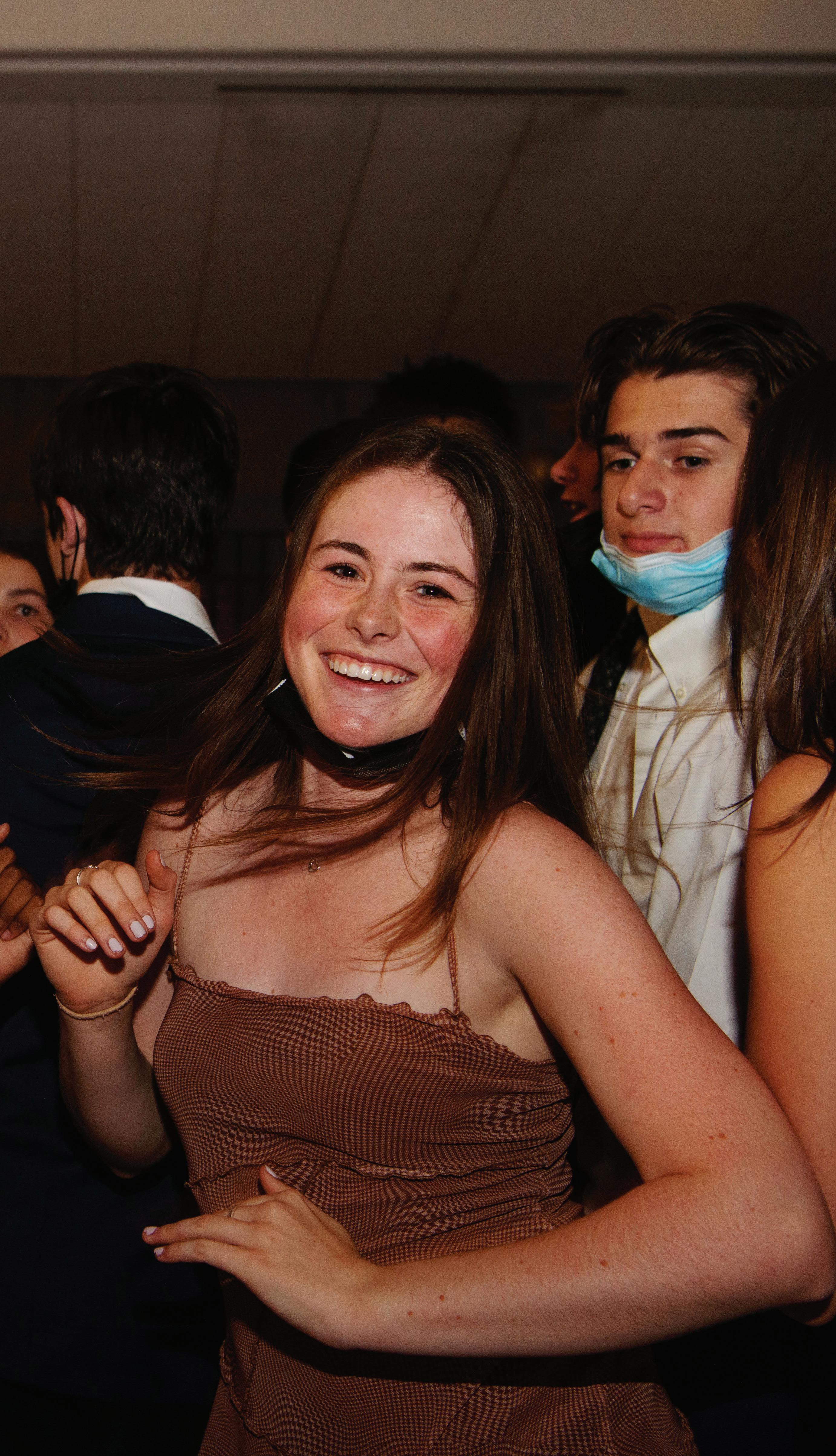
FALL 2022 7
Members of the Class of 2023 enjoy the school’s first “real” Frosty Run since the fall of 2019. Founded in 1990, this 32-year-old tradition is typically held on the first Saturday night of the school year, but was pushed back to the spring this year due to fall semester COVID-19 precautions. As many alumni will recall, during the Frosty Run, the entire student body travels via bus to various Wendy’s franchises throughout the MOT area; upon arrival, everyone enjoys a Frosty. Why? We have no idea, but it is a blast. This was the first official Frosty Run for III Form and IV Form students.
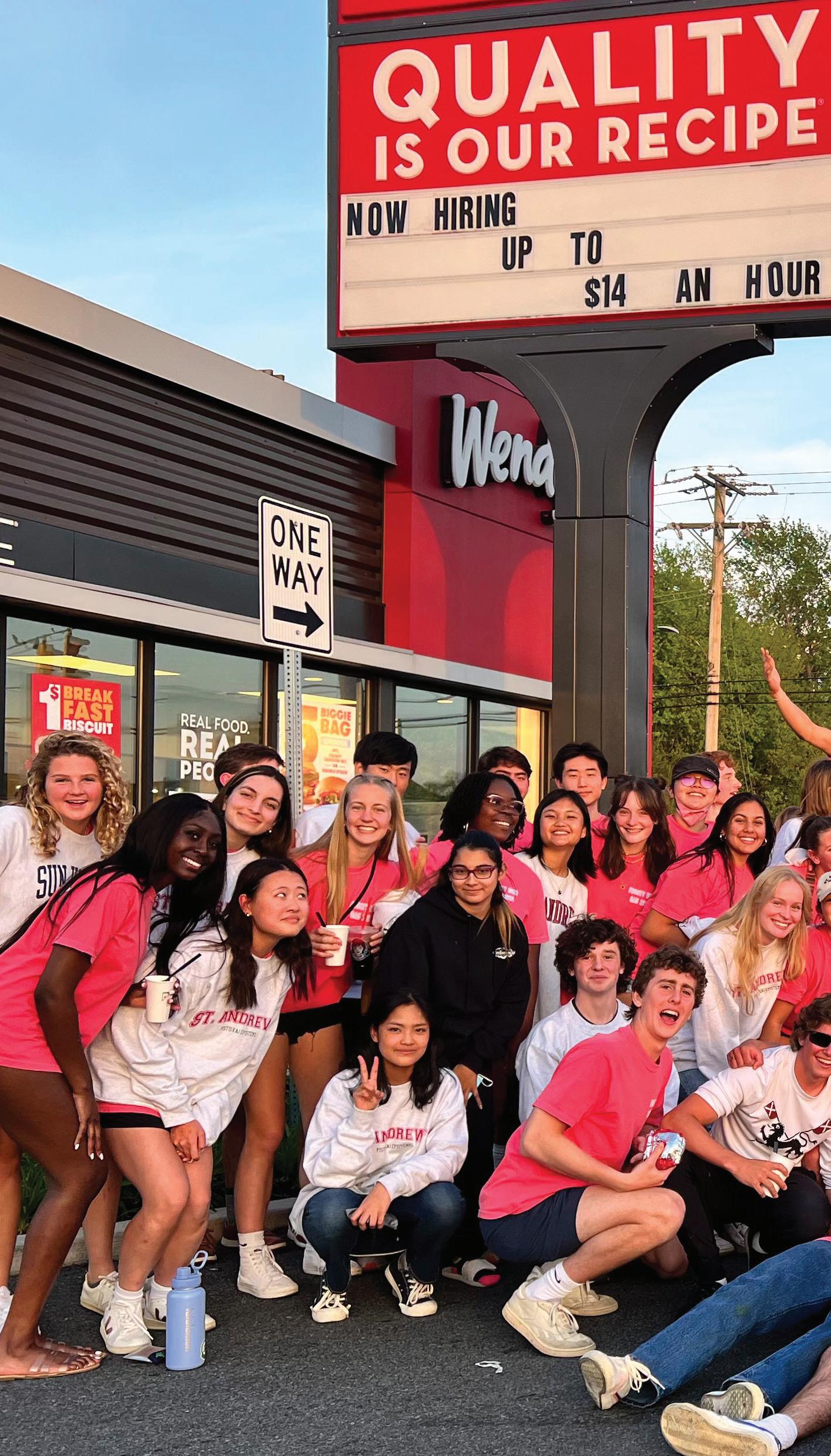
SAS / ST. ANDREW’S MAGAZINE 8 / TALK OF THE T-DOCK
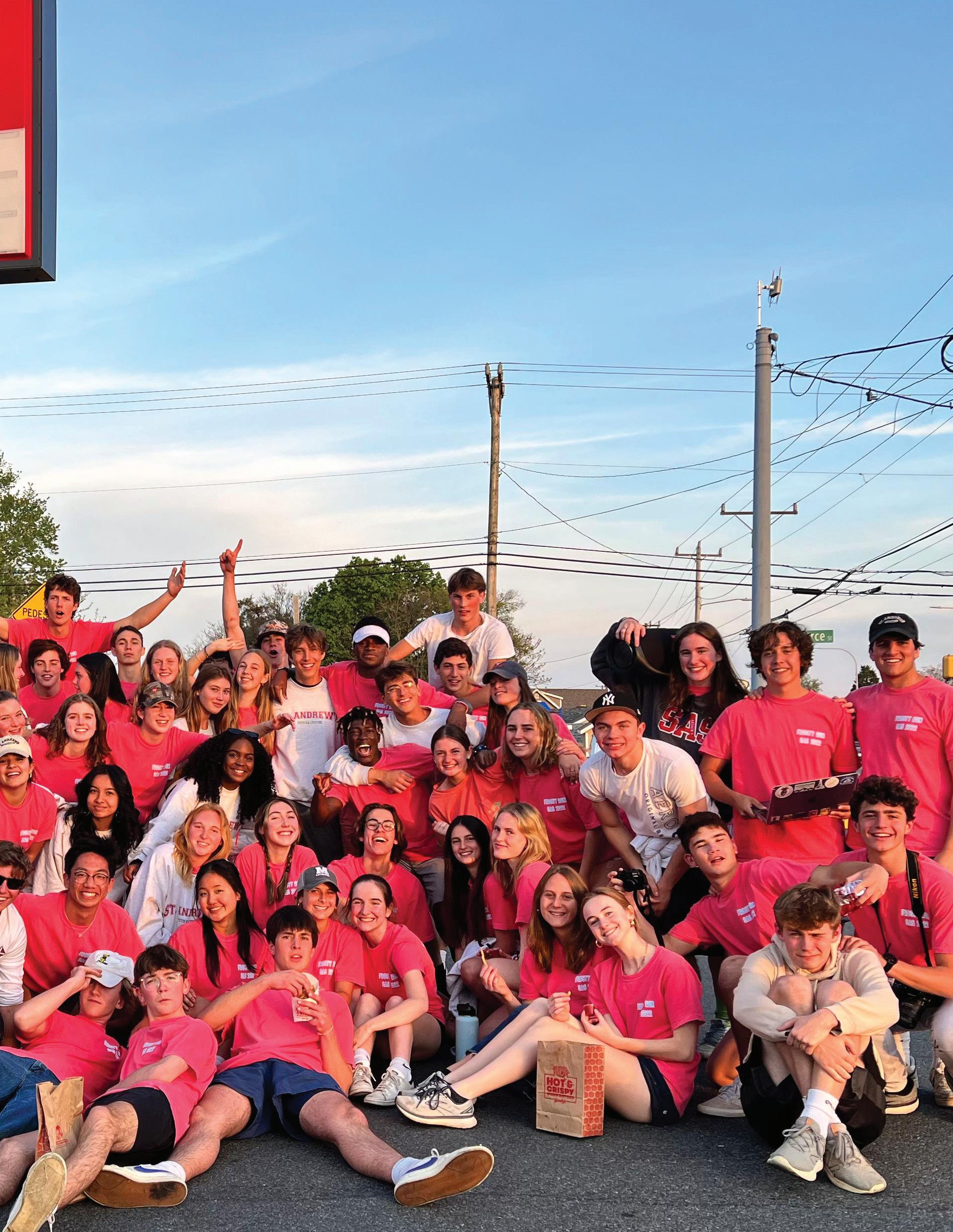
Message from the Head of School

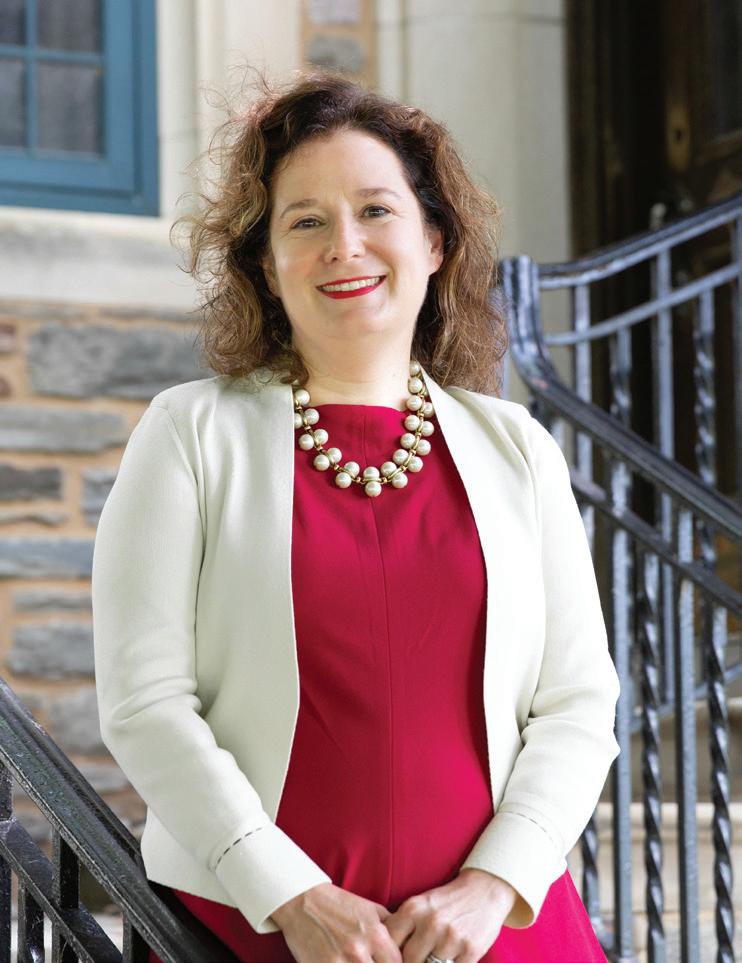
Myfirst cookbook had been my mother’s; the Better Homes & Gardens Junior Cookbook, 1955 edition. I recall making many dishes from it, including a pear “salad” in the shape of a bunny (a half of a canned pear with cottage cheese beneath it, atop a leaf of iceberg lettuce, with two cloves for eyes and cucumber slices for ears) and a tuna casserole (a can of tuna and a can of cream of mushroom soup) with a crushed potato-chip topping. By 9, however, I was cooking regularly, those early cooking experiments replaced with the recipes my mother and grandmothers taught me.
The earliest memory I have of cooking is from a hot day in late summer. My mother, grandmother, and I were canning pickle relish. I stood on a tall stool to reach the Kitchen Aid mixer, which had the grinder attached, and I set about grinding a bushel basket of onions. There were three bushels of bell peppers on the floor, ready to be ground next. I held a dish towel soaked in cold water over my eyes to calm the onion-induced tears. I can still see the rows of canned fruits and vegetables in our root cellar, and I can still taste the sweet and savory relish.
When I arrived at St. Andrew’s, one of the ways I tried to fit in was to help with meals—I was always comfortable with my hands in the dishpan or organizing the post-meal cleanup. Nan Mein, my VI Form advisor, taught me so much about new-to-me foods. I brought and shared my own traditions, too. When campus was blanketed in snow, I made my great-grandmother’s warm drop doughnuts, laced with orange zest and nutmeg, in the Moss Dorm kitchen. As a faculty member living on Schmolze Dorm in Founders Hall, it seemed that food and pots of tea were constantly flowing through my tiny kitchen and into the common room. And as a faculty member, sharing a table with Nan Mein taught me the careful balance between comfort and high expectation that was the hallmark of a great family-style meal. Every student at the table was known and seen.
We all have keen memories of food and feasting: festive meals marking family milestones, meals eaten while traveling that helped us to understand a different culture, meals around the table in the St. Andrew’s Dining Hall. Food brings us together, it illuminates our friendships and family relationships, and it helps us understand each other. It is no surprise that this food issue of St. Andrew’s Magazine that you hold in your hands came together quite easily. Alumni around the world are building community and belonging through food, just as we do on campus.
As Chaplain Jay Hutchinson recites each week during the Eucharist, “all are welcome at this table.” J
SAS / ST. ANDREW’S MAGAZINE 10 / TALK OF THE T-DOCK
Food brings us together, it illuminates our friendships and family relationships, and it helps us understand each other.
From the Mail Bag ST. ANDREW’S MAGAZINE
The Champion Among Us
I wanted to congratulate our classmate Richard Lambert on his article in the last issue of the St. Andrew’s Magazine (Winter Review 2022). Richard wrote on the 1960s athletic prowess of St. Andrew’s, its team sports, and its many individual champions. He spent many hours researching the school’s teams and their W-L records, the school archives, and newspaper articles from Wilmington published during our SAS years. He also interviewed our coaches (and teachers) Webb Reyner and Bob Colburn for his article.

I assume most of you have seen the issue and most likely read Richard’s article. Hopefully you recognized many names from our Class and others that achieved athletic accolades during the 1960s. What you did not read in the article is the superiority of the author, in his own record of victories during his fifteen seasons of team participation in soccer, wrestling, and tennis, starting in our II Form year. Richard did not mention in his article the fact that he himself was perhaps the most victorious St. Andrean in sports of all time due to his many victories as a solo athlete in wrestling and tennis. In fact, Richard was the Delaware state tennis champion in the spring of 1968. He defeated the top-seeded player, H. Herbert of Brandywine, 6-0, 6-4 in the state finals that year (see news article at right). At our graduation in June of 1969, Richard was awarded the Henry Prize for outstanding contribution in athletics for his many years at SAS, having won eleven varsity letters between 1964–1969. Since I was only involved in varsity sports with crew in the V and VI Forms, I appreciate Richard’s writing the article to pay homage to all of our scholars who excelled at athletics so many years ago.
Ken White ’69 •
An Indispensable Teammate Recognized
Richard Lambert’s article “Powerhouse Saints Athletics in the Late 1960s” generously listed the five seniors on the undefeated and state-champion tennis team of 1965. Let me add the V Former without whom we might not have been so successful: Tom Coulson ’66, an indispensable teammate in both singles and doubles. Chris Hunt ’65 •
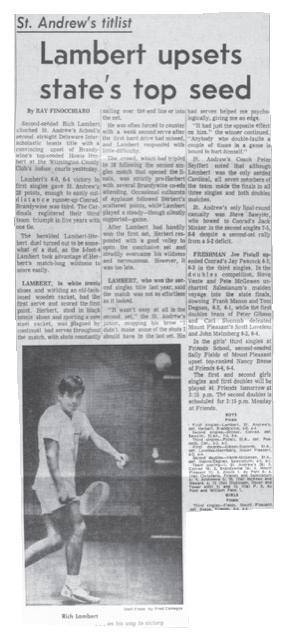
FALL 2022 11 AROUND CAMPUS /
Around Campus
Recent Leadership Appointments
St. Andrew’s will welcome a number of new leaders for the 2022-23 school year. All appointments described below were effective July 1, 2022.
Lizzie Brown ’08 has been appointed St. Andrew’s next director of counseling. In this role, Lizzie will develop and implement student wellness initiatives, and provide the leadership, vision, and strategic direction for the mental health services provided by the counseling department. Lizzie is a Licensed Professional Counselor Associate (LCPA) and specializes in supporting teens and young adults navigating anxiety, depression, adjustments, and disordered eating. She is also a 500-hour experienced registered yoga teacher (E-YRT). Lizzie has been studying and working in wellness and mental health in Austin, Texas, for the past ten years, and she views healing through a holistic lens of mind, body, and soul. She and her husband, Taylor Brown, both graduated from St. Andrew's in 2008.
Neil Cunningham has been appointed as St. Andrew’s director of athletics. As athletic director, Neil will manage and oversee all aspects of the school’s athletics program, including establishing vision and goals for Saints athletics; articulating this vision to students, colleagues, parents, alumni, and prospective families; and supporting the achievement of this vision by securing the resources for its success. Neil comes to St. Andrew’s with extensive experience in coaching, teaching, sports management, and athletics strategic planning. He was previously the assistant athletic director at Washington & Lee University in Lexington, Virginia, where he also served as the head coach of the women’s soccer team and the chair of the physical education department.
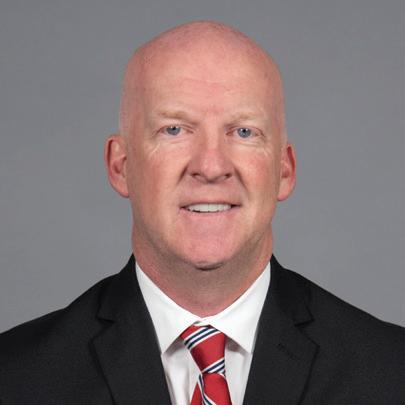
Danica Tisdale Fisher has been appointed as St. Andrew’s dean of inclusion and belonging, and as such, will be responsible for designing and implementing inclusion and belonging programs for all St. Andreans. This programming will support students in their formation as ethical, engaged citizens; engage employees in work around issues of diversity, inclusion, and equity; and provide our entire community with opportunities for learning, critical thinking, growth, and action. Danica comes to St. Andrew’s with a wide array of experience and academic accomplishments. She has served in leadership roles at a variety of colleges and independent schools, including Phillips Academy (Andover); University of California, Davis; Tufts University; Claremont McKenna College; and, most recently, Yale University, where she served as assistant dean for diversity in the Graduate School of Arts and Sciences.
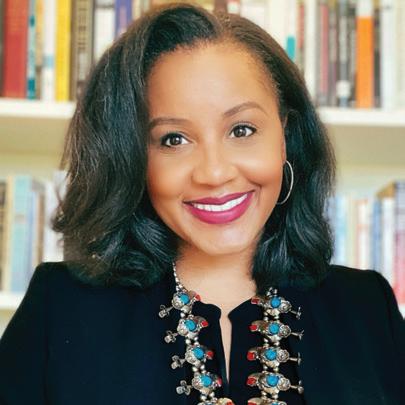
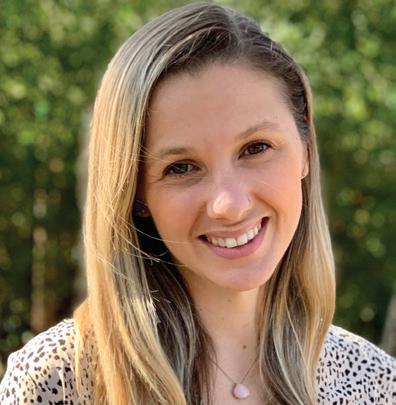
Ann Wardwell has been appointed as St. Andrew’s chief advancement officer. As chief advancement officer, Ann will lead the school’s Advancement Office (sometimes referred to as the Alumni Office), will manage and oversee all aspects of the school’s fundraising activities and constituent relations, and will work closely with the board of trustees, alumni, parents, faculty, and leadership in setting and accomplishing the school’s strategic fundraising goals. Ann comes to

SAS / ST. ANDREW’S MAGAZINE 12 / TALK OF THE T-DOCK
St. Andrew’s from Hong Kong International School in Hong Kong, China, where she has served as chief advancement officer since 2019. She brings to St. Andrew’s a wealth of experience in advancement leadership, strategic planning, organizational development, and marketing and communications.
Will Robinson ’97 P’26 has been named the school’s dean of admission and financial aid. Will has been a faculty member at St. Andrew’s since 2010, serving as director of communications, dean of students, and most recently, as dean of student life. Through his contributions as both an employee and alumnus of St. Andrew’s, he has been engaged and involved in almost every aspect of the student experience here, and possesses a unique understanding of our community’s principles and strengths, and of what it means to be a Saint in 2022. As dean of admission and financial aid, Will will be responsible for developing a team that is wellpositioned to navigate this time of great change in boarding school admission; sustaining and growing processes and best practices that will support a strong admission and financial aid program, partnering with communications to set the strategy for digital, social media, in-person, and print outreach for our small and very special school so that we can recruit the most diverse and strongest student body possible; and working with advancement leadership to develop a visionary program of financial aid worthy of St. Andrew’s great history and track record with regard to socioeconomic diversity. •

Delaware Baseball Renames Statewide All‑Star Game After Coach Bob Colburn
by Chris Hayes
If you’ve walked the halls of Founders at any point in the past 60 years, either Coach Bob Colburn has been a part of your life, or you at a minimum are aware of the impact he has had on this community. Coach Colburn has worked at St. Andrew’s since 1960, and has served as a teacher, advisor, dorm parent, and athletics director—coaching St. Andrew’s baseball all the while. He’s also been deeply involved in Delaware high school baseball and the Delaware Baseball Coaches Association (DBCA) for these six decades. Colburn was in the inaugural induction class when the Delaware Baseball Hall of Fame opened in 1994 (and the only high school coach in that cohort), and he was inducted into the Delaware Sports Hall of Fame in 2016.
His latest honor will ensure that Coach Colburn is recognized every spring in the state of Delaware: this winter, DBCA decided to rename the state’s high school all-star game—long known as the Delaware Blue/Gold Game—after Colburn. “Everyone knows about his place in St. Andrew’s history,” said Dave Battafarano, head baseball coach at Delcastle Technical High School and Colburn’s DBCA colleague. “When I started at Delcastle 20 years ago, we began to scrimmage and play St. Andrew’s every year. Coach Colburn would always talk about baseball, give advice, and help other coaches on opposing teams. He had such a passion for the sport and we all learned so much from him. I wanted to make sure he was honored and would always be a part of Delaware baseball history.”
When Battafarano floated the idea to other coaches in the state to rename the all-star game to the “Bob Colburn Blue/Gold All-Star Game,” every other coach in the meeting was immediately on board. “[The discussion] was over Zoom and I was not expecting Coach Colburn to be on the call, but of course he came,” Battafarano recalled. “It worked out because when I made the announcement on the call, he was there to hear it. It was really special to share the news with him.”
The dedication ceremony took place at Frawley Stadium in Wilmington, Delaware, before the first pitch of the “Colburn Game.” Of course, just prior to the ceremony, Coach Colburn was on the field, giving pointers to the starting pitcher. •
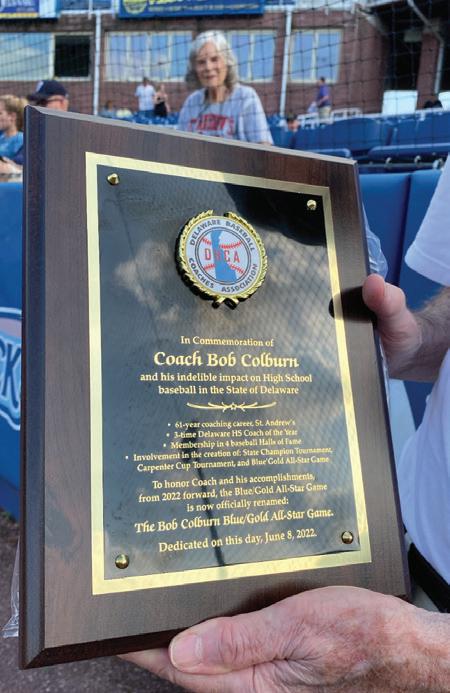
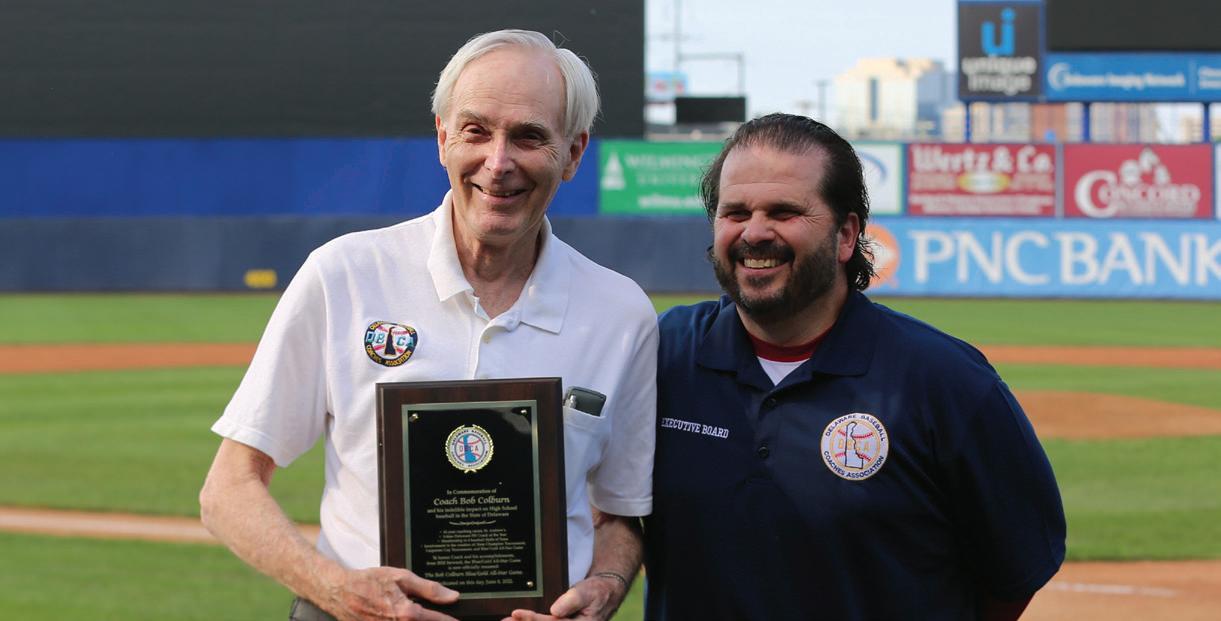
FALL 2022 13
BASEBALL

AN ORAL HISTORY
In the spring of 2020, with his sophomore year baseball season—and everything else related to his junior year spring—canceled by COVID-19, Saints baseball player George Windels ’22 decided to use his spare time to dive into the legacy and lore of St. Andrew’s baseball program. He and his mother, Wall Street Journal reporter Anne Tergesen P’17,’22 worked with Saints baseball former Head Coach Bob Colburn P’80,’82,’87 to research the team’s history and interview former players. Of course, for many players, their most indelible memories of SAS baseball center around not just big wins or broken records, but Coach Colburn himself. In the end, George and Anne assembled an oral history of the program, a few excerpts of which you can read here. The oral history is available in full on our website at standrews-de.org/front-lawn. If you’re a former member of a Saints baseball team and you’d like to be interviewed for this project, email magazine@ standrews-de.org
One highlight from the 1963-64 season came against Tatnall in the season opener. The “intense and detail-oriented” Coach Colburn had been preparing the team to go up against an outstanding left-handed Tatnall pitcher with a blazing fastball and a devastating curveball. The team took batting practice against the pitching machine at maximum speed for days. However, when the day of the game came, the anticipated Tatnall pitcher was sidelined with a sore arm and a pitcher with lesser skills started in his place. Geared up for great pitching, St. Andrew’s scored 35 runs that day—still a St. Andrew’s record. “It looked like beach balls floating to the plate,” recalled Curt, who hit a home run as a pinch hitter in the last inning. Because the team was ahead by a huge margin, instead of being congratulated by his bench, Curt was booed by his teammates as he rounded the bases. “I was actually ashamed, even though it was the only home run of my career,” he said.
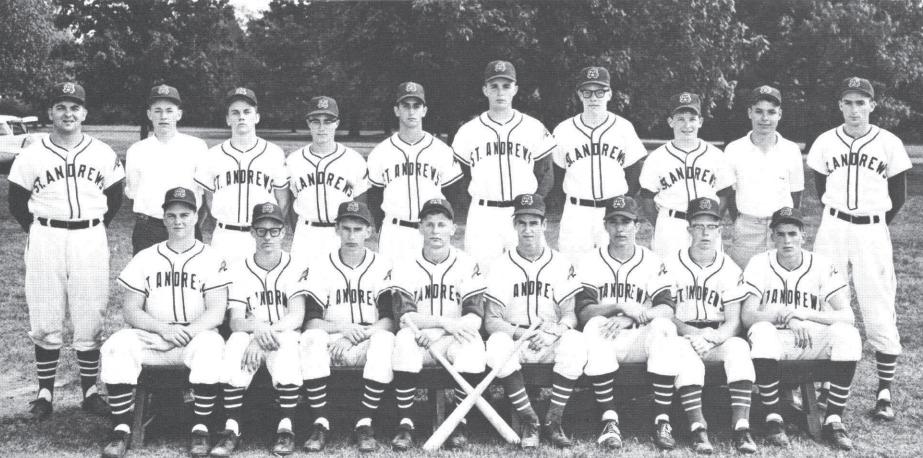
Terry Wild ’65
Although Terry had suffered from polio, Coach Colburn was very encouraging, and called Terry up to the varsity team as a relief pitcher during his junior year season. On the mound, Terry was a lefty, and loved “making good pitches, especially the curveball to righties.” The pinnacle of Terry’s time on the diamond came in 1965 when, as a starter, Terry pitched an entire eleven-inning game (yes, eleven) against Westtown. “[I] loved being on the field, competing, and felt honored to be on the varsity team,” Terry said.

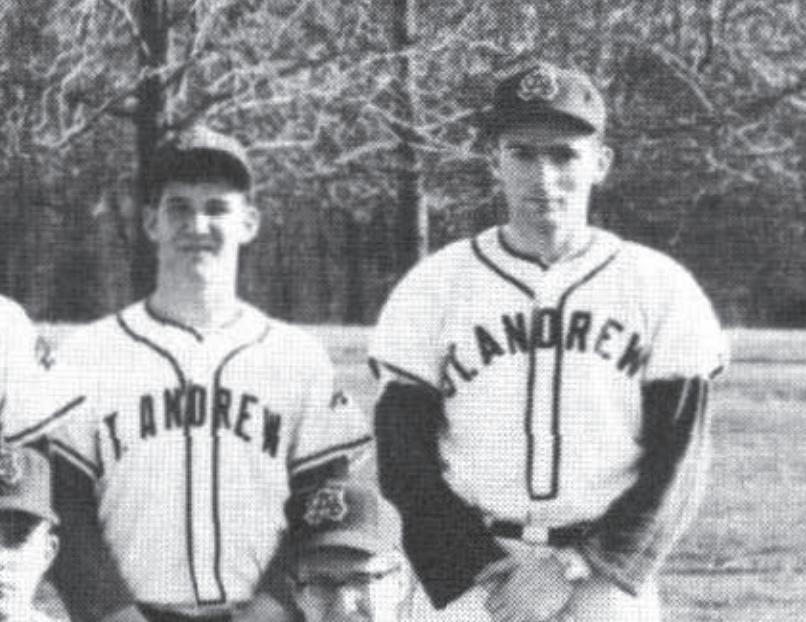
SAS / ST. ANDREW’S MAGAZINE 14 / TALK OF THE T-DOCK
Curt Coward ’64
A highlight of the 1979 season for Mike, who served as a captain, occurred during a game against St. Elizabeth’s. With the Saints ahead 1-0, Mike was on the mound throwing a no-hitter. In the last inning, Mike walked a batter, who stole second base and scored on a dropped infield pop-up, evening the game at 1-1. Then, a big left-handed hitter smashed a triple to the gap, putting St. Elizabeth’s up 2-1. After the inning, Mike threw his mitt in frustration while walking into the dugout. Coach Colburn grabbed him by the arm and yelled at him for throwing the glove, which helped Mike realize that there were “more important things than winning or throwing a no-hitter.” Coach Colburn “believed in a proper way to play baseball,” Mike said. “[This was] emblematic of Bob’s respect for the game and sportsmanship: he talked the talk and he walked the walk. [He was] a demanding coach. He wanted to win, [but] the right thing to do was driving his decisions.”
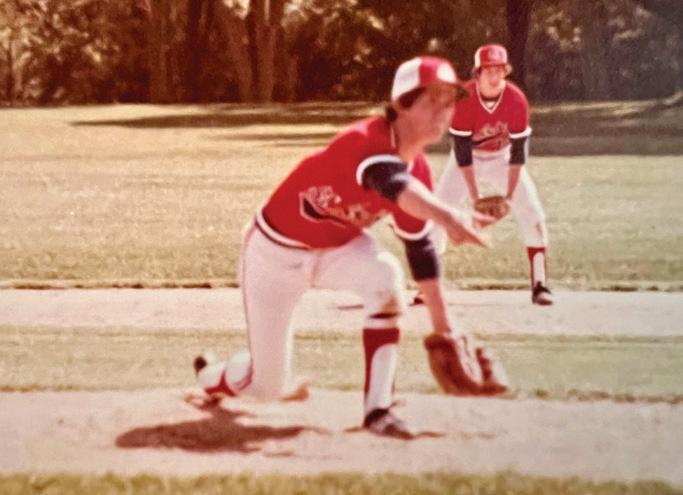
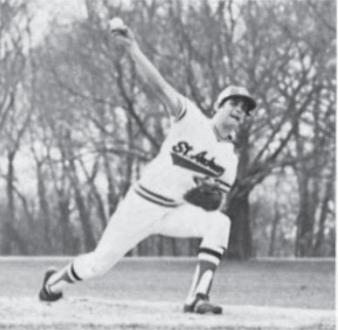

Brian recalled Coach Colburn’s “love of the game” and his keen “attention to detail.” “He drilled us,” said Brian, and noted he uses the time management and other skills he “learned from Colburn in the business world.”
Coach Colburn also modeled excellent “sportsmanship, [being] humble after a win and dignified after a loss.” In yet another game at St. Elizabeth’s, a team that “had our number,” St. Andrew’s was down by three runs the whole game. The St. Elizabeth’s pitcher was on a roll, “mowing down our guys,” Brian recalled. In response, Coach Colburn directed his players to start bunting, exposing a weakness in St. Elizabeth’s defense. St. Elizabeth’s fell “into confusion,” and St. Andrew’s went on to score runs “without getting the ball out of the infield,” propelling the team to victory. “Caesar Rodney, Salesianum, and Archmere were competitive,” Brian reflected. “The advantage that we had was Coach Colburn.”
Scott recalled that once, during preseason, Coach Colburn had to go to his room long after lights-out to tell Scott and some other rambunctious players to go to bed. Rather than protesting, the players “were disappointed in themselves,” Scott said. Above all, Scott remembers the camaraderie that came with playing baseball at St. Andrew’s. He remembers the bus trips in which players brought boom boxes to blare music. In his senior year, Scott and several of his best friends shared the experience of being in leadership positions on the team. “Baseball was closely correlated with the excitement that comes with the spring at St. Andrew’s,” Scott said.
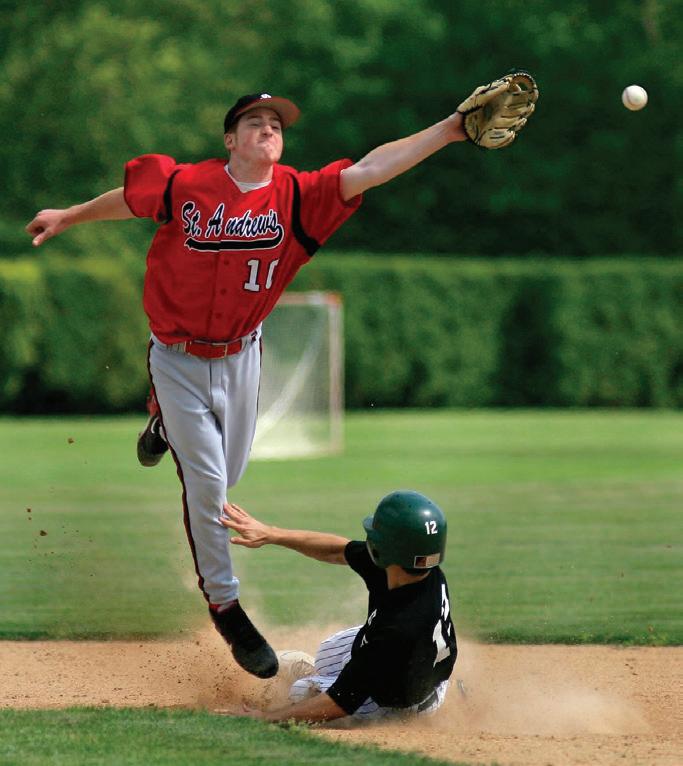
One distinctive memory Chris holds from his time in the red and white came on a Trustee Weekend, during a game in which the team was getting demolished by Tower Hill. Scott Sipprelle ’81 and Chris’ father, Will Speers, were watching from the sidelines. As Chris stepped up to bat, Will turned to Scott and said, “I’ll give $500 to the Saints Fund if my son hits a home run.” Scott said that he would triple it— and wouldn’t you know it, Chris hit a home run. “It was my first and only home run of my St. Andrew’s baseball career,” he noted.
“I had a special relationship with Coach Colburn,” Jake said. “Coach was the kindest coach I had at St. Andrew’s. He would stay behind after practice to help you get extra reps. Before preseason camp, he drove myself and John Cochran ’11 down to the field to get preseason reps.” Jake also recalled a “mystique about the tantrums that he may or may not have thrown.” A few years after Jake graduated from St. Andrew’s, Coach Colburn won a sportsmanship award before a game, and then in the first inning of the same game, he broke a clipboard over his leg out of frustration. “[He] did a lot for Delaware baseball, but what stands out is how he was always there for his players, day-in and day-out,” Jake concluded. “Colburn was very helpful to me [when I needed] advice on what I wanted to do with my life.”
FALL 2022 GO SAINTS! / 15
Mike Lilley ’79
Jake Myers ’12
Chris Speers ’07
Scott Sipprelle ’81
Brian Crow ’77
TO PLAY COLLEGE ATHLETICS SAINTS COMMIT
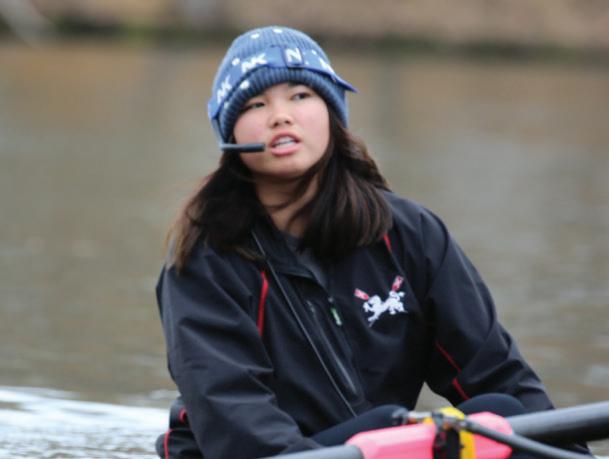
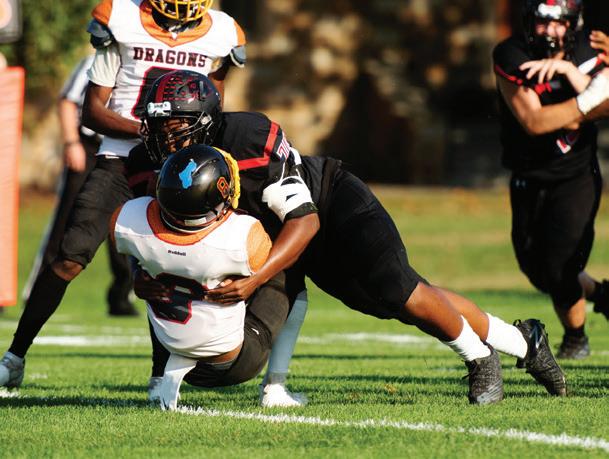
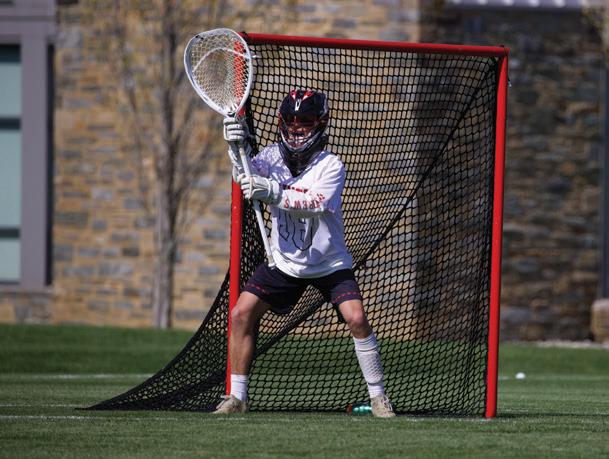
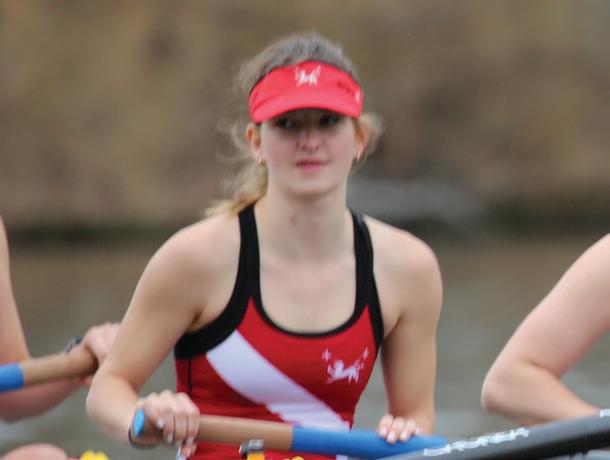
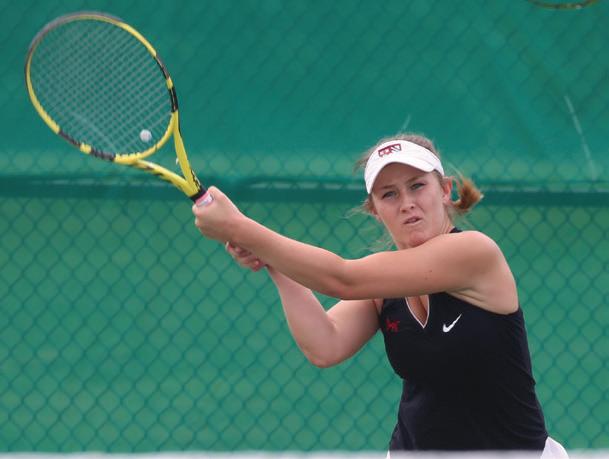

 BY CHRIS HAYES
BY CHRIS HAYES

We celebrated members of St. Andrew’s Class of 2022 who committed to play college athletics. Featured below, these nine students and their families gathered in the Sipprelle Field House for a signing day ceremony.
 WILLIAM ATKINSON AMHERST • SQUASH
SAGE COOKERLY SEWANEE • LACROSSE
ELIZABETH RAINEY COLGATE • SWIMMING
ALLAIRE BERL KENYON • TENNIS
GAVIN GREEN BROWN • ROWING
CLEO RAY BUCKNELL • ROWING
FLYNN BOWMAN SEWANEE • LACROSSE
PHINEAS HUNT MIDDLEBURY • FOOTBALL
SUNNY TRIVITS BOSTON COLLEGE • ROWING
WILLIAM ATKINSON AMHERST • SQUASH
SAGE COOKERLY SEWANEE • LACROSSE
ELIZABETH RAINEY COLGATE • SWIMMING
ALLAIRE BERL KENYON • TENNIS
GAVIN GREEN BROWN • ROWING
CLEO RAY BUCKNELL • ROWING
FLYNN BOWMAN SEWANEE • LACROSSE
PHINEAS HUNT MIDDLEBURY • FOOTBALL
SUNNY TRIVITS BOSTON COLLEGE • ROWING
SAS / ST. ANDREW’S MAGAZINE 16 / TALK OF THE T-DOCK
The college recruitment process is a complicated and sometimes stressful process for any athlete, but two years of pandemic-related interruptions added in even more unknowns for these students. During their time at St. Andrew’s, these seniors missed at least one season of athletics, including the fall and winter seasons of their junior year (for students playing sports in those seasons)—a crucial time in the recruitment process. Despite the adversity faced by all, these athletes found a way to continue playing the sports they love at an impressive list of colleges. We asked these nine students to reflect on their SAS athletic careers, and what they plan to take from their athletic experience here to the next level of competition.
What is your favorite moment from your high school athletic career?
ELIZABETH: My favorite moment of swimming at St. Andrew’s would definitely be breaking the 50 free record at DISCs [Delaware Independent School Conference championship] my sophomore year! That had been my main goal for the season, so it felt really good to achieve it.
FLYNN: I have a few top moments and a favorite. One was my first start in lacrosse against Wilmington Friends my freshman year. Another was finding out I had been named team MVP and First Team All-Conference [my junior year]. But my favorite moment was actually a loss. It was a home game against Tower Hill my junior year. It was the best game of my career and an emotional rollercoaster. I knew going into the game that I needed to play well for us to have a chance, and I finished the game with 12 saves and a 70.5% save percentage. Even though I played the best game of my life that day, I remember being almost in tears after the game. Feeling responsible for the loss, I thought back to each of the five goals I had let in, asking myself what I should have done differently to make that save. I think the reason that this is my favorite memory is because it was my best game but still not enough to win. I learned that day how to be okay with failure, but not content—how to use it as motivation to be the best.
PHIN: It was [Saints football] winning the Cannon Game my freshman year because St. Andrew’s had not won [the cannon] in several years and it was great to break that cycle.
ALLAIRE: My freshman year we finished second in the state tournament, and I played one of the top
five 18-and-under players in the country. I played my best tennis match ever!
SAGE: Being a member of the varsity lacrosse team my freshman year was certainly daunting, considering the age, the physical, and the mental maturity gap between myself and most of my teammates. However, the seniors that year made me and all the other freshmen feel welcome and taught us what it means to be a part of the lacrosse team at St. Andrew’s.
CLEO: I am so proud to have been a part of St. Andrew’s athletics. It is all about mindset. I have enjoyed that [Saints rowing] is competitive, but also fun. We definitely know how to have a good laugh.
GAVIN: This is a difficult question for me. I have rowed for two different schools, and have gathered a lot of experiences between the two. I would have to say my favorite memory is from spring training in Florida with St. Augustine Prep. The training we had been doing all year was finally paying off, and the boat was fast and set. We had a collective [thought that] we really could do well that season. Then COVID-19 hit, and we couldn’t see if our suspicions were true. Despite that, it was still one of the most exciting rowing moments I’ve ever had.
WILLIAM: Mine was competing in the High School Squash Team Nationals my sophomore year. This is a trip that the squash team makes every year, but this was my first time playing number one on the ladder and having the responsibility of being a real leader on the team. Having that responsibility and watching everyone compete to the highest of their ability encapsulated the St. Andrew’s athletic experience for me. We ended up finishing third in our division, and performed incredibly well all across the ladder. Moreover, the experience of being off-campus and traveling to Hartford for the tournament made us a close-knit group, and the time we spent together is some of my fondest memories from my entire St. Andrew’s career.
SUNNY: It was the Stotesbury Cup my freshman year. In the semifinals, another boat pushed us out of our lane, preventing us from making the finals. We made a protest on the water but figured the judges did not see what happened. We were stunned that night at the hotel when the judges showed up to tell us they had reviewed the video and were creating a Lane 0 for us to compete in the Grand Finals! Coxing in Lane 0 meant [we were] squished between Lane
FALL 2022 17
1 and a ten-foot high stone wall that went straight into the dock at the finish line. We came in fourth place, but the highlight for me was when I somehow managed to thread the needle in the last 20 strokes and we missed the awards dock by a few feet. After losing the multiple athletic seasons at SAS during your recruitment period, what did you do to market yourself to college coaches?
CLEO: It was hard trying to get recruited during COVID, having missed out on multiple athletic seasons. However, I had the opportunity over the summer to row for Ready Set Row. This camp helped me to recognize mental obstacles in rowing and how to overcome them. [St. Andrew’s] Coach Lou Berl ’84 P’17,’19,’22 has been priceless, and she was instrumental in my recruitment process. I am very thankful for the time she took to reach out to college coaches.
SAGE: I am eternally grateful to Ms. Pierce, Al Wood, and everyone else who was involved in allowing the lacrosse team to compete last spring. Without a junior season it would have been almost impossible for me to have this opportunity. I didn’t have an ounce of knowledge about the recruiting process before the end of last spring. Luckily, it was mostly normal—emailing coaches and visiting schools until I found the right one. I am grateful to my parents for supporting me throughout the recruiting process this summer, and for making my lacrosse career possible.
PHIN: Because I didn’t have a junior football season it was hard to get in contact with college coaches. Over winter break I went to a showcase where they created a video of me going through drills and exercises. That video was then sent to coaches across the country. Then, over the past summer, I talked with coaches from schools that I was interested in and went to camps that they were attending. I met coaches in person and got to play in front of them.
WILLIAM: Of course losing multiple seasons due to COVID was a challenge in the recruiting process, but the pandemic took a toll mentally on all athletes. The drive for training for any athlete is the ability to compete and see your hard work come to fruition. There was a lot of work that I needed to do between my sophomore season and getting to a point where I could be recruited. Not being able to compete made that hard, but with support from my coaches here at St. Andrew’s and back home, I was able to get to where I needed to be. St. Andrew’s unique nature as
a boarding school with all of its students living on campus created a COVID bubble that allowed me to continue to train throughout the pandemic.
ELIZABETH: My junior year, I joined a competitive swim club in St. Louis during the virtual term. It was hard competing and training at first with girls who had been swimming in clubs consistently for much longer than I had been, but eventually, I caught up. The recruiters gave a lot of grace and they understood the constraints and difficulties swimmers have experienced with their training. If I had not competed outside St. Andrew’s this past school year, I doubt coaches would have continued to see me as a committed swimmer.
FLYNN: Losing my sophomore spring season was a massive blow to my recruitment effort. I knew that I would need to play summer ball if I wanted any chance to play in college. Amped Lacrosse out of Richmond, Virginia, invited me to join their team and I jumped on the opportunity. Their playing style is completely different and the competition is much higher [than at St. Andrew’s]. It was certainly an adjustment period, but each tournament was a new opportunity to demonstrate my skills. With the sidelines packed with D1 and D3 coaches I knew I needed to play my best, and after the first tournament I was lucky enough to have been contacted by Sewanee. The rest is history.
ALLAIRE: I was lucky because being remote [last year] gave me the opportunity to move to a tennis academy for three months and train intensely. My success at tournaments with the academy led to a lot of offers. What drew me to Kenyon is that they are the number one tennis team in the Midwest in their division—so I was pretty excited when they offered!
SUNNY: Being a coxswain, I was able to continue the same general recruiting process. I reached out to college coaches and they looked at my film from the year before. However, the Berls gave me a good tip— they suggested I ask the coaches if they wanted me to mock a race. This meant the coach would give me race obstacles and I would record the mock race of me coxing a boat.
GAVIN: To be completely honest, I did not plan on being recruited. I went through my junior year thinking that I would hopefully just walk onto a team in college. And until the middle of the summer before my senior year, that was the plan. I went to a US Rowing camp that summer, and there were a
SAS / ST. ANDREW’S MAGAZINE 18 / TALK OF THE T-DOCK
lot of coaches [in attendance] from the best schools in the country. Even at that point, I just planned on working hard through the camp—but then the coaches started to reach out, I was interested, and [began to think] I could be recruited. The funny thing is, Brown was not at the camp, but one of the coaches from the camp gave my name to Coach Cooke, and we started talking from there. I would just say that being open to anything and working hard is what got me to where I am.
What are you taking from your St. Andrew’s athletic experience to the next step in your athletic career?
SAGE: For me, it was about the lessons of being on a team and how, at St. Andrew’s, that means being a part of something greater than yourself. At the end of the day, nobody cares about individual statistics and achievements. People care about what that team accomplished. It doesn’t matter whether you played every second or not at all—everybody brings something to the table to help the team.
ALLAIRE: Being here, I have grown to enjoy [many different] sports and want to continue playing all of them—but especially tennis—even after I graduate college. Who knows, maybe I will even coach or play in professional tournaments!
GAVIN: These past years have afforded me many opportunities to grow in leadership and time management. Being team captain has taught me to be able to communicate with people and always to be present for everyone around me at all times. Sometimes it can be difficult to always be there for the whole team, but it has made me a better person and rower because of it. The way that St. Andrew’s structures its days make it paramount to be good at time management, and I know that will be a skill that will come in handy in college.
SUNNY: I will be taking my love for being on a team with me to the next step in my athletic career. Through volleyball, swimming, and crew, I have truly learned what the phrase “there is no I in team” means. Through sports I have learned how to fail and to learn from those mistakes, especially around people who support me! I cannot wait for my next journey.
ELIZABETH: My main takeaway is that you can work hard and do well in your sport while still maintaining other interests! Swimming will be a significant part of my college experience, but being
involved in other aspects of campus life is both important and possible.
FLYNN: Over my time playing lacrosse here at St. Andrew’s, I have learned a lot from the wins and from the losses. Both have instilled a work ethic that I plan to take with me to the next level.
PHIN: Because St. Andrew’s is a small school where a lot of athletes are asked to help their team in multiple ways, being an athlete here has taught me that you can always find a way to contribute. At the next level, I am going to try to keep this mentality and do whatever I can for the team.
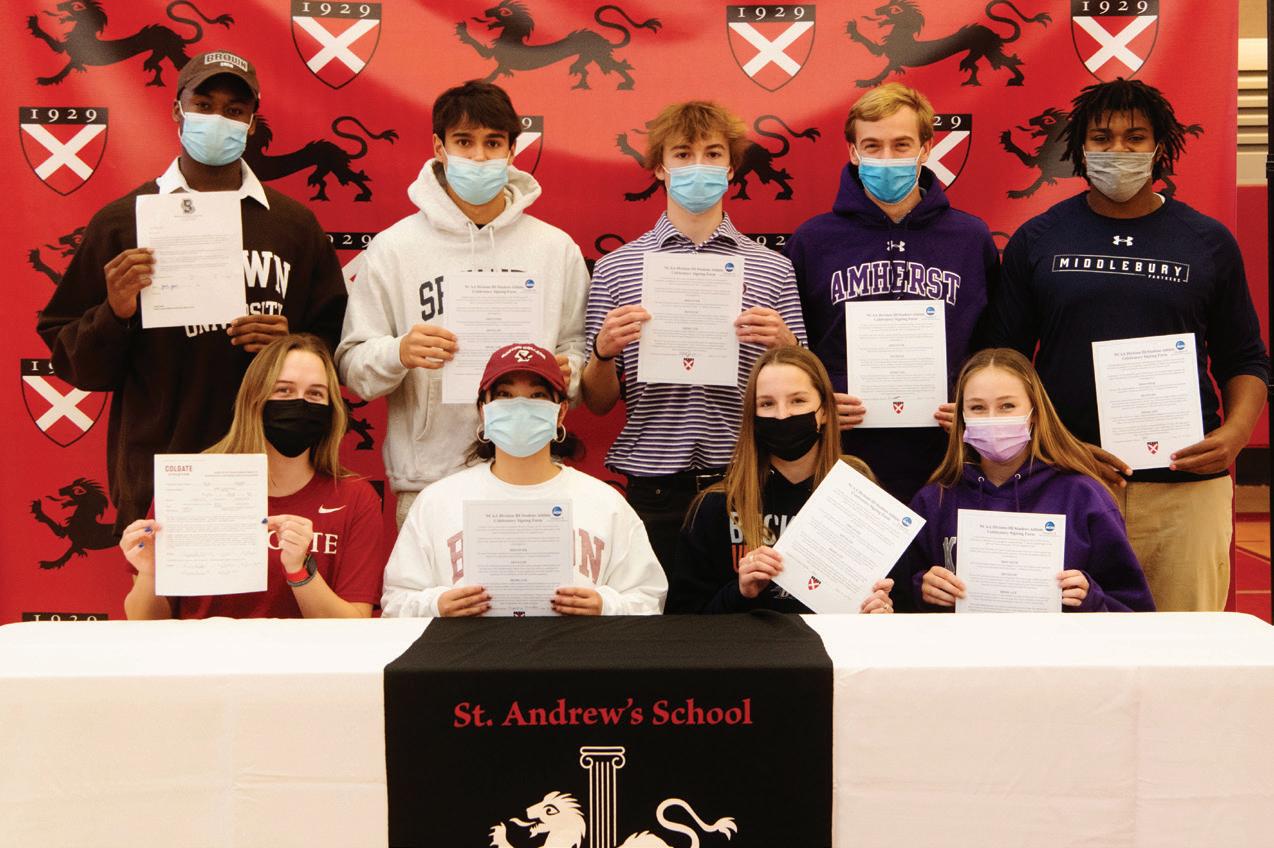
WILLIAM: I have learned how to compete at the highest level and still have fun. When I was competing nationally during middle school I found the singleplayer nature of squash isolating. Although I love the sport, competing wasn’t enjoyable for me—but that changed for me at St. Andrew’s. Competing on St. Andrew’s squash team has completely changed my outlook on the sport. The closeness of the team has rekindled my love for the game, and pushed me to become a better player not just for myself, but for my teammates.
CLEO: My experience here has taught me how to be resilient when faced with hardships, and that a positive attitude and a smile can make any Erg piece a little bit easier. I have always loved being a part of a team and am so sad to be leaving St. Andrew’s, but am so excited to bring the energy to Bucknell. •
FALL 2022 19

The full-scale invasion of Ukraine began on Thursday, February 24, and in the weeks that followed, St. Andrew’s senior and Kyiv resident Zhenia Khalabadzhakh ’22 worked both on campus and off to fight for her country.
Unable to go home for Spring Break, Zhenia spent the recess at the home of her advisor, Director of Student Life Kristin Honsel P’24. She kept busy by speaking with middle school students at local schools—MOT Charter and St. Anne’s Episcopal School—where she shared Ukrainian history and her perspective on the war as a Ukrainian citizen. She has also organized, with the help of her classmate April Seo ’22, a t-shirt fundraiser for Nova Ukraine, an organization that provides humanitarian aid to Ukrainians. They’ve raised more than $1,500 for Nova Ukraine.
“I think the main problem for Ukrainians [living] internationally is this feeling of survivor guilt that we have,” Zhenia said. “It’s the idea of: ‘I’m not there, hence, I’m not helping.’ You feel bad for feeling safe. That’s the hard part of it, and that’s why a lot of Ukrainians abroad are so proactive—that’s a way for us to help Ukraine, but also it’s a way for us to sort of escape that feeling of guilt and feel like we’re making change, even if it’s on a very small scale. It’s just important for us as individuals, and it’s important for us as a nation, to be united and do whatever we can.”
First, she worked with SAGE Dining Services to organize a Wednesday lunch of traditional Ukrainian dishes using recipes from her family, including borshch (a beet soup, see page 36 for that particular recipe); varenyky (a type of pierogi that her family makes together by hand); and borshch (Ukrainian apple cake). Then, for that evening’s chapel service, the school community dressed in yellow and blue—the colors of the Ukrainian flag—and gathered in the chapel to sing Ukrainian hymns and folksongs, and Zhenia shared a moving talk on the unity and bravery of Ukranians not just in this moment, but throughout the history of her country. Although offerings are not typically collected at Wednesday night chapel, baskets were passed during the vigil with all proceeds going to Razom, a Ukrainian
FIGHTING FOR UKRAINE, ALL THE WAY FROM DELAWARE
NGO that is providing relief inside the country; the school community raised more than $1,000 for Razom through the offering.
She reflected on her feelings immediately following Russia’s invasion of Ukraine: “I think the first couple of days everyone was in shock. And then it kind of ‘clicked’ and you realize, ‘Okay, me crying here [in the United States] is not really helpful, so I should do something. Anything.”
With her classmates back on campus following the Spring Recess, Zhenia then set about organizing a campus vigil for Ukraine.
“The Ukrainian coat of arms has a word encrypted in it,” Zhenia said in her chapel talk. “The word is volia. Interestingly, it can be translated in two ways: ‘freedom’ and ‘will.’ Ukrainians as a nation know that there is no freedom without the will and no will without freedom. We know that we need to fight for our freedom. And if history wants us to show how brave and united we are once again, we will do it.”
Zhenia came to St. Andrew’s through the Ukraine Global Scholars program, an almost entirely volunteer-run organization that connects Ukrainian students “of modest means” with scholarship opportunities at top colleges and high schools around the world. In turn, UGS
FALL 2022 21
students commit to returning to Ukraine after the completion of their education abroad to help lead—and now, rebuild—the country.
“In light of everything that’s going on, we understand more than ever that the kids who are 15 in Ukraine right now are the people who are going to be rebuilding Ukraine once the war is over,” Zhenia said. “That’s the long-term vision of UGS, and that’s how I see myself. Someone will need to do that, and the UGS kids are exactly the people who will be qualified to do that.” Like all UGS students and alumni, Zhenia volunteers for the organization and mentors upcoming students who are currently in the scholarship application
“What I personally love about this poem is that it reminds me how much responsibility there is, not only in the person who is committing the crime, but in the person who fails to speak up,” she explained on the Engelhard stage. “Russian aggression uses a lot of information and misinformation, and information is a weapon in the 21st century. By educating yourself, you support me, and you support my country.” The following weekend, she organized a Friday night viewing and discussion of the 2014 film “The Guide,” set in 1930s Soviet Ukraine, and collaborated with school librarians to put up a display of books on Ukrainian history and culture. She has been working in the library throughout the school year to refresh the school’s collection of Ukrainian and Eastern European history texts. “There was a ton about Russian history [in the library collection], but not enough about the history of smaller countries that were formed after the dissolution of the Soviet Union,” she says. “But they all have history before that— Ukraine, Belarus, Latvia, Estonia, all of these Baltic and Eastern European countries have a longer history than Russia wants us to have. Most people think that Ukraine was formed 30 years ago! I really hope there will be Ukrainian students after me [at St. Andrew’s] who can come to the library and say, ‘Oh my God, this is such a great collection about Ukrainian history.’”
pipeline.
Zhenia is the second UGS student to attend St. Andrew’s; preceding her was Robert Shyroian ’21, who currently attends the Illinois Institute of Technology.
Even before the invasion, Zhenia was working to share the story of her country with the St. Andrew’s community. At a School Meeting in early February, she read an excerpt of the English translation of “Europe was silent,” a poem written by Oleksandr Oles in 1931, just before the Holodomor, an artificial famine and genocide of the Ukrainian nation designed to suppress Ukrainian resistance to Soviet collectivization.
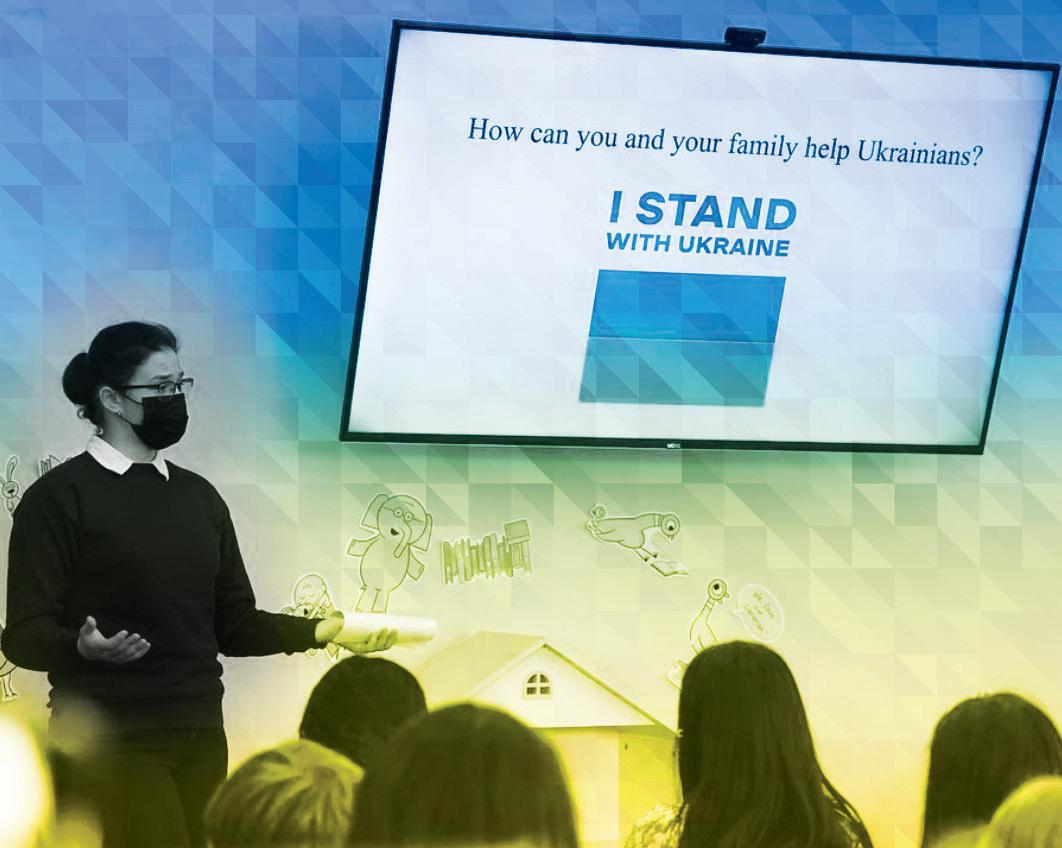
Zhenia recommended standwithukraine.how as an excellent resource for ways to help and support Ukraine and its citizens—organizations that need donations, letter-writing templates, information on rallies and marches, and so forth. “When you want to donate somewhere, it’s very important to seek out what Ukrainians might want you to donate to, rather than just donating somewhere and feeling good about yourself,” Zhenia noted. “We are asking you to donate to Ukraine, and to the army, not because we want to go and conquer Moscow, but because we want our land back. If Russia stops fighting, there will be peace. But if Ukraine stops fighting—there will be no Ukraine.” •
Zhenia’s fundraiser is still open; you can purchase a t-shirt or sweatshirt at bonfire.com/i-standwith-ua/. You can also listen to Zhenia’s chapel talk in full at standrews-de.org/talks
SAS / ST. ANDREW’S MAGAZINE 22 / TALK OF THE T-DOCK


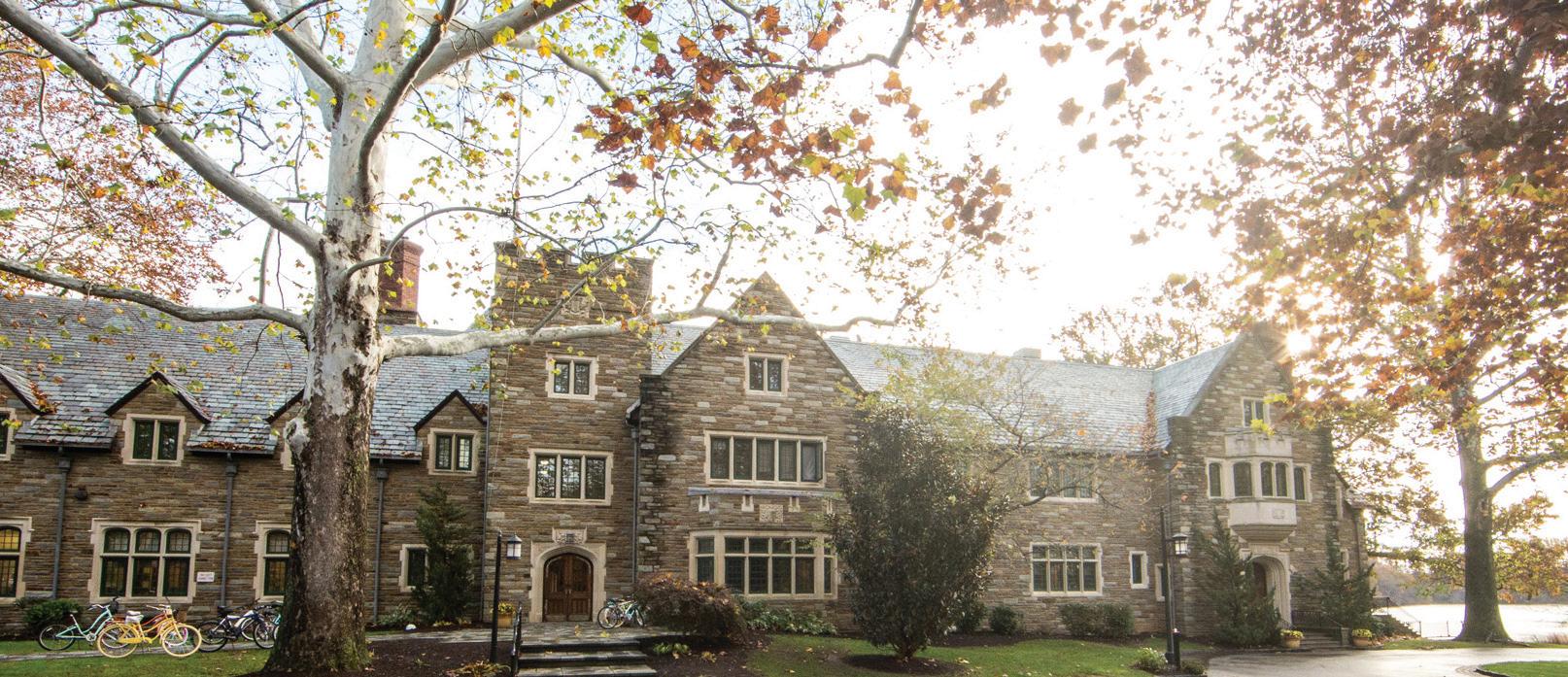
UPCOMING EVENTS FALL 2022 OPENING DAY PARENTS WEEKEND HOMECOMING WEEKEND SERVICE OF LESSONS & CAROLS SEPTEMBER 4 OCTOBER 28 ‑ 30 NOVEMBER 11 ‑ 12 DECEMBER 11 For more info on all events, visit standrews-de.org/ calendar
Forestry Forage
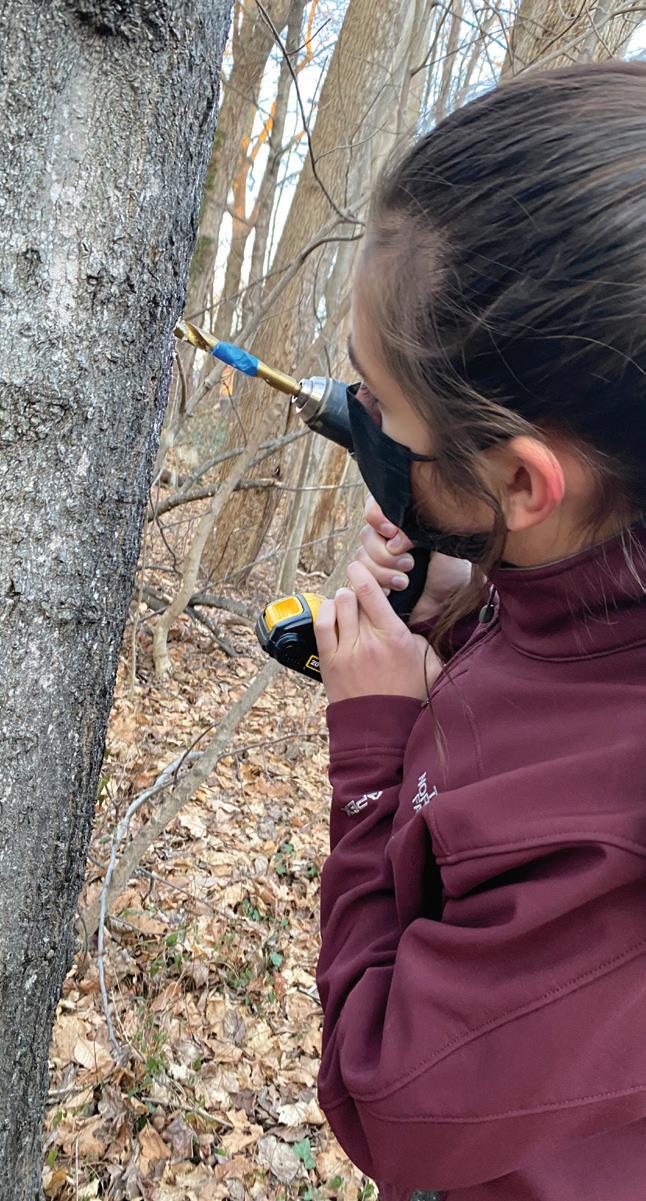
Biology teacher Dan O’Connell spent the winter reviving the school’s long-standing forestry program. Students who signed up for this afternoon activity tackled trail construction and maintenance; woodworking projects, building two benches and a picnic table; invasive plant removal; maple sap collection; tree propagation and planting; and, of course, some hiking.
“There are so many things that students get from the physical work we do in Forestry,” O’Connell said. “Sometimes our work required that they engage in group problem-solving and teamwork. I encourage them to see that they don't need expert instructions. They can make mistakes, regroup, and figure out problems themselves. Another goal of this program was to deepen the relationships students have with our environment. We saw almost every corner of campus— from the New Forest, to the eastside woods, to the land behind Noxon House and the woods south of Silver Lake. We spent a lot of time battling invasive plants, and because they needed to learn which plants to cut and which to leave-be, they learned how to identify a wide range of plants. We talked about how we each have a relationship with the natural world. Like any relationship, it improves with care and attention.”
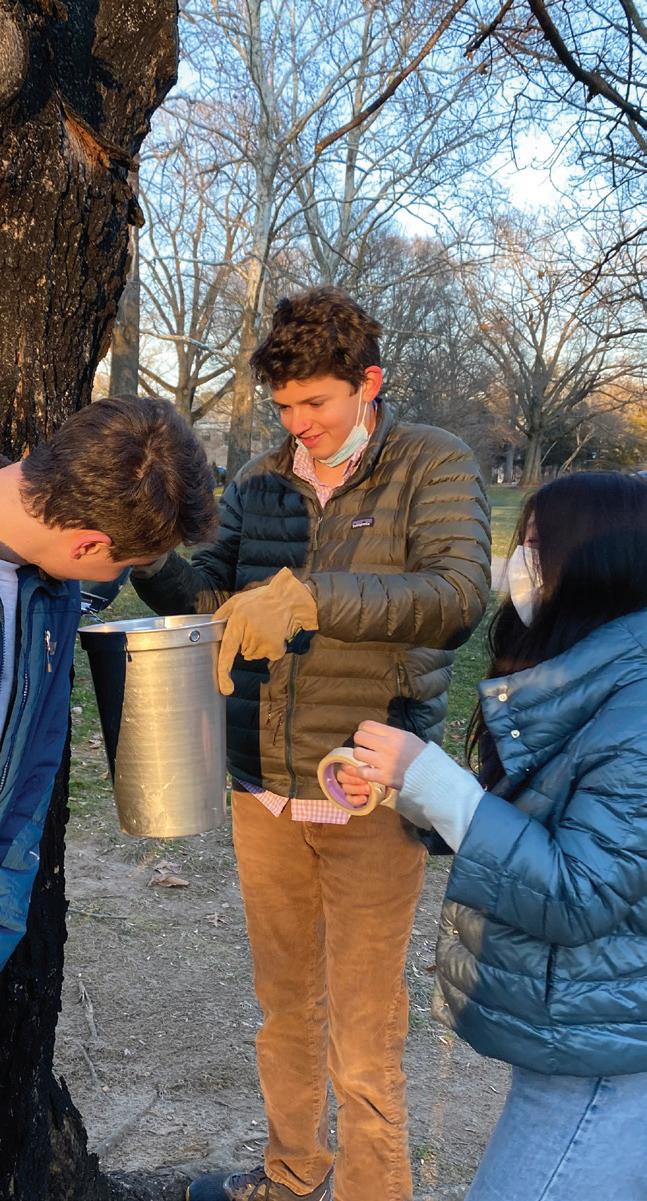

SAS / ST. ANDREW’S MAGAZINE 24 / TALK OF THE T-DOCK
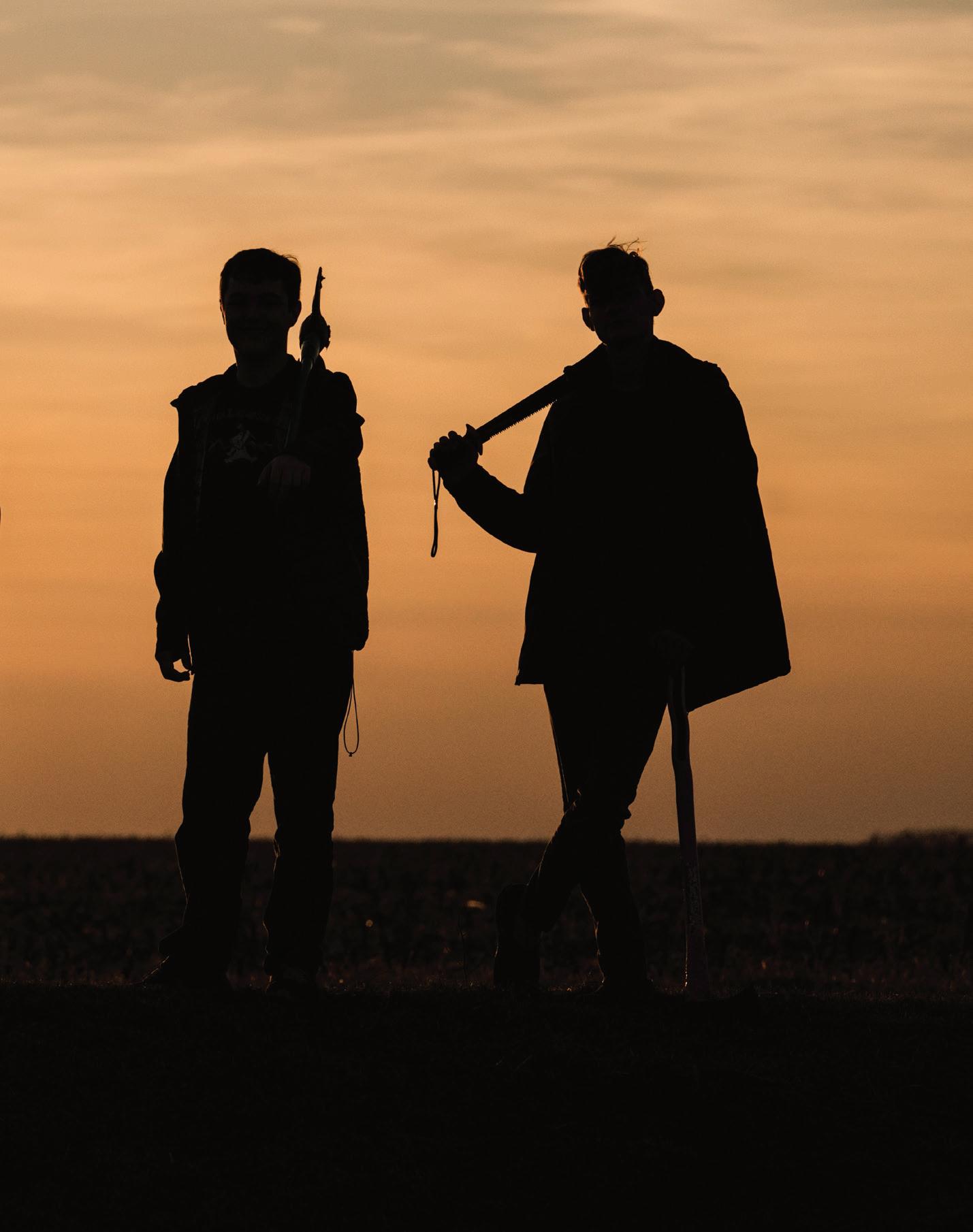
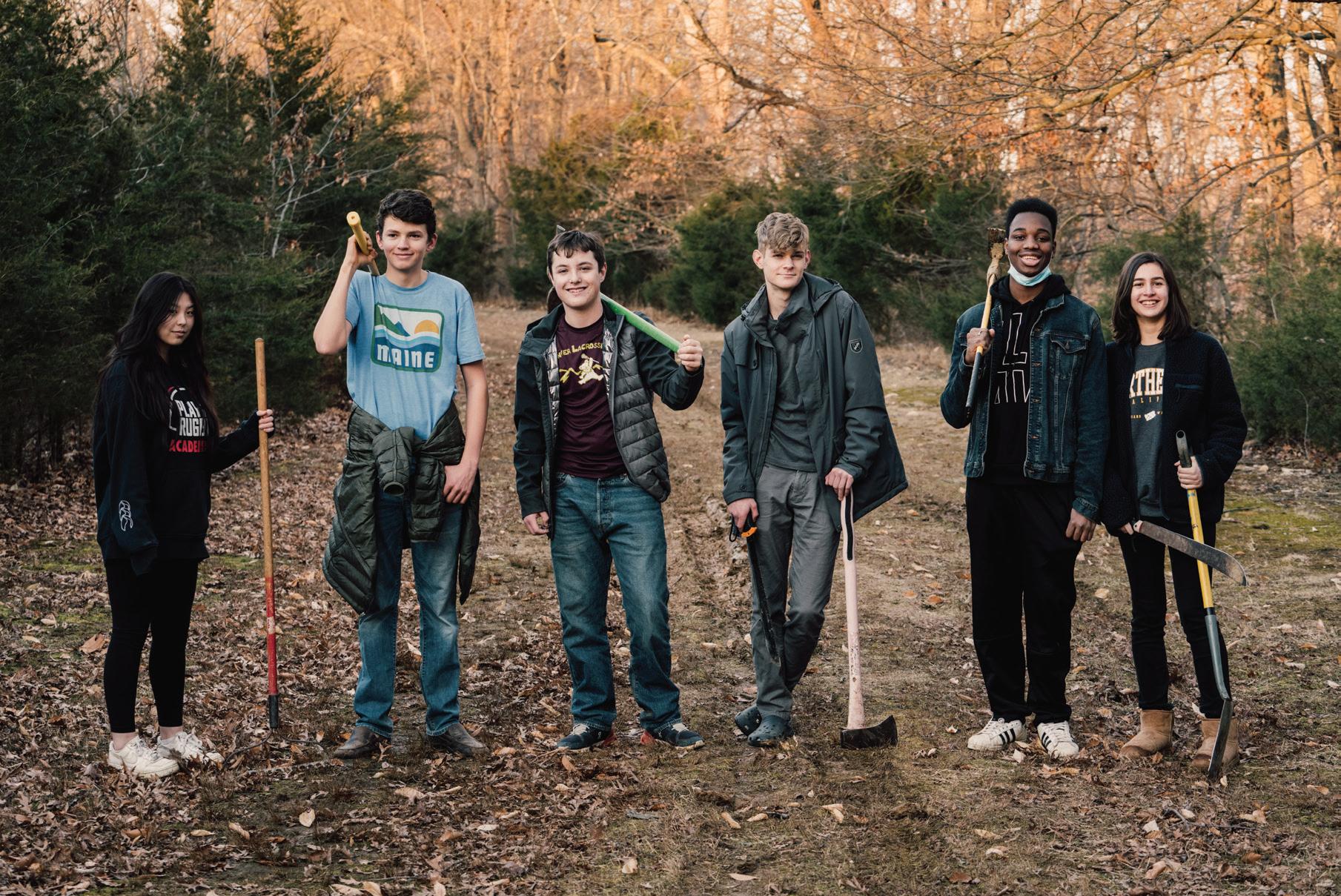
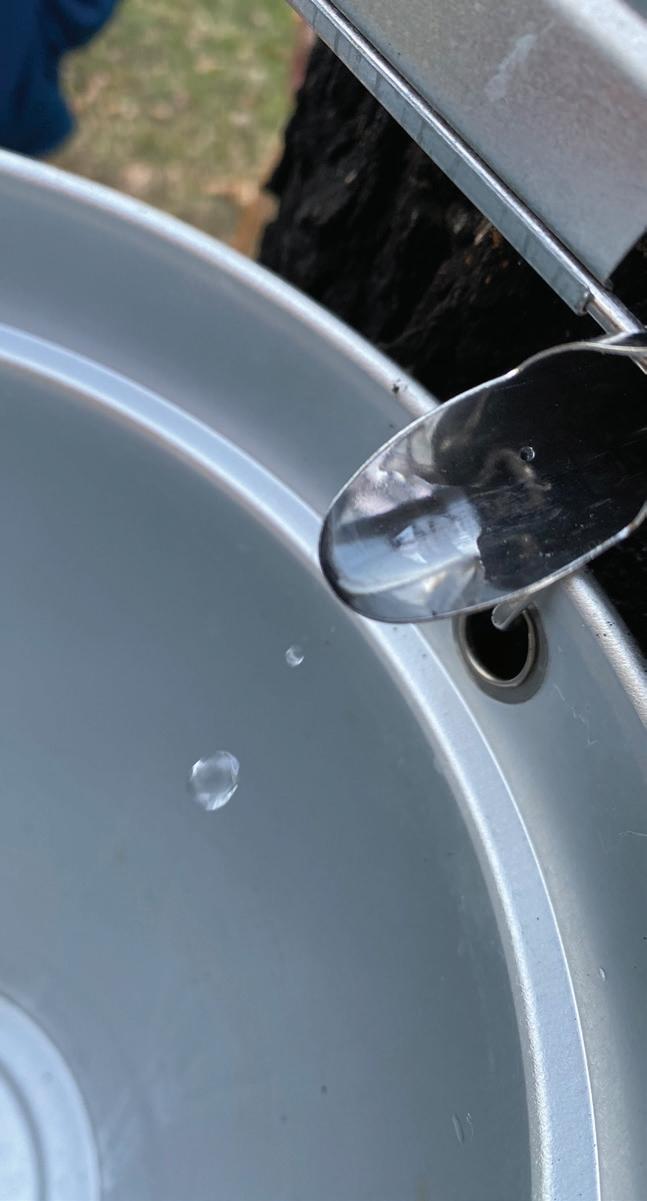

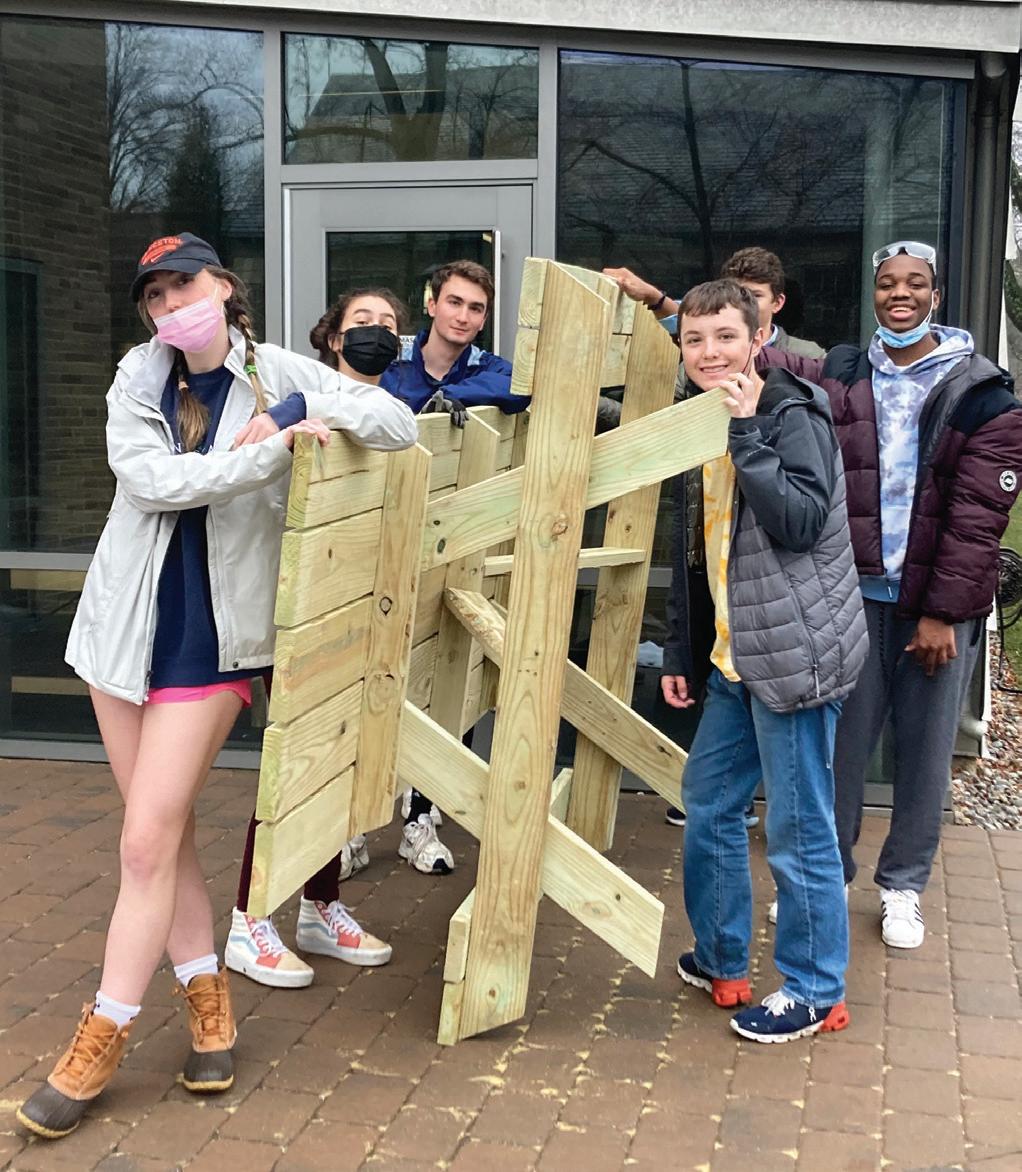
FALL 2022
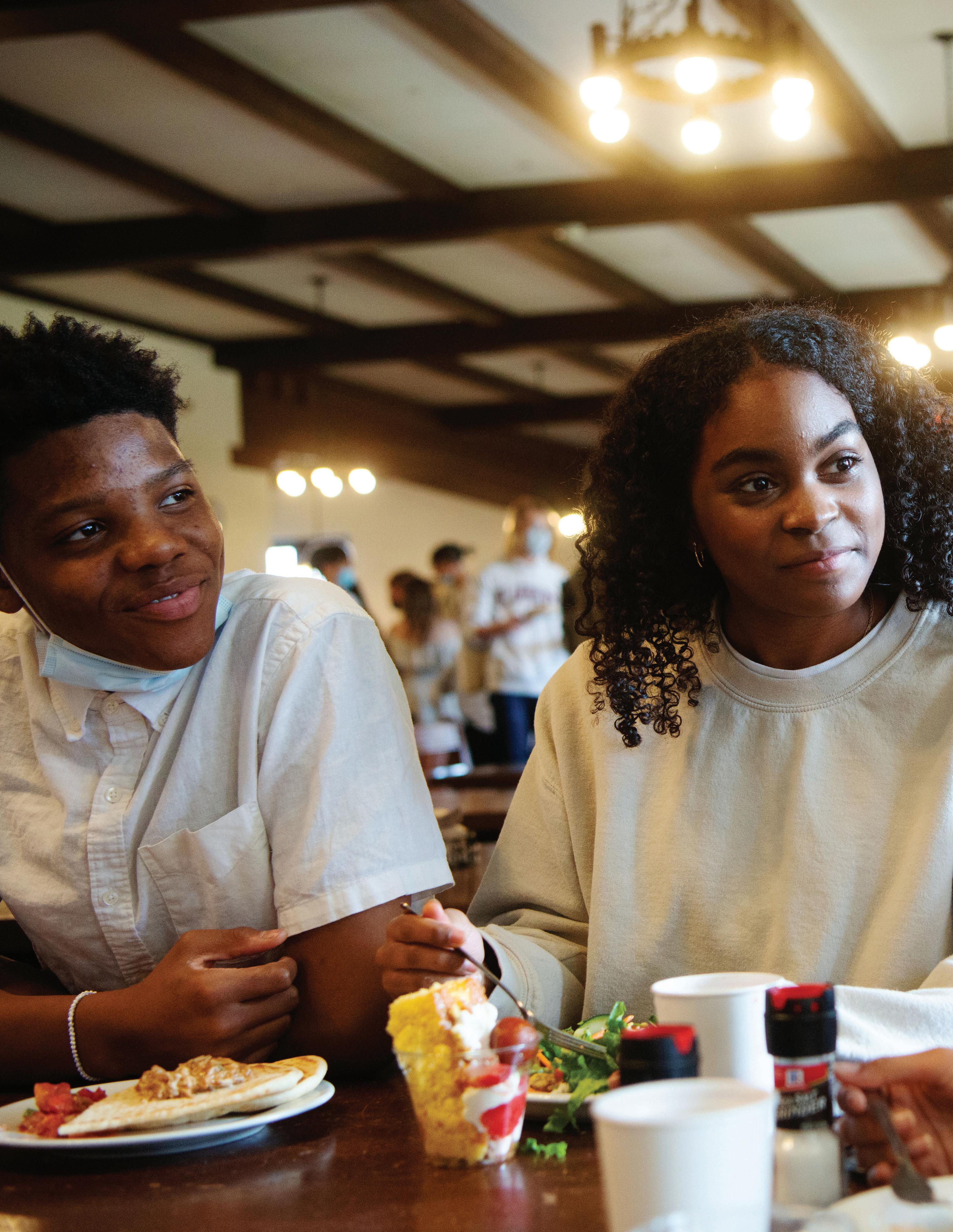
ST. ANDREW’S MAGAZINE

“Restaurants are not for the faint of heart, but the way food brings people together is special.”
—GRAHAM WORTH ’01

/ FEATURE-
Show Up, Work Clean, Ask Questions
A conversation with chef and cookbook author
Gregory Gourdet
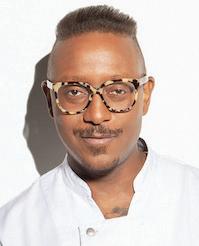
’93
In our second installment of If These Walls Could Talk—in which current students interview an alumnus who previously resided in their dorm room or in their dorm—seniors Danny Huang ’22 and Hunter Melton ’22 interview acclaimed chef and cookbook author Gregory Gourdet ’93. Gregory’s restaurant Kann opened in Portland, Oregon this August, and his first cookbook, Everyone’s Table: Global Recipes for Modern Health, won a James Beard Foundation Book Award this June. You may know him from Top Chef; he was the runner-up on season 12 of that show, which aired in 2015, and has also competed on Top Chef: All Stars.

Danny, Hunter, and Gregory all had the great privilege of living on Baum Corridor during their respective senior years at St. Andrew’s. They chatted over Zoom about their St. Andrew’s experiences and Gregory’s career in restaurants and his goals for the future.

FALL 2022 29
Danny Huang ’23 Hong Kong
Hunter Melton ’22 Farmville, VA
SHOW UP, WORK CLEAN, ASK QUESTIONS /
Gregory Gourdet ’93 originally from Queens, NY; now resides in Portland, OR
DANNY: I’m curious what brought you to St. Andrew’s.
GREGORY: My parents are from Haiti. They moved to America to pursue education, seek more opportunities, and start a family. So they always just wanted the best for us. We didn’t grow up in the worst neighborhood by any means, but we didn’t have the best schools. I was in Prep for Prep, which is a program that prepares young people of color for private school and boarding school. I got into St. Andrew’s, and it turned out to be the perfect school for me.
HUNTER: I’m trying to make a timeline in my head. We currently have the panel ceilings and the carpeted floor on Baum. Was that a thing when you were here? Because they don’t have it in Dead Poets Society. They have nice hardwood floors.
GREGORY: I don’t think we had carpet… but that was 30 years ago. Our 30th Reunion is next summer. There’s fourteen of us on a group chat 30 years later, guys. We talk to each other literally every day, and we mostly just talk smack and joke about high school. So this is what you have to look forward to: thirty years down the line, you’re still going to be talking about St. Andrew’s.
HUNTER: When you lived on Baum, were you in a triple, a double, a single?
GREGORY: I was in a double, and I roomed with Nate Jenkins [’93]—we roomed for three years together. We bonded early over an accident. I’d never played football in my entire live. It was the first day of full pads in football camp freshman year. Nate tackled me and I went down so hard I broke my leg. I had a full leg cast and was on crutches for weeks. Everyone called me Peg Leg Greg for the first few months of school. But we got through it, and we were very, very close friends. Those memories never fade.
HUNTER: What made the roommate relationship work?
GREGORY: I don’t know…. We were an odd couple because he was from Goodland, Kansas—a super-small town—and I was from Queens. So we could not have been more different, but we just bonded. We ended up listening to the same music. I remember when I went to visit him in Kansas for his wedding, I saw tumbleweed for the first time.
HUNTER: Danny’s from Hong Kong and New York, and I’m from a place that’s literally called Farmville, Virginia. So we have similar differences in background.
GREGORY: Yes! SAS brings us together from all over the world.
DANNY: Do you have any vivid memories of living on Baum your senior year?
GREGORY: I mean… we had fun. We stayed up late. We smoked cigarettes. I don’t want to be a bad example.
DANNY: We don’t smoke cigarettes.
GREGORY: No one smokes at school? I’m confused.
SAS / ST. ANDREW’S MAGAZINE 30
/ FEATURE
One of my biggest takeaways from St. Andrew’s, honestly, is my appreciation for nature and the desire to live somewhere that’s kind of rural and quiet and green. I love to be in the woods for hours and hours. I love to hike.
DANNY: We’re good with preventing [the use of] alcohol and drugs—we hold each other accountable. The seniors set an example.
GREGORY: I love it! That’s really great. Everyone’s healthier. What’s school been like for you two? Have you enjoyed your time there?
HUNTER: Yeah. I feel like the main thing about St. Andrew’s is that you get to work really hard at things you actually like to do. You find out your interests and you get really good at them.
GREGORY: Honestly, when I left St. Andrew’s, I didn’t really know what I wanted to do. I thought I wanted to go to medical school—my parents worked in hospitals and it was just a classic immigrant story: “Hey, go be a doctor.” So I went to NYU and entered a pre-med program. But that was not what I wanted to do. It took me a few years, but eventually I discovered what I was supposed to do. So no pressure to figure it out right away, boys. Unless you think you have. Then that’s good.
DANNY: You ultimately majored in French, right?
GREGORY: I did pre-med at NYU for one year, and then I decided I didn’t want to be in the city, and I thank St. Andrew’s for that. One of my biggest takeaways from St. Andrew’s, honestly, is my appreciation for nature and the desire to live somewhere that’s kind of rural and quiet and green. I love to be in the woods for hours and hours. I love to hike. I love visiting New York, but I’m so much happier in Portland, because it’s super-green here.
[After my first year of college] I moved out to Montana with five of my friends from St. Andrew’s. We all went to different schools for college, and we missed each other so much that we all decided to live together for the summer, which was pure debauchery. But I ended up staying out there for school. I thought I wanted to do wildlife biology, and it was while I was in those classes that I started cooking for myself and feeding myself for the first time. You don’t do that at St. Andrew’s, and I lived at home in Queens during my freshman year at NYU. That was when I decided that this culinary stuff was something I was interested in. I mean, this was pre-TV cooking shows—cooking wasn’t
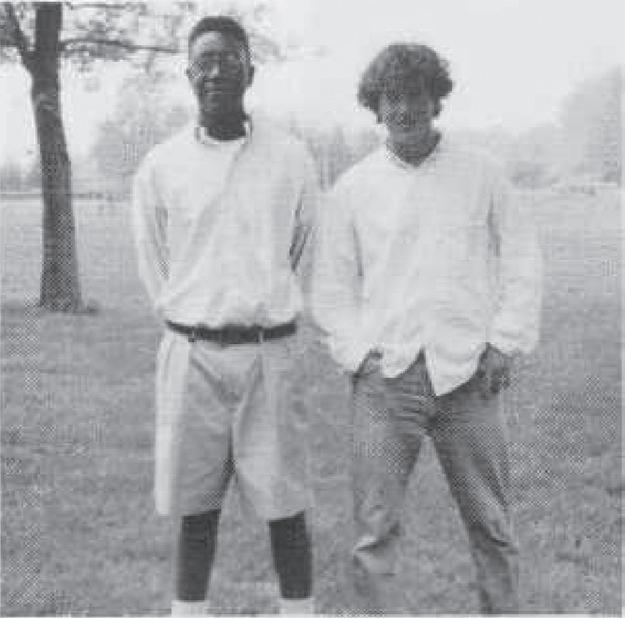
as glamorized or popular or even as known. I didn’t even know what culinary school was at the time. But once I realized that was a thing you could do, I tried to graduate from Montana as quickly as possible, and I had a bunch of French credits. Then finally I went to the Culinary Institute of America. I was basically in college for seven years, with culinary school at the end of it. It all worked out.
DANNY: Were your parents supportive of you, when you decided to go into cooking?
GREGORY: My parents were extremely supportive… I literally put them through hell. I got suspended from St. Andrew’s sophomore year for a bunch of stuff that we did off campus. It was a big mess. Then I kept changing schools. They didn’t know what to do with me. They were like, “Just please graduate from something.” But they were always, always supportive. I appreciate that because it took me quite a few years to figure out who I was, and now I get to pay them back by being the person that I am and by being a better son.
HUNTER: You’ve reached an extraordinarily high level in what you love to do, and you are reaching higher still. What’s motivated you between now and when you first started out, that’s helped you bridge the gap between those two moments?
GREGORY: One, I’m extremely goal-driven, and I’m very results driven as well. I think it’s important that you never compare yourself to other people, but I also think it’s extremely important to set goals for yourself. And I always do. I’m a workaholic—I’m pretty open about being in recovery, and I definitely have an addictive personality. I know I’ve replaced a lot of my behavior patterns with working.
Two, my early mentors were all extremely successful people. My first chef, Jean-Georges Vongerichten, had twenty restaurants and Michelin stars and four stars from The New York Times when I was a young cook working for him. There was always a high level of excellence that I was exposed to and just always believed in. I do have an outgoing personality, and I tend to latch onto
FALL 2022 31
SHOW UP, WORK CLEAN, ASK QUESTIONS /
GREGORY AND ROOMMATE NATE JENKINS ’93
my mentors—“Hey, you have to teach me all this stuff, and I have all these questions.” It can be harder if you’re not the loudest person in the room, and you have to fight for attention. Greg Brainin is JeanGeorge’s main recipe developer, his right-hand man—he’s really my mentor. We were just texting today.
Trying to get the most out of life is something I’m extremely passionate about. I always love to learn more. I love what I do so much that it keeps me up at night. And when I started cooking twentysomething years ago, I never really knew how many fields I could tap into as a chef. I never really thought I could be on cooking shows, and be teaching people how to cook, and working with the Salmon Commission and the Dungeness Crab Commission, and working with farmers to grow certain things, and helping young cooks achieve their goals and dreams. There’s so many facets of life I get to touch on. That’s the most exciting thing for me, and it keeps me extremely busy.
HUNTER: Can you talk a little bit about your cookbook? Its subtitle is “Global Recipes for Modern Health”—what do you think are the most important steps we can take toward being healthier and more sustainable in our cooking and food consumption?

GREGORY: The number one thing we need to think about is that food is there for nourishment. If we can think of food as a way to source vitamins and minerals and antioxidants and all the things we need to feel good and go about our day and our lives, I think that can really help inform and inspire the way that we eat.
For me, as someone who battered my body for many, many years, I’m a total health freak now. I eat food to fuel myself, because I work a lot, and sometimes I don’t sleep a lot. I just want to feel good, and food helps me feel good. Of course, there are the treats, the celebratory things, and so many great dishes that maybe aren’t that healthy for you, but our families make them, and it’s more about being together. Food is something that helps bring us together and be convivial and jovial and familial. So, you have to find a balance there.
In my cookbook, I try to show that there are all these amazing foods and ingredients and recipes from all over the world that are healthful, easy to make, and delicious. With a little bit of effort, and focusing on buying the right things—lots of vegetables, wellsourced meats and fish—we can all live longer lives.
DANNY: Take me back to Jean-Georges. How do you pronounce that last name—it’s not French, is it?
GREGORY: It is. He’s from Alsace, so it’s, like, French-German. It’s Von-grr-riche-tin.
DANNY: I take French here, so I was wondering how you pronounced that. I started this club called Crepes and Conversation, where we make crepes and talk in French—
HUNTER: I was not invited because I don’t speak French. But I love crepes.
DANNY: Open to French students only, unfortunately.
HUNTER: I mostly just sneak into faculty houses and cook, because I really like to eat.
GREGORY: You guys cook at school? What do you like to cook?
SAS / ST. ANDREW’S MAGAZINE 32
/ FEATURE
GREGORY’S FIRST COOKBOOK, PUBLISHED IN MAY 2021, WON A JAMES BEARD AWARD THIS JUNE.
HUNTER: Sometimes you can get a teacher to let you into their kitchen. For prom, I got to make some shrimp curry.
DANNY: I make a really mean medium rare steak. And I’m also a professional instant ramen chef.
GREGORY: Oh yeah. As is anyone who goes to boarding school.
DANNY: What are some of the most important lessons you took away from cooking under JeanGeorges?
GREGORY: One, it’s important to believe in yourself. Two, ask for the things that you want. And three, if you don’t get the things that you want, just really try to understand and ask what it’s going to take to get you to the next level, and work on that.
Even though I had a lot of ups and downs—I worked there at the height of my addiction issues—I was still able to rise up through the ranks. I think one of the most important components of success in a kitchen is always showing up on time, if not a few minutes early, and working clean. Jean-Georges always said that cleaning is 50% of cooking.
If you truly put in the work, the opportunities will come. Sometimes things don’t happen quickly, but if you’re consistent and you show up and you ask questions, I do not believe there is a glass ceiling.
DANNY: How would you say the kitchen atmosphere differs from atmospheres in other workplaces? It seems like it’s more… high-stakes.
GREGORY: Historically, kitchens have been lawless spaces—the chef is drunk, he’s throwing pots and pans, and there’s no system of checks and balances. It’s gone on for quite some time. I am grateful that I didn’t have any of those experiences when I was coming up. Sometimes fine dining gets a bad rap, but I had a really wonderful experience when I worked for Jean-Georges. He’s super-chill, and I always felt supported and nurtured, even as someone coming up the ranks as a gay person of color in a very, very white space. I’m lucky. I know plenty of people just like me who have tried to
succeed in these spaces, and have not been given the same opportunities.
There has very much so been a history of sexism within these spaces. Women have traditionally been unfairly treated in kitchens, and unfairly paid. There’s been abuse of employees—the expectation that you will work off the clock, for example. I think over the past five to seven years, there’s been a reckoning brewing for restaurants, and a lot of that came to a head when the world shut down. Now in restaurants and kitchens we’re talking about worklife balance and equity and mental health.
HUNTER: Would you say your perspective of the kitchen changed when you were no longer working under someone, but instead, you are now at the top?
GREGORY: I mean, I’ve pretty much been working for someone for my entire career, until right now. Even in my last job, I worked as the executive chef at a hotel restaurant here in Portland, and I was there for ten years. I had a lot of free range and a lot of trust with the company. But I got to the point where I decided I wanted to do my own thing, and now I’m in the driver’s seat. It’s exciting and a little scary as well.
HUNTER: What’s the personality of your new restaurant?
GREGORY: Kann is a wood-fired Haitian restaurant. It is inspired by my Haitian heritage and will honor the traditional recipes and ingredients and dishes of Haiti, but also honor Oregon
FALL 2022 33
SHOW UP, WORK CLEAN, ASK QUESTIONS /
I think one of the most important [components of success in a kitchen] is always showing up on time, if not a few minutes early, and working clean.... If you truly put in the work, the opportunities will come.
GREGORY’S FAVORITES IN LOS ANGELES
“a
DAYBIRD
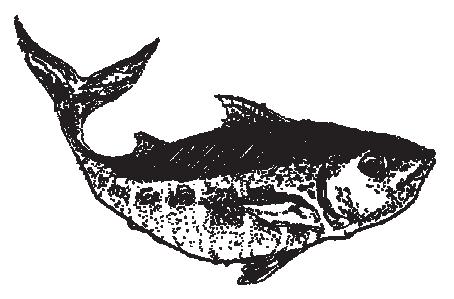

bounty and seasonal ingredients from our farmlands, oceans, and mountains. There will be some Pan-Caribbean influences as well. When people leave the restaurant, I want them to have a clear understanding of at least a handful of traditional Haitian dishes. I want to elevate Haitian cuisine and the story that surrounds Haiti, because Haiti gets a lot of bad press, and it’s a country that has struggled quite a bit in past decades. But all my memories of living in Haiti when I was kid, or visiting there with my family when I was older, all my memories of my family in Queens—they’re all just beautiful memories with a lot of food, my mom cooking, huge lavish feasts every Sunday. Haiti was the first country to abolish slavery and also the world’s first Black republic. Haitian history is so rich. These are the stories I want to tell.
One of the coolest parts of being able to tap into my family’s culture with this restaurant is working with my parents on so many things. I’ve done pop-up dinners in Portland with my mom. I write a lot of things on my menus in Haitian Creole, and I always call my dad to ask him if the spelling is proper. It’s a pretty cool thing to have their help and their knowledge.
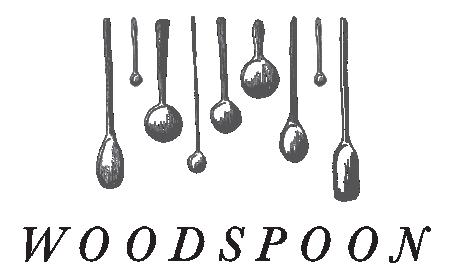
But to have a great restaurant and a great business is more than just making great food or being financially successful. It’s really about the holistic being of the entire system. Are the employees happy? Is there work-life balance? Is the restaurant sustainable in terms of how it impacts the environment? Are we supporting small farms and tapping into our local resources? Are we sharing the story of the culture that’s behind the food properly? Am I sure that everyone on the team understands that I want them to advance? I don’t want them to stay in their position forever, unless that’s what they want. It is so important to me that at Kann, we have equity. We are splitting tips equally amongst all the employees. We have women in all positions of kitchen leadership. I’m actively seeking a diverse team.
I mentioned earlier about how it is easier to succeed in restaurants if you’re the loudest person in the room. But that really shouldn’t be the system. Everyone should have an equal opportunity to get to the top, even if you’re the person who just works quietly in the corner. So I want to have plenty of conversations at Kann about making sure people understand that they can succeed. That’s how you create equity in a workspace. J
SAS / ST. ANDREW’S MAGAZINE 34
/ FEATURE
Danny, who will attend USC in the fall, asked Gregory for some restaurant recommendations in Los Angeles:
fried chicken concept run by my friend Mei Lin”
KATO
a Michelin-starred Taiwanese tasting menu restaurant
WOODSPOON a rustic Brazilian restaurant “right downtown”
INGREDIENT LIST
¾ cup avocado oil
½ cup fish sauce
1 tablespoon plus 2 teaspoons kosher salt
4 lemongrass stalks, trimmed, bruised, then thinly sliced
1 small bunch cilantro, stems roughly chopped, leaves reserved for garnish
¼ cup roughly chopped palm sugar or coconut sugar
¼ cup whole black peppercorns
3 tablespoons coconut aminos
2 tablespoons coriander seeds
8 garlic cloves
6 fresh Thai chiles, stemmed
4 to 4½ pounds bone-in, skin-on chicken parts
GREGORY’S FAVORITE GRILLED CHICKEN
MAKE THE MARINADE
In a blender, combine the avocado oil, the fish sauce, 1 tablespoon of the kosher salt, the lemongrass, cilantro stems and lower leaves, palm sugar, black peppercorns, coconut aminos, coriander seeds, garlic cloves, garlic, and chiles. Puree to a coarse puree, about 2 minutes.
Season the chicken all over with the remaining 2 teaspoons of salt, put it in a large container along with the lemongrass mixture, and toss to coat well, making sure the marinade gets into the nooks and crannies. Cover and refrigerate for at least 12 hours and up to 3 days.
PREPARE THE GRILL
When it’s time to cook chicken, prepare a grill so there’s a high-heat area and a medium-heat area. Remove the chicken from the marinade, giving each piece a brief shake and reserving the marinade, and transfer the chicken to a large plate or tray. Pour the reserved marinade into a small pot, bring it to a boil over high heat, and turn off the heat. You’ll use it in a bit to glaze the chicken.
GRILL THE CHICKEN
Grill the chicken, skin side down and uncovered, on the hot area until it’s charred and the skin is crispy, about 4 minutes. Flip the chicken as you move it to the area of medium heat, baste with some of leftover marinade, then cover the grill. Cook until the breasts are just cooked through (I prefer 150ºF to the standard 165ºF), 20 to 25 minutes, and the drum and thigh meat pulls easily from bone, 25 to 30 minutes. When chicken is ready, flip back to skin side down and cook for about 30 seconds more, rubbing any remaining marinade on the meat side as the skin side crisps up.
REST & SERVE!
Let the chicken rest for 5 minutes. Serve, garnishing with the remaining cilantro. •
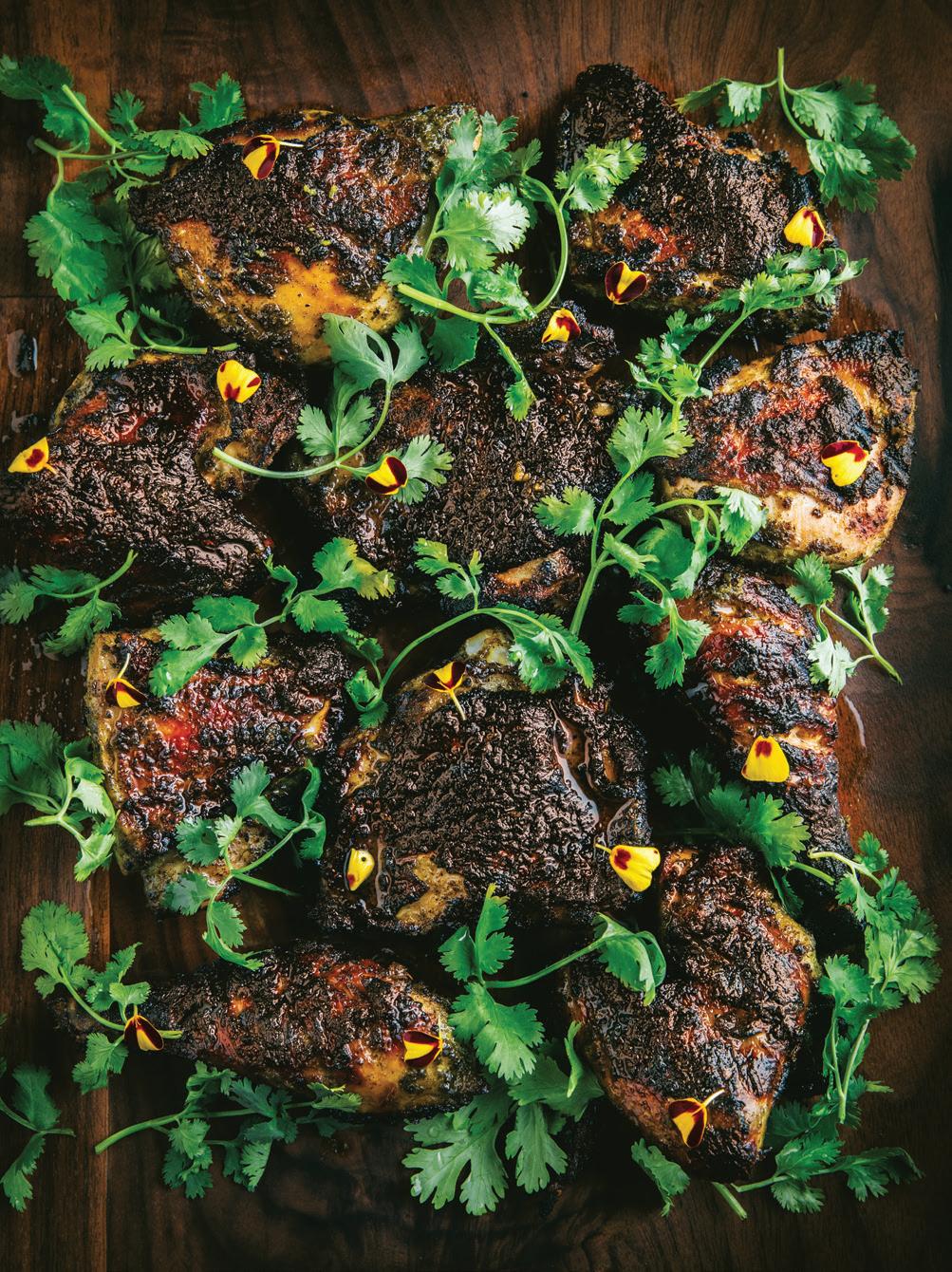
FALL 2022 35 SHOW UP, WORK CLEAN, ASK QUESTIONS /
REPRINTED FROM EVERYONE’S TABLE: GLOBAL RECIPES FOR MODERN HEALTH.
GATHER
PRIORY ALTAR BREAD
INGREDIENT LIST
1 PACKET YEAST
1 ½ T OLIVE OIL
3 T HONEY
½ t SEA SALT
4-5 CUPS WHOLE WHEAT FLOUR
PROOF THE YEAST
Proof one packet of yeast in 1 cup of warm water for 5 minutes.
MIX THE DOUGH & LET RISE
Once the yeast mixture has proofed, mix it with the next 3 ingredients in a bowl. Gradually add flour, 1 cup at a time. Using a mixer with a bread hook is ideal since you can leave the dough pretty sticky which leads to a moister final loaf. Once the dough is in a sticky ball put in a large bowl and let rise for 1 hour.
KNEAD THE DOUGH & BAKE
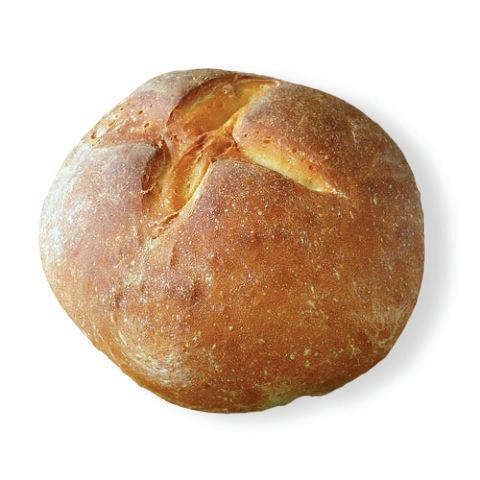
After dough has risen, preheat the oven to 400ºF. Flour a hard surface, put dough on it, and knead for 2-3 minutes. At this point I cut it into discs (6 inch diameter) and put crosses on top for easy “fractioning” at communion, and then bake for 10 minutes each. If using a loaf pan, cook for 20-25 minutes. Let cool and enjoy!
BOIL & CHOP
After peeling potatoes, carrots and beetroots, boil them in a large pot until they become almost done (but not fully; they will return to the pot later, so it's better to undercook). While cooking, chop cabbage and peppers.
MASH, GRATE, & SIMMER
When potatoes, carrots, and beetroots are almost ready, remove beets and carrots. Without removing potatoes from the pot, mash them. Grate beetroot and carrots and add them to the pot along with cabbage and peppers. Add salt and pepper to taste. Let it simmer for 45 minutes to 1 hour. Serve with sour cream and dill on top.
This recipe was given to me by Carol Kunz
P’81,’85 GP’10, wife of former St. Andrew’s Chaplain Carl Kunz. It is pretty simple—at this point I don't use a recipe but these approximations will work well. I try to get my honey from Beth Crook [Beth is a member of the SAS Tech team, and her family owns and operates Bohemia Apiary in Maryland] or Toby Kirk [SAS Facilities team member and school beekeeper]. For chapel, I use a smaller amount of flour so that it will not “crumb” when I break it up.
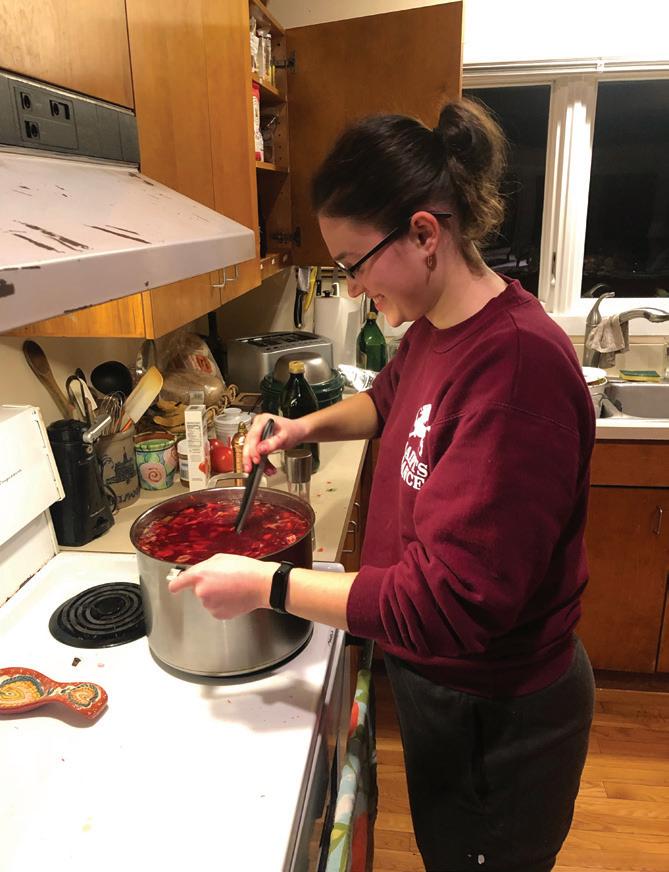 Chaplain Jay Hutchinson
Chaplain Jay Hutchinson
BORSHCH
INGREDIENT LIST
3-4 POTATOES, PEELED
3 CARROTS
4-5 BEETS
1 HEAD OF CABBAGE
1-2 PEPPERS
VEGETABLE OIL
SALT & PEPPER
SOUR CREAM & DILL
For Wednesday lunch on March 23, senior Zhenia Khalabadzhakh ’22 worked with SAGE Dining Services to organize a feast of traditional Ukrainian dishes. (Zhenia, who hails from Kyiv, Ukraine, spent the spring semester working to educate the SAS community on Ukrainian culture and history; you can read more about her efforts on page 23.) Here is Zhenia’s family recipe for borshch, a hearty beet soup. Recipe makes “a big pot,” says Zhenia.
SAS / ST. ANDREW’S MAGAZINE 36
/ FEATURE
Gregory cooked up so much inspiration that we couldn’t help but share our favorites, too.
HAMANTASCHEN
Jewish Affinity Group students baked hamantaschen with Head of School Joy McGrath ’92 at her house in March, to celebrate Purim. Here is the recipe they used, adapted from Classic Home Desserts by Richard Sax. Recipe makes about 2 dozen.
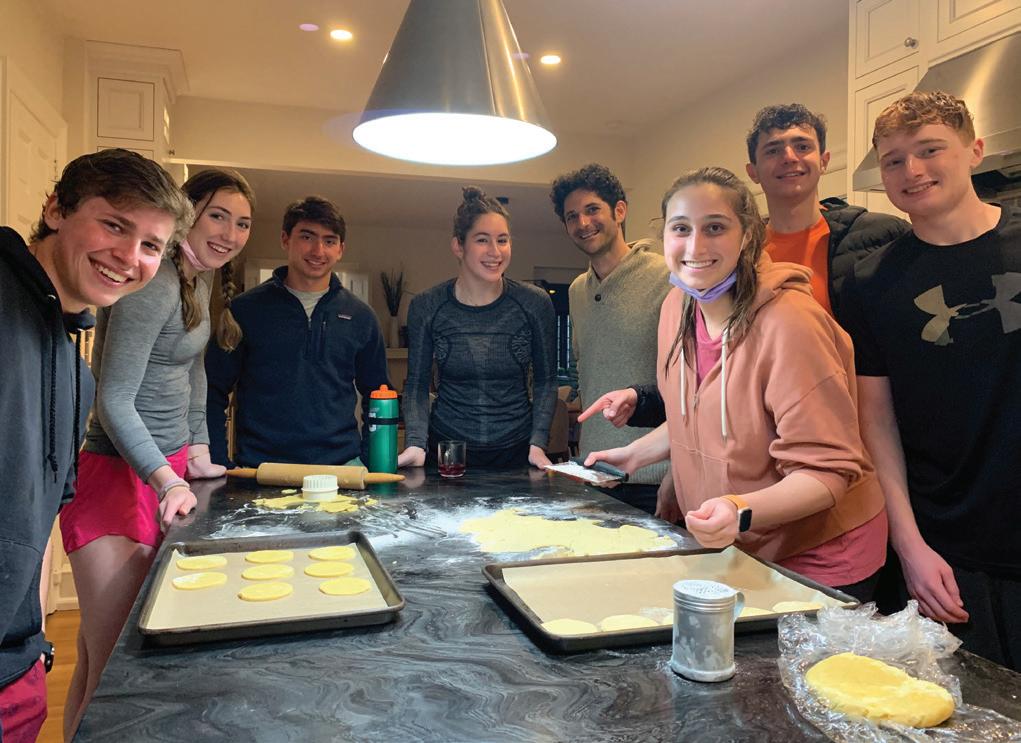
MIX & CHILL
With an electric mixer, cream together the butter, cream cheese, vanilla, and orange zest. Slowly beat in the sugar; beat in the egg. Add the flour, baking powder, and salt, and beat just until incorporated; do not overmix. Pat the dough into a disk; wrap in plastic or wax paper. Chill the dough for at least 30 minutes. Preheat the oven to 350º F. Lightly butter 2 baking sheets; set aside.
ROLL, FILL & PINCH
INGREDIENT LIST
¼ C UNSALTED BUTTER, SOFTENED
4 OZ (½ C) CREAM CHEESE, SOFTENED
½ t PURE VANILLA EXTRACT
GRATED ZEST OF 1 ORANGE
¾ C SUGAR
1 LARGE EGG
2 C ALL-PURPOSE FLOUR
1 t BAKING POWDER
PINCH SALT
1 C THICK RASPBERRY JAM OR OTHER FILLING
QUICHE IN A CUP

INGREDIENT LIST
1 EGG
1 ½ T MILK
¼ BAGEL, OR SIMILAR AMOUNT OF FRENCH BREAD
2 T CREAM CHEESE
½ SLICE PROSCUITTO OR HAM
FRESH THYME LEAVES OR FRESH CHOPPED CHIVES
DIJON MUSTARD
SALT & PEPPER
Roll out the dough on a lightly floured surface to a thickness of slightly more than 1/8 inch. Using a cutter or a saucer as a guide, cut the dough into four-inch rounds. With a pastry brush or a fingertip, brush the edges of each round lightly with cold water. Mound 2 level teaspoons of jam or other filling in the center of each circle of dough. The folding is easy if you picture an equilateral triangle within each circle of dough. Fold up about ¾ of an inch of dough at the bottom of the round, forming a straight, horizontal bottom to the triangle. Fold in about ¾ of an inch of dough on each side, forming a triangle with a point at the top. The dough will not meet in the center; the filling will show. Pinch together the edges of the dough at the 3 points of the triangle. Transfer the filled rounds carefully to the baking sheets.
BAKE & ENJOY!
Bake just until the hamantaschen are pale gold on top, 30 to 35 minutes. Cool on a wire rack. Serve at room temperature. These will keep well for up to 3 days.
BEAT THE EGGS
Beat egg and milk together with a fork in a coffee cup, adding salt and pepper to taste.
DRESS IT UP
Tear bread into dime-size pieces; stir in. Add cream cheese; stir in. Tear or cut prosciutto into small pieces; add to mixture. Sprinkle with thyme.
MICROWAVE & GARNISH
Microwave on high until done, about 1 minute 10 seconds. Garnish with mustard and fresh thyme or chives.
Reprinted from the December 11, 2013 issue of The Cardinal; that year’s editors ran a dorm-kitchen-friendly recipe in each issue.
FALL 2022
MAKING MOMENTS OF TOGETHERNESS
For many of us, in childhood, what our parents do for work is either shrouded in mystery, or profoundly uncool and uninteresting. Cleo Pahlmeyer ’01 fits into the latter category. Her father, Jayson Pahlmeyer, founded Pahlmeyer Winery in 1981 with business partner John Caldwell; they planted 55 acres of grapes in Napa Valley using vine cuttings smuggled out of France in a suitcase. Over the past four decades, Pahlmeyer vintages have become some of the country’s most well-regarded high-end wines.
As for Cleo, she had to relocate to London to learn what it was, exactly, that her father had been doing in his California vineyards for her entire life.
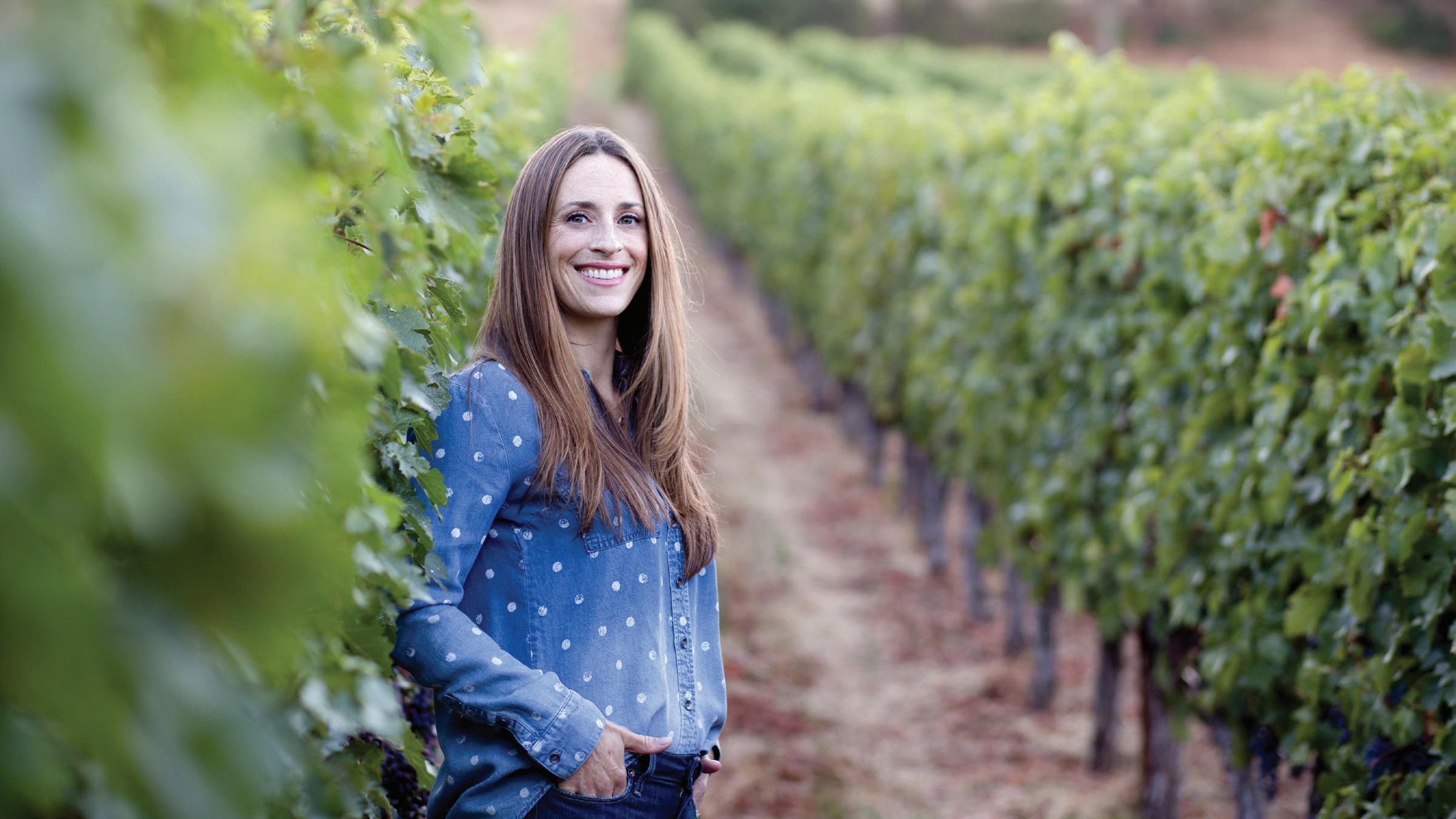
After graduating from St. Andrew’s in 2001, Cleo attended the University of Virginia, where she majored in art history, then moved to London to pursue a master’s in connoisseurship of fine and decorative art at Sotheby’s Institute of Art. “While I was in London, I worked at Bonhams Auctioneers,” she recalls. “There was a wine auction that included some Pahlmeyer wines. I thought, ‘Oh, all the way here in London… huh.’ No matter what your parents do, when you’re growing up, you probably don’t think it’s very cool.”
Witnessing her family’s wine go up for auction at Bonhams made Cleo realize “what my dad had built—he built a brand that was globally recognized,” she continues. Around that same time, her father was beginning to take steps toward retirement, and Cleo was considering what to do with her life following graduate school.
“As much as I loved art, I wanted to do something that was more business-related and less academics-related,” she says. “So I started with talking with [my dad] about possibly getting involved in the wine business.” Cleo started working in marketing and communications for

38 / FEATURE
Cleo Pahlmeyer ’01 on her career in wine
Pahlmeyer Winery in 2008 and became president of the brand in 2017.
Cut to 2022: Cleo is still in the wine business, but she’s forging her own path. “We sold the Pahlmeyer brand to Gallo in 2019. [It was] a tough family decision, but ultimately it was the right decision for everyone,” she says. In the sale, the family retained their two vineyards—one in Napa, and one on the Sonoma Coast. Today, Cleo runs a much smaller wine company called Wayfarer out of the Sonoma Coast vineyard (the Napa vineyard is leased out).
“My dad planted Wayfarer Vineyard in 2002, but I launched the Wayfarer label with the 2012 vintage,” Cleo explains. “It’s a 30-acre vineyard in a very remote region called Fort Ross-Seaview, affectionately known as the ‘True Sonoma Coast.’ The vineyard is just four miles from the Pacific and at 1,100 feet in elevation—a warm spot in an otherwise cool region.” Wayfarer has three front office employees besides Cleo, a vineyard crew of three, and sells about 3,000 cases of wine— primarily Pinot Noir, plus some Chardonnay—a year.
“I am loving running a smaller company,” she says. “In many ways, it’s a vertically integrated business. We’re growing the product, we’re making the product, we’re selling it direct to consumer, and we’re also working with distribution to sell the wine wholesale.” Cleo’s day-to-day responsibilities include everything from putting together financials and running payroll; managing the website and creating marketing materials; traveling and hosting events; and walking the vineyard and conducting blending tastings with Wayfarer winemaker Todd Kohn.
“There’s definitely an artistic aspect to winemaking, but you need to be very focused,” she says. “With winemaking and winegrowing, every detail matters.”
Cleo also notes that she loves producing wine in the more rural Sonoma Coast region.
“Pahlmeyer wines are known for being Napa Valley,” she says, “and they’re known for being a particular style in line with big Napa Cabernets and Chardonnay. Beautifully done, but bold!
At Wayfarer, we are farming the vineyard at the highest level to make Pinot Noirs and Chardonnays that are the best and purest expression of place. We are making world class-wines, just like we did with Pahlmeyer, but we’re really doing something different. With Wayfarer, it’s all about the vineyard.”
Not only the “what” but the “why” behind her family business is obviously no longer a mystery to Cleo; she clearly loves both wine and entrepreneurship. “You really have to have a passion for the wine business, because it is a tough business,” she says. “Every industry has its challenges, but with wine there’s always the aspect of mother nature [that you have to take into account]. And if you’re making wine at a high level, there are tough financial decisions that have to be made between the quality that you’re putting in the bottle versus what that’s going to mean for your bottom line. Those two things don’t always go hand in hand.”
What keeps her in the wine business year after year, despite its myriad challenges, is something more intangible.
“One of the best parts of being in the wine industry is [the fact that] wine is completely experiential,” she concludes. “No one’s upset to be at a wine dinner or a wine tasting. It brings so much joy to people’s lives to share a bottle of wine with a meal, with friends and family. We’re making a product that brings people together.” J
To learn more about or purchase Wayfarer wines, visit wayfarervineyard.com or contact Cleo directly at cleo@wayfarervineyard.com. She would love to hear from a fellow St. Andrean!
CLEO’S
FAVES
Kelley Fox Wines
Pinot Noir producer based in the Willamette Valley in Oregon kelleyfoxwines.com
Occidental Wines
Pinot Noir producer also based in Sonoma (“by another fatherdaughter team!”) occidentalwines.com
FALL 2022 39 MAKING MOMENTS OF TOGETHERNESS /
CHARLES MARVIL ’81 P’17
My career in hospitality started in my teens when I was able to finagle my way into the kitchen of the Fenwick Feedbag restaurant in Fenwick Island, Delaware. The owners took me under their wing and showed me the ropes. I spent the first summer mostly doing dishes, but also helping to prep food. I found the restaurant atmosphere intoxicating and I was immediately hooked. My second summer at “The Bag,” I moved into a bar back position, and I never looked back.
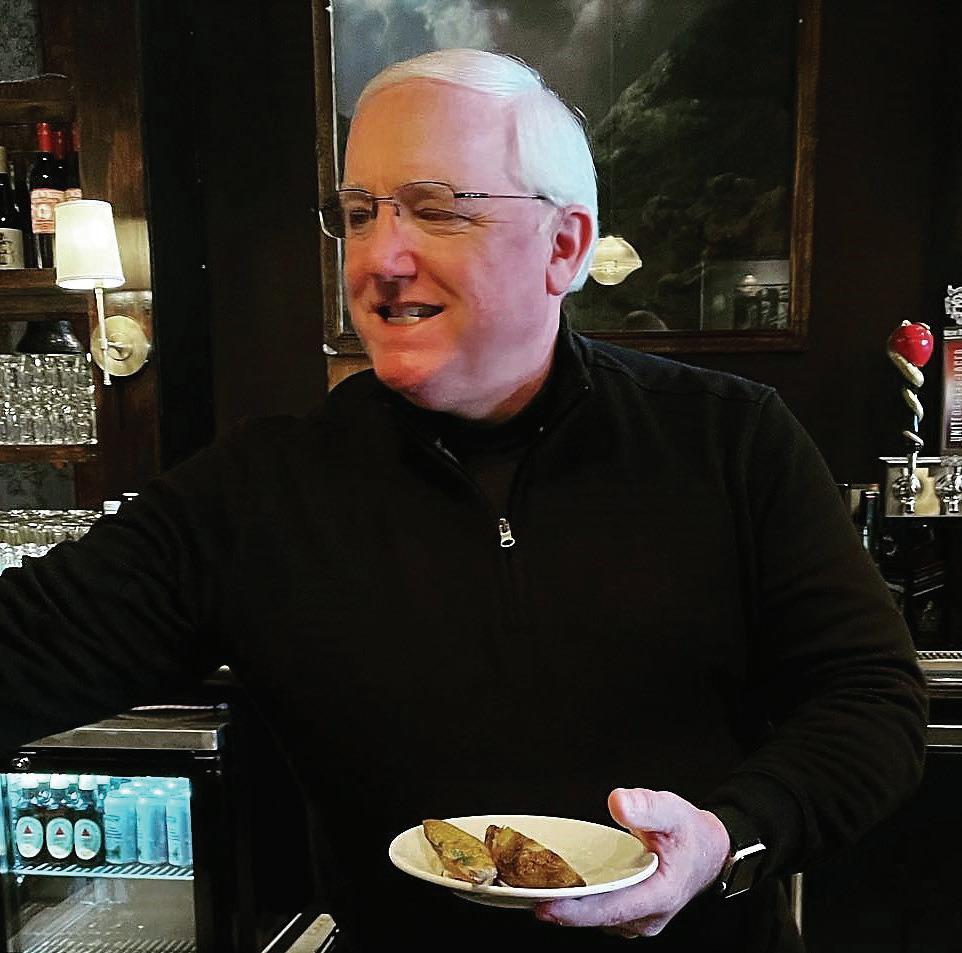
After graduating from SAS, I started college with the intention of becoming a mechanical engineer. I soon realized that was never going to happen, so I took a year off and decided to explore. I ended up in Atlanta and I started working there for a small French bistro run by two wonderfully eccentric women who helped guide my early career (and who kept me out of trouble on multiple occasions!). Fast forward several years and in 1988 I completed my undergraduate degree in hospitality management from Georgia State University, I married a pastry chef, and we were transferred to Houston with the Ritz-Carlton Hotel company. After spending eight and a half years with the Ritz-Carlton in Houston, Philadelphia, Tysons Corner, Cancun, Mexico, and Atlanta, I jumped out of the hotel scene and into the independent restaurant community. Over the next 25 years I was involved with several very successful, high-end, farm-to-table-style

SAS / ST. ANDREW’S MAGAZINE 40
/ FEATURE
restaurant concepts in Atlanta, and I also worked for the leading hospitality technology company at the time, Aloha (now NCR) and then their main competitor, Micros (now Oracle).
In 2018, I enrolled in the doctoral program of hospitality at Iowa State University. This is a hybrid program that has allowed me to take classes online during the year with a one month on-campus session each summer for two consecutive years. Living in a dorm again as someone in my mid-fifties has provided me with several amusing stories.
Today, I am a full-time lecturer at Georgia Southern University, and I am completing my Ph.D. dissertation on upcycling in the restaurant industry. In addition to my teaching role, I founded Mad Hospitality (mad-hospitality.com) with a colleague, and together we have opened three—soon to be four—restaurants in Madison, Georgia. Some would say I am “mad” to do it at this time in my life, but I tend to get bored if I am not busy.
The hospitality industry has provided me with an incredible career. I have seen and tasted some of the most incredible things on earth. I have worked with incredibly talented people and together we have provided customers with experiences that they will never forget. That is why I do what I do. Being a part of the best times of life for a person is an honor that I am forever grateful for.
TRANSFORMATIVE FOOD EXPERIENCE: I remember catching blue crabs out of the Chesapeake Bay and then, under the watchful eyes of my parents, learning how to steam them using Old Bay seasoning. I distinctly remember the briny, peppery spice as I ate my first cooked crab.
I remember tasting my first DRC [Domaine de la Romanée-Conti] burgundy at a Ritz-Carlton wine tasting. I thought my head would explode with the beauty of this wine.
I continue to look for and cherish my culinary “firsts.” They can happen at the most unexpected places. I recently visited a hole-in-the-wall restaurant in Atlanta called Kathmandu. They serve Nepalese and Indian cuisine and I tried their lamb biryani—a layered rice dish with onions, spices, and roasted lamb—and I thought about a higher power at work. It was incredible!
TABLE TALK
FAVORITES: My family enjoys beef bourguignon—a dish I copy shamelessly from Julia Child and prepare at the holidays.
One of my overall favorite wines is Champagne— typically consumed at a joyous event, but it also happens to be a great “food” wine that pairs well with seafood, lighter proteins such as chicken and pork, and of course, a good chocolate dessert. My favorite Champagne is anything from the house of Krug. They make several different styles each year, and they are all great. When my budget does not permit Krug (it’s not particularly cheap), I will generally drink a domestic sparkling wine such as J Vineyards Cuvee 20 Brut. This is a great sparkling wine made in Sonoma using traditional French winemaking techniques and cutting-edge technology.
ADVICE: Get a job! Go to work for your favorite restaurant and try to determine what makes it successful. Do not be afraid to get your hands dirty. Most people are, and that will set you apart from most people. Have a sense of adventure. Travel, taste, and experience life in all its many facets.
WHAT I’VE LEARNED: Empathy is one of the most important abilities that a person working in hospitality—really any industry—can have. I learned to pick up on how my guests were feeling from subtle clues. Body language and verbal clues provide you with most of what you need to know. Developing this ability has served me in my day-to-day work and also in my interactions with family, friends, and others. •
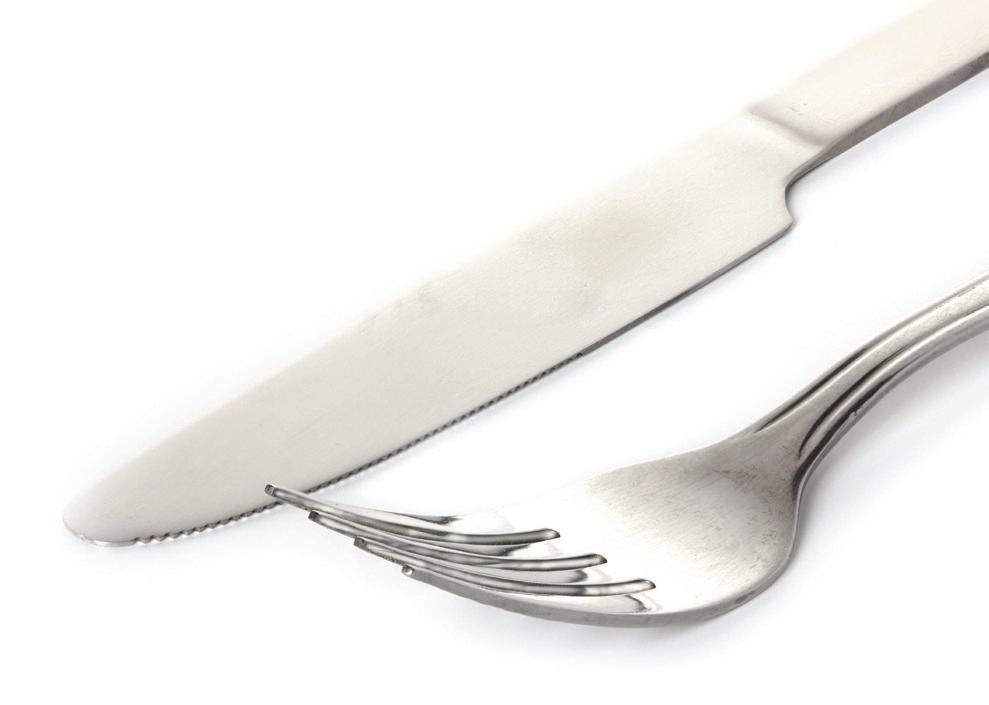
FALL 2022 41
TABLE TALK /
I have worked with incredibly talented people and together we have provided customers with experiences that they will never forget. That is why I do what I do. Being a part of the best times of life for a person is an honor that I am forever grateful for.
Alumni working in the food & beverage industry share wisdom & insights
AMY (DILSHEIMER) CURRIE ’81
I’m an award-winning executive producer, culinary producer, food stylist, and recipe developer. In 2019 I co-founded HotDish Productions, a culinary creative agency and production company based in New York City that specializes in celebrity chef content.
I got my start professionally working for a startup called Panna Cooking, which was sold to Discovery in 2019 [and that led to the launch of] Food Network Kitchen, a digital platform for home cooks. For Food Network Kitchen, I produced live and linear digital content cooking videos hosted by celebrity chefs. I’ve also worked on Food Network’s Girl Meets Farm, Beat Bobby Flay, The Kitchen, and Guy’s Ranch Kitchen, as well as A+E’s Love at First Bite. At Panna, I won a James Beard award and an International Association of Culinary Professionals award for video production in 2018. Today, I am creating and producing documentarystyle food and travel shows. I just completed a series for CookUnity [a chefs’ collective and meal-delivery service] called Off Menu starring Chef Einat Admony of New York City’s Balaboosta. Also in development is an educational kids’ cooking program called Boom!

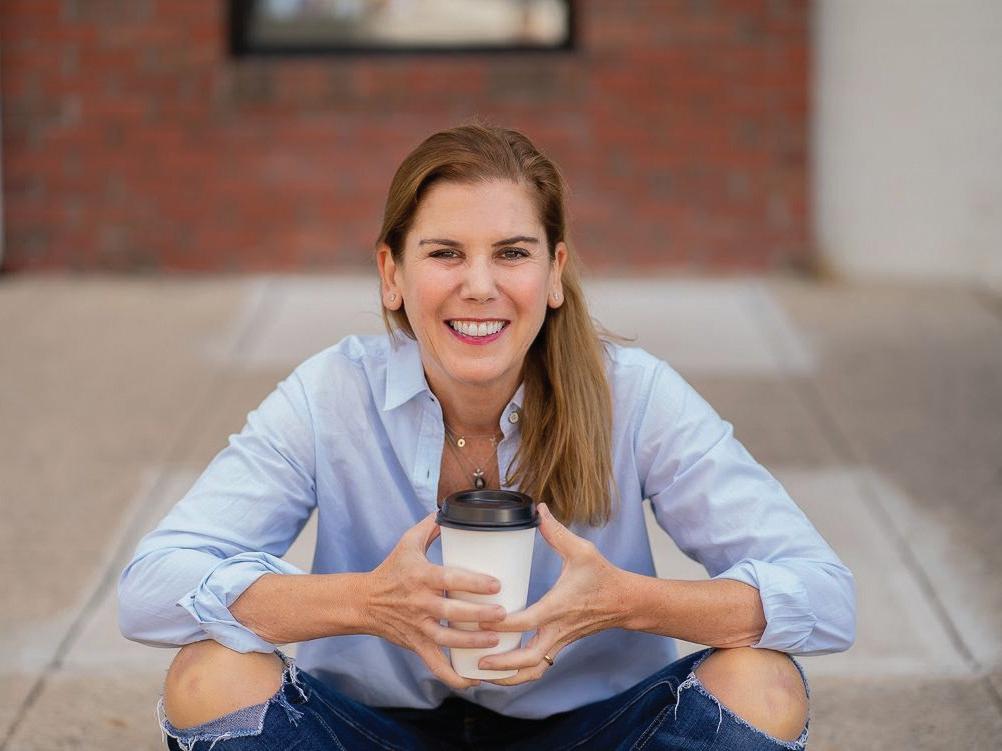
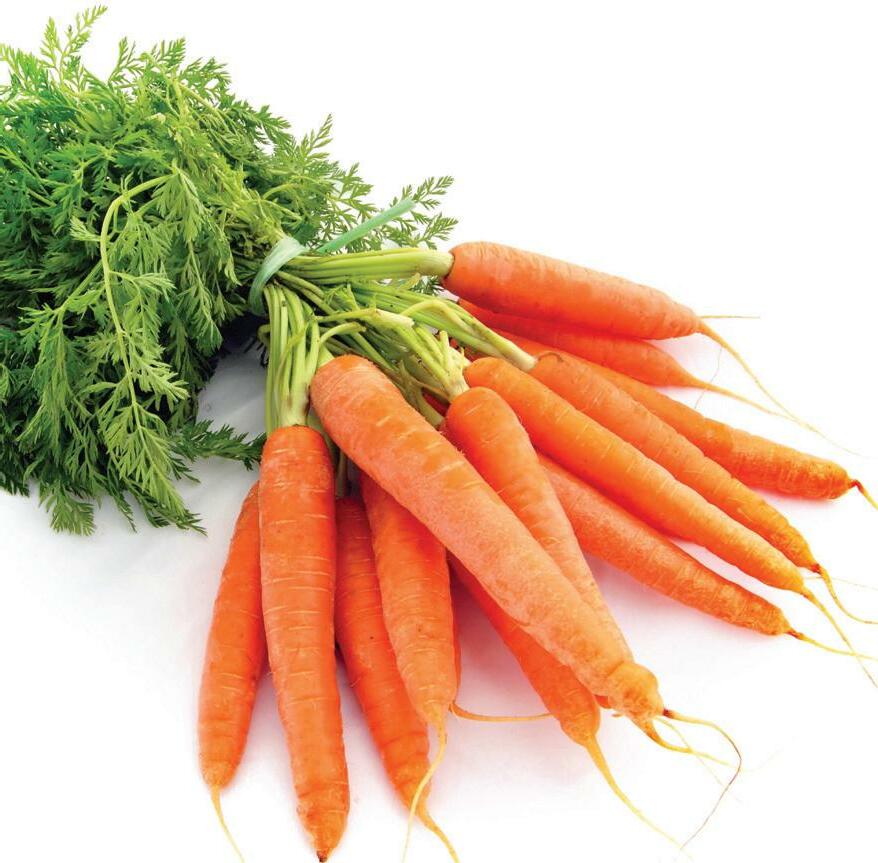
Kitchen: a new way for kids to learn how to cook that uses a whole-child approach for the digital age.
TRANSFORMATIVE FOOD EXPERIENCE: My first food experience was my twelfth birthday at Le Bec Fin in Philadelphia. The first course was served by Chef Georges Perrier: a soft-boiled egg in the shell topped with caviar and crème fraîche. That was it!
SAS MEMORIES: My food memories at SAS were limited to sneaking into the kitchen after hours and eating raw potatoes like apples, because that’s all we could find! Pappy’s Pizza and Dairy Queen will always be near and dear to my heart.
FAVORITES: To cook myself: A salted, roast chicken nestled on a bed of thinly sliced potatoes and onions (to absorb the schmaltz and juices) is exceptional. As are brown butter chocolate chip cookies with chopped-up artisan chocolate.
To eat/drink: Nothing beats sitting at a really good sushi counter for an omakase meal. In my other life I own a vineyard in Tuscany and drink my homegrown natural wine, tend to my garden, and make my own pasta.
WHAT I’VE LEARNED: There is no such thing as a free lunch.
ADVICE: No job is too big or too small. Network like crazy. •
SAS / ST. ANDREW’S MAGAZINE
/ FEATURE
PATRICK COURNOT ’02
I am a sommelier and restaurateur. I specialize in Eastern European, “orange” and “natural” wines. I am a partner in Ruffian and Kindred, both award-winning restaurants in the East Village of New York. I am inspired by wine’s ancient origins from countries like Slovakia, Lebanon, and the Republic of Georgia.

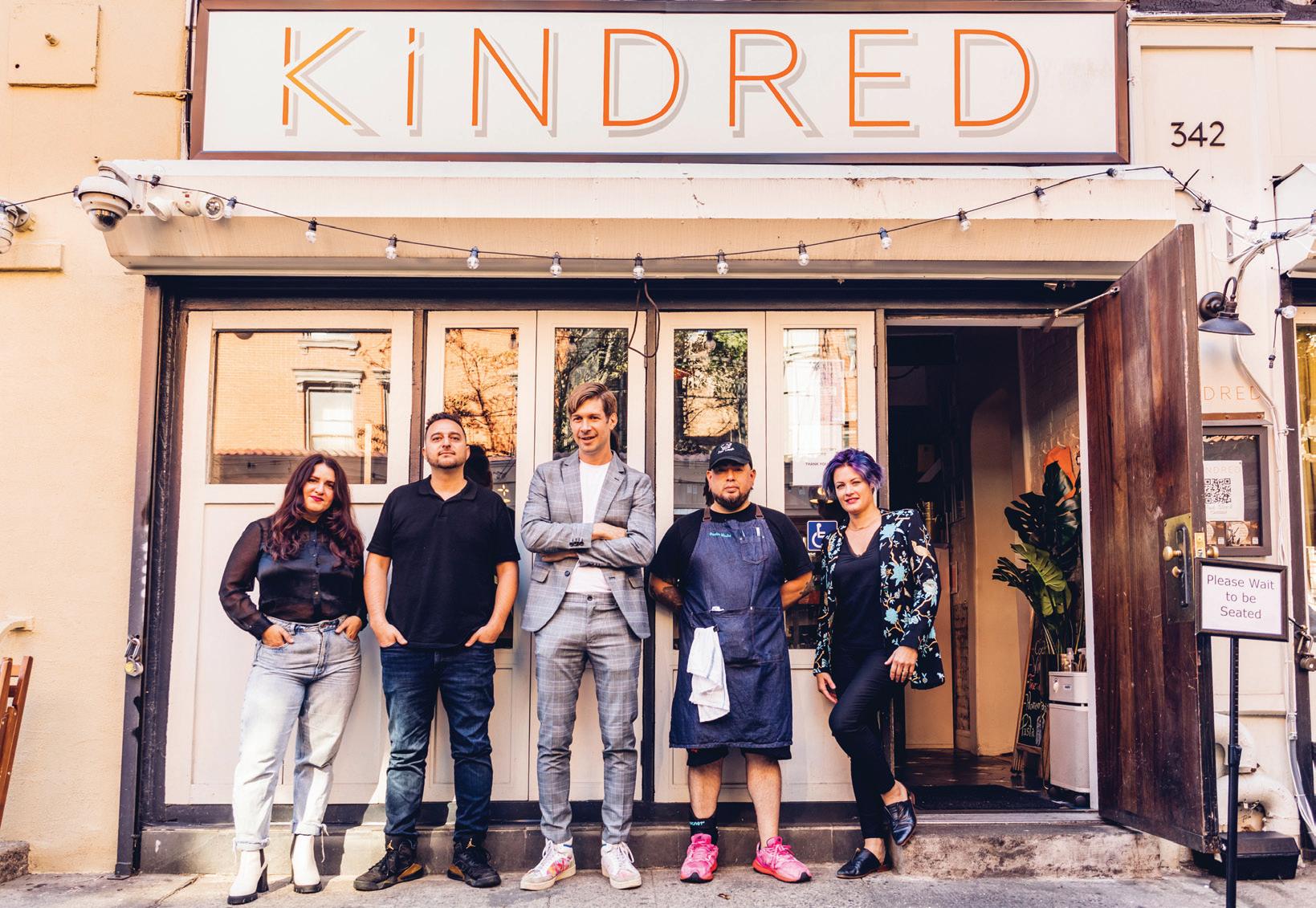
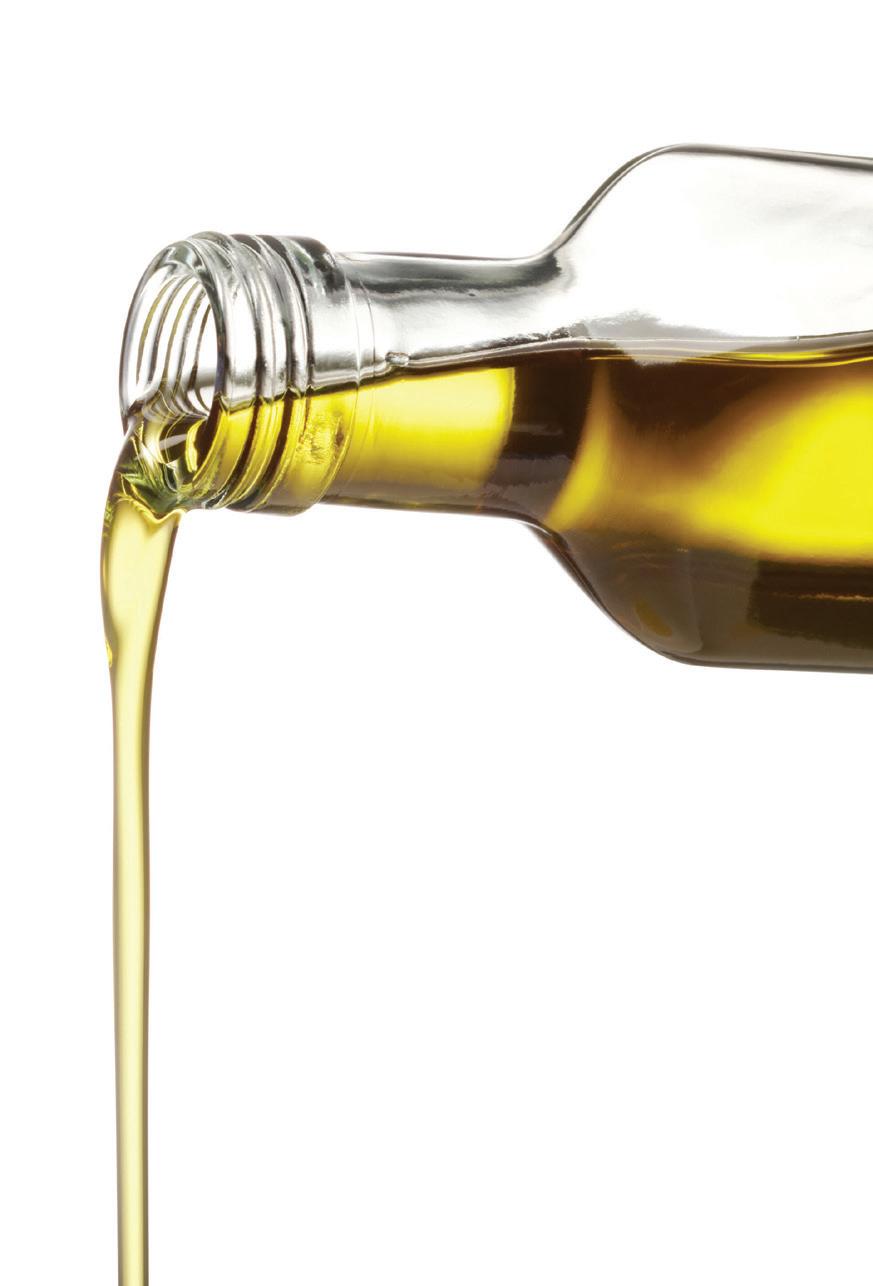
Cooking with my Mom and Dad was when I was happiest, and I had worked in kitchens as a young adult. I left college with an economics degree and clarity that I did not want to work in anything related to it. I had a chance encounter with the GM of a restaurant, who offered me a job in the office. I would find out that I was working in a Michelin three-star restaurant; I was twenty-one and I had to grow up quickly. I sat next to the beverage director. His job was fascinating: researching wine, history, customers, and food pairings. They were not going to offer me a job as a server, so I took a job at a brasserie in Midtown and enrolled in my first sommelier classes.
ADVICE: Work at places where learning and teamwork are valued. Ask questions. Take notes. When ideas are interesting or surprising, dig deeper.
TRANSFORMATIVE FOOD EXPERIENCE: A few years into my career I ate at Tabla in New York. Chef Floyd Cardoz was making waves serving modern Indian. The food was brilliant: pushing boundaries and sizzling with flavor while being rooted in the loving memories of his childhood. Eating there for the first time, I was moved by the food, and when a position opened up I applied and took it. I worked there until the restaurant closed in 2010. While there, I met most of my future business partners and many of my close friends.
SAS MEMORIES: A few quick ones: cooking brunch on Sundays at Mr. G’s apartment. Oversized cheesesteaks and sausage sandwiches from town. Going to the farm in AP Bio and seeing where food really comes from. Sneaking into the school kitchen at night.
FAVORITES: My favorite meal to cook for myself is creamy pasta and broccoli rabe, with sautéed garlic, blue cheese, and ground lamb.
I love the wines from Paolo Bea in Umbria. The reds are rich and roughly hewn. The whites (or really “oranges”) are dry, and taste of peach, black tea, and Highland scotch. Two restaurants that I loved and want to go back to with special friends: Cosme, a modern Mexican restaurant in Midtown, and Gage and Tollner, which serves luxurious American food in downtown Brooklyn.
ONE THING YOU’VE LEARNED: Patience. •
FALL 2022 43
TABLE TALK /
GRAHAM WORTH ’01
I am the owner of Common Market in Charlotte, North Carolina. Common Market is a modern twist on general stores of the past with a focus on deli sandwiches, craft beer, and good wine in a funky environment.
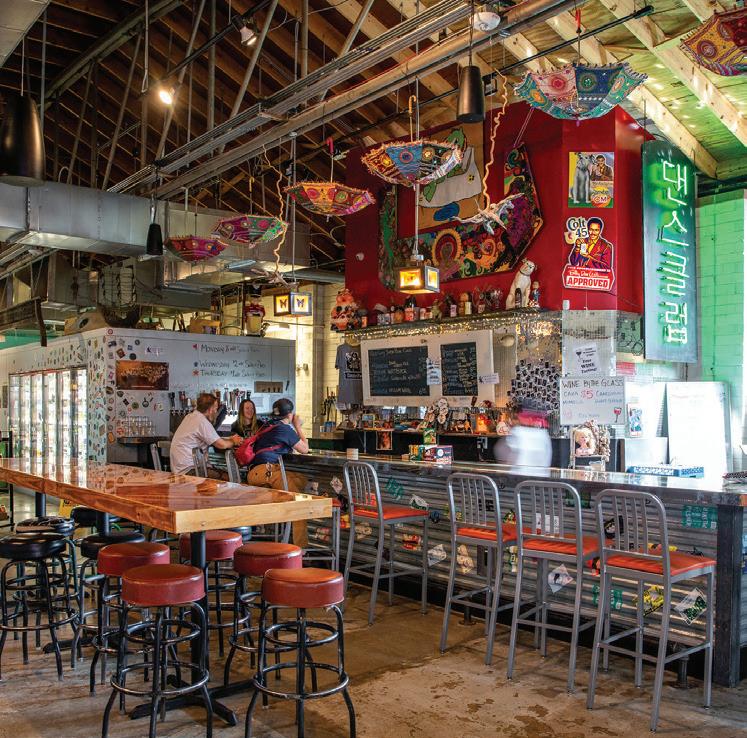
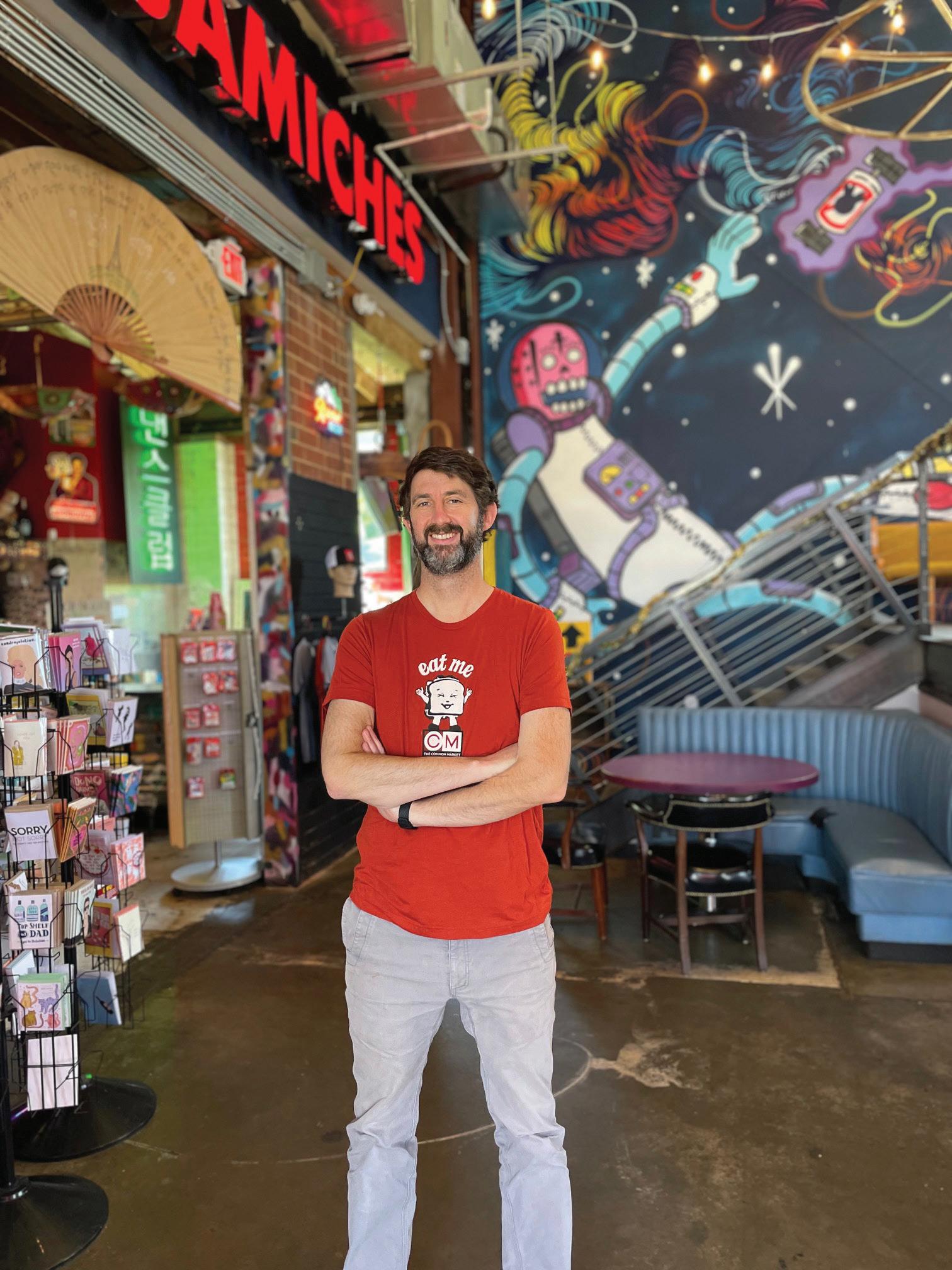
I got involved in Common Market after I quit my investment banking job for a startup that then went bankrupt. While searching for my next move, I had coffee at Common Market. That cup of coffee led to me buying and growing the business across North Carolina. I love the way this work has led me out of a social group and into a business that requires you to engage with your community and be a part of your neighborhood. My goal is to continue to grow
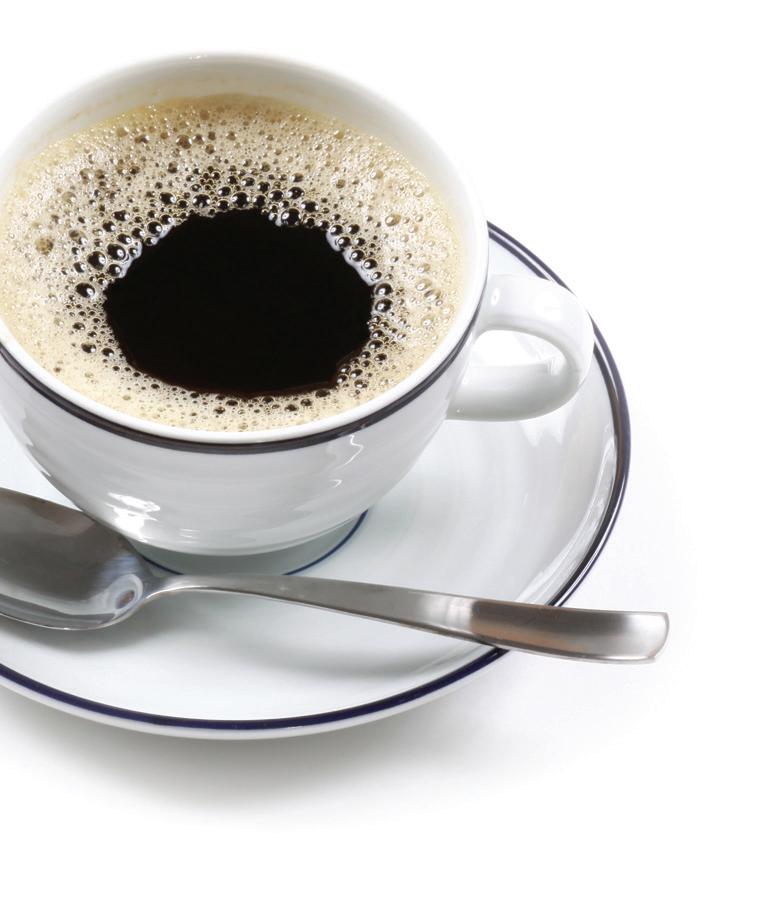
Common Market across North and South Carolina. It is a very niche business that serves neighborhoods in unique ways. We like to think of our stores as neighborhood living rooms, and everyone needs one!
TRANSFORMATIVE FOOD EXPERIENCE: BBQ—which in North Carolina is a food, not an event! I think the complexity of cooking BBQ is unique; techniques vary which consistently produce different and delicious results. I also associate it with bringing people across racial and generational boundaries that collide together both in social gatherings and in general appreciation for the craft.
SAS MEMORIES: Food at St. Andrew's was unique because family-style meals made eating both an exciting and scary event. As a student you were forced to interact with others, and that made you feel a range of emotions. Tables reflected the ethos of St. Andrew’s: a melting pot community that created situations around food, whether uncomfortable or enjoyable, that would shape us in the future.
FAVORITES: Love Fette Sau in Brooklyn, a hipster BBQ joint with great beer and delicious cocktails!
WHAT I’VE LEARNED: You can tell a lot about a person in how they treat someone working for tips. I always have extreme patience—which I normally don’t!—when we visit restaurants and am overly friendly with staff. It is a hard job that you will never understand unless you have done it yourself. My children will be required to do so in order to understand how people should be treated.
ADVICE: Restaurants are not for the faint of heart, but the way food and wine brings people together is special. J
SAS / ST. ANDREW’S MAGAZINE
/ FEATURE
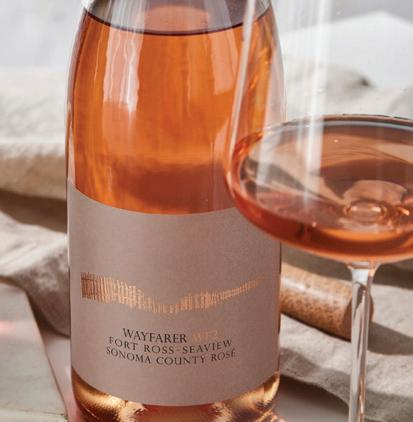


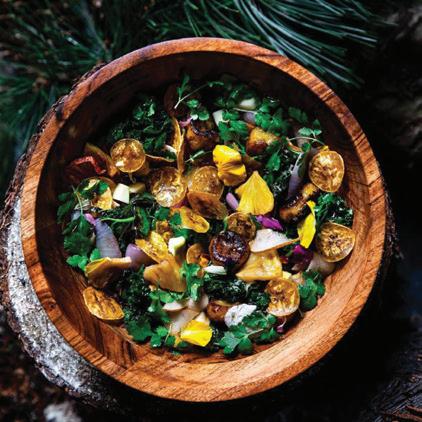
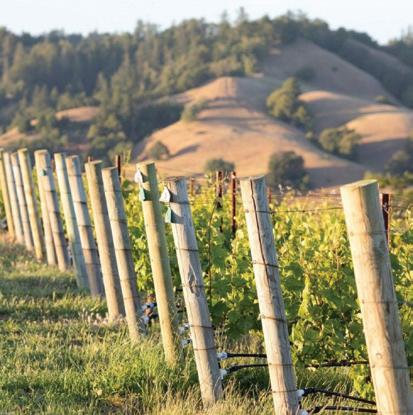
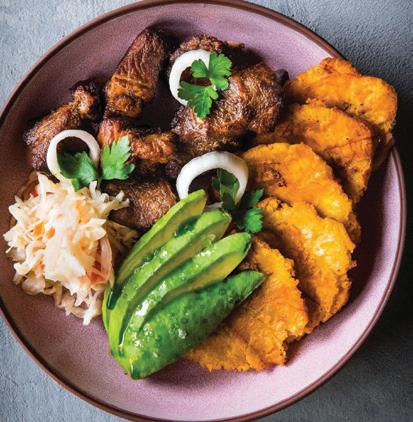

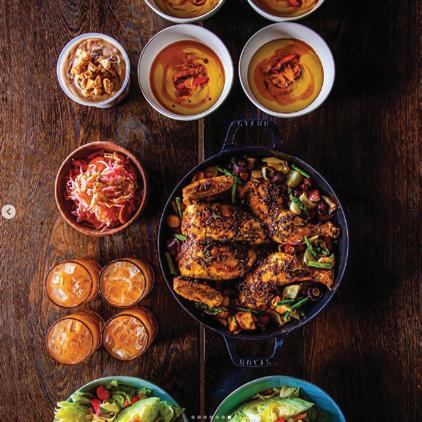
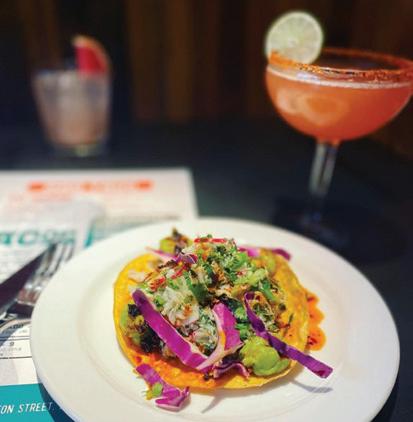
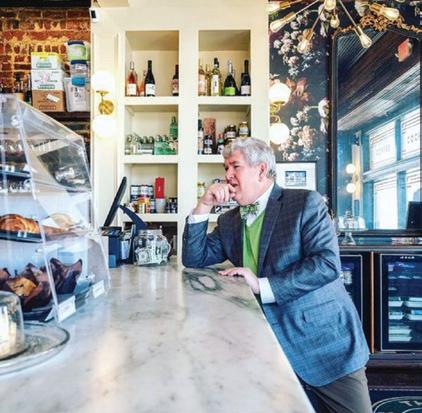

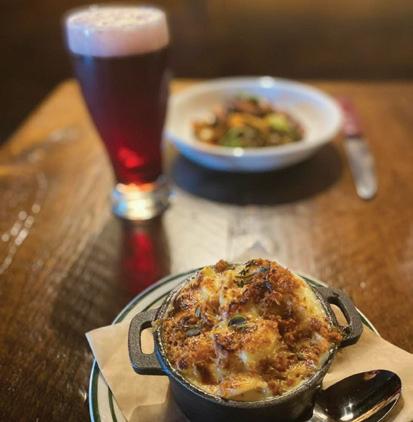
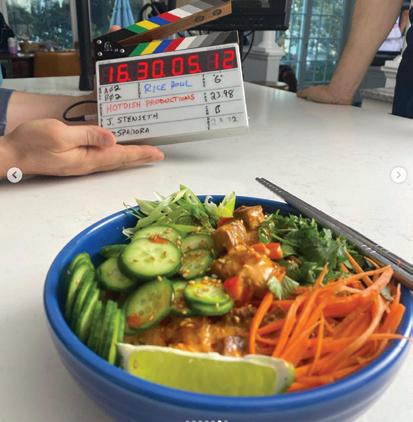

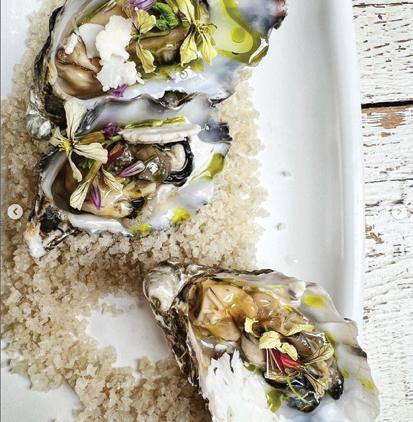


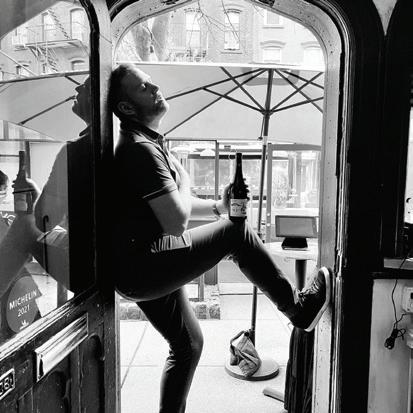
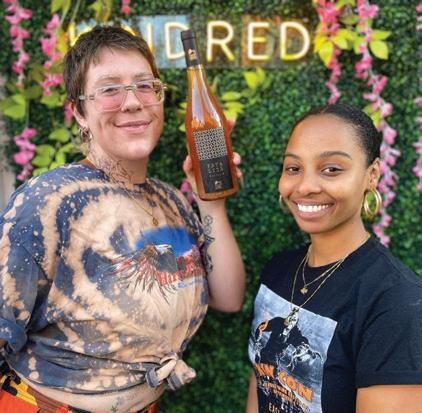
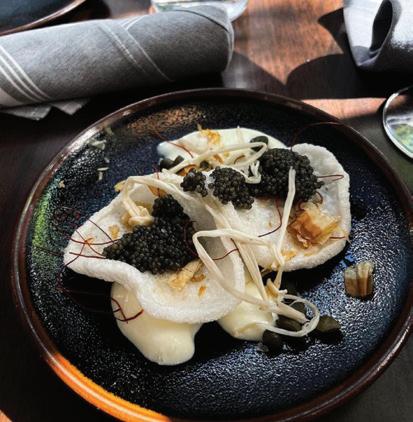
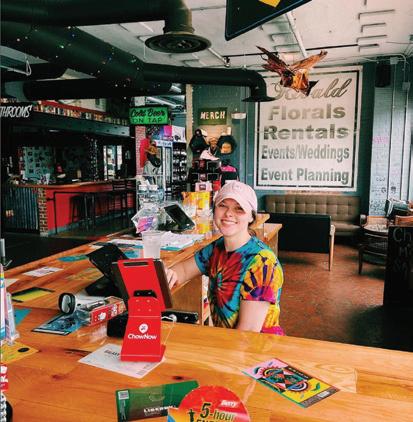
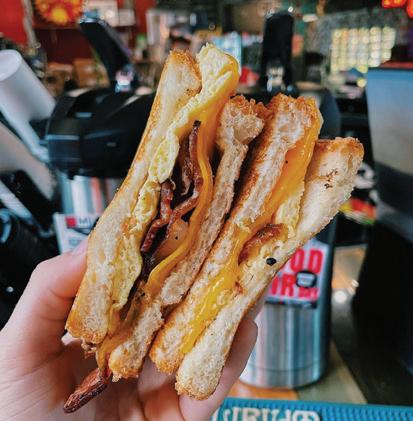

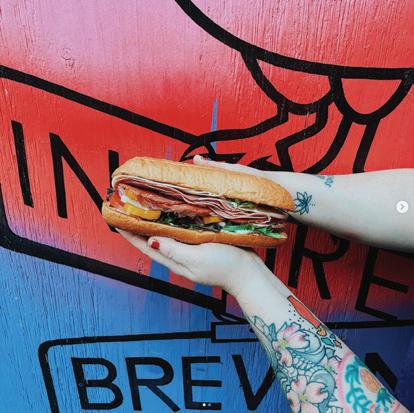
FALL 2022 45 @WAYFARERVINEYARD @GG30000 @KANNRESTAURANT @MADTACOMADISON @HARTANDCROWNTAVERN @THESINCLAIRMADISON @HOTDISHPRODUCTIONS @RUFFIAN_NYC @KINDRED_NYC @THECOMMONMARKETSOUTHEND TABLE TALK /
THE SCENES... Follow the work of Gregory, Cleo, Charles, Amy, Patrick, and Graham on Instagram!
BEHIND
Our Front Lawn hosted the 89th annual Commencement ceremony on May 29, which capped off a week of festivities that honored and celebrated the 81 students in the Class of 2022. Commencement speaker Janice Nevin ’77 P’13 emboldened our graduating Saints to “lead with love,” even in those moments when their paths go awry. Quoting a film we all know well, Nevin said, “ … seize the day.’ But what Robin Williams doesn’t say is that you can’t always choose the day you need to seize. In other words, there are times when the adventure chooses you.”
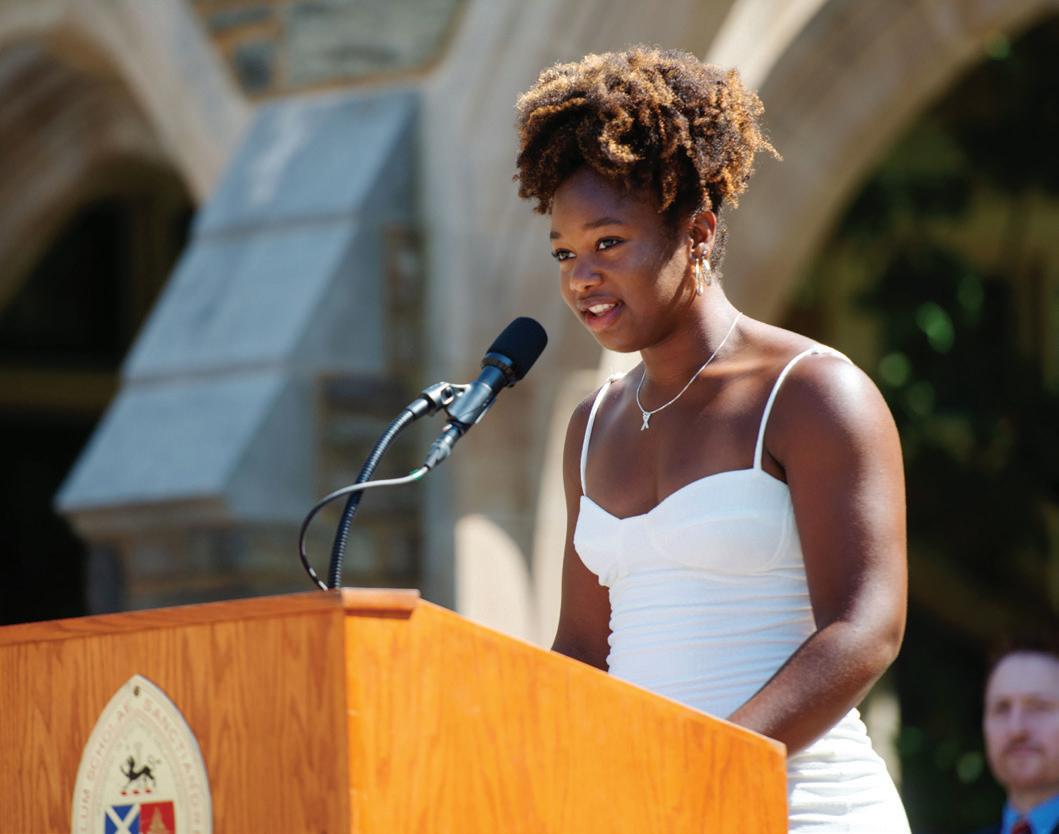
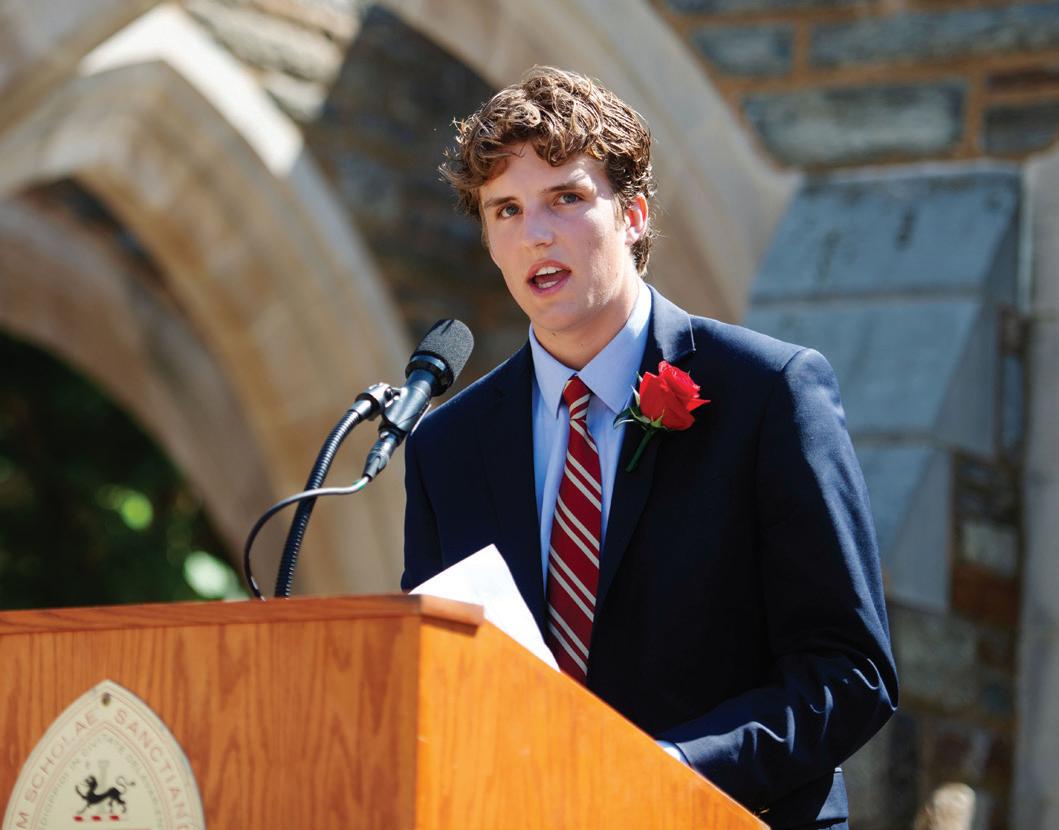
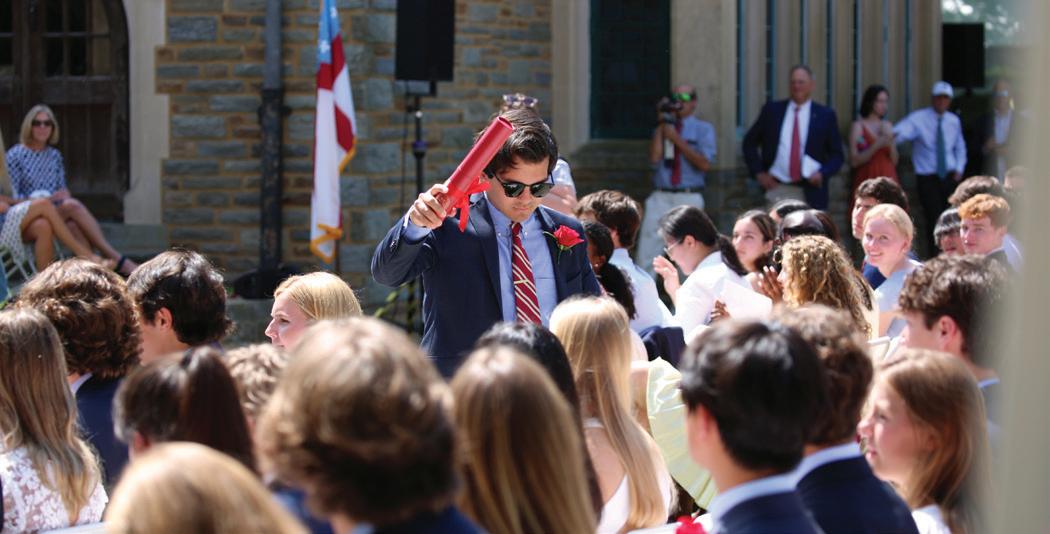
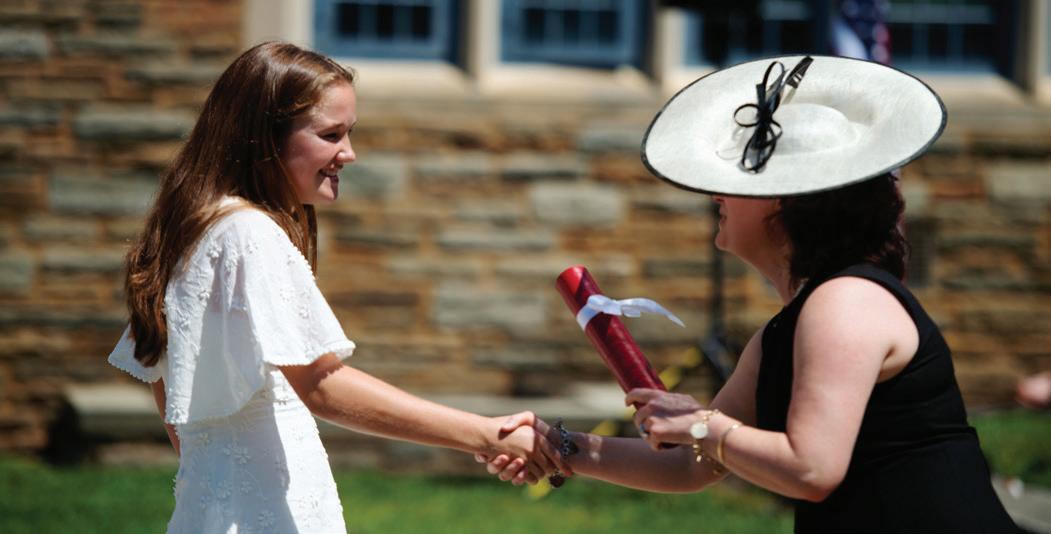
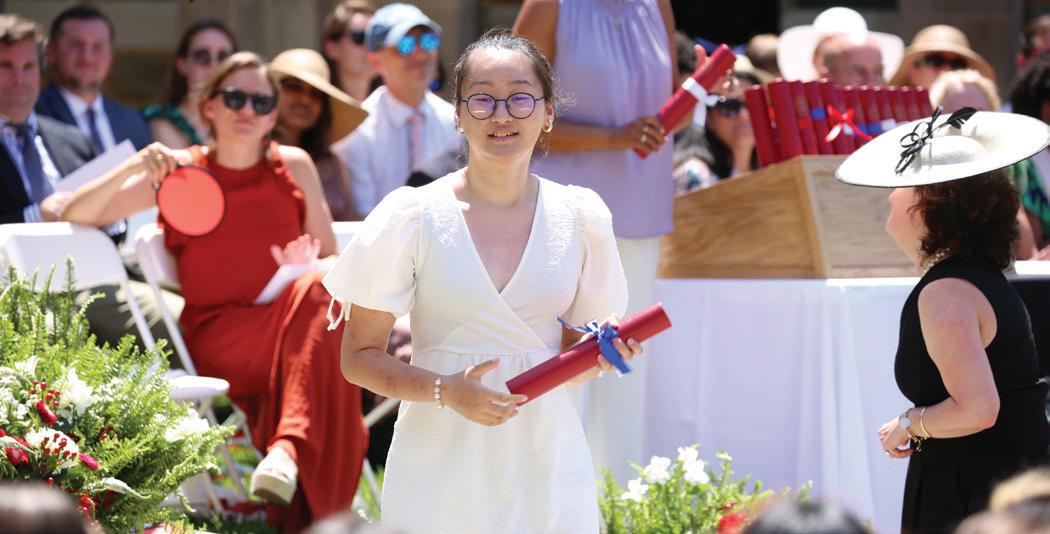
In the end, for the Class of 2022, the adventure chose well.
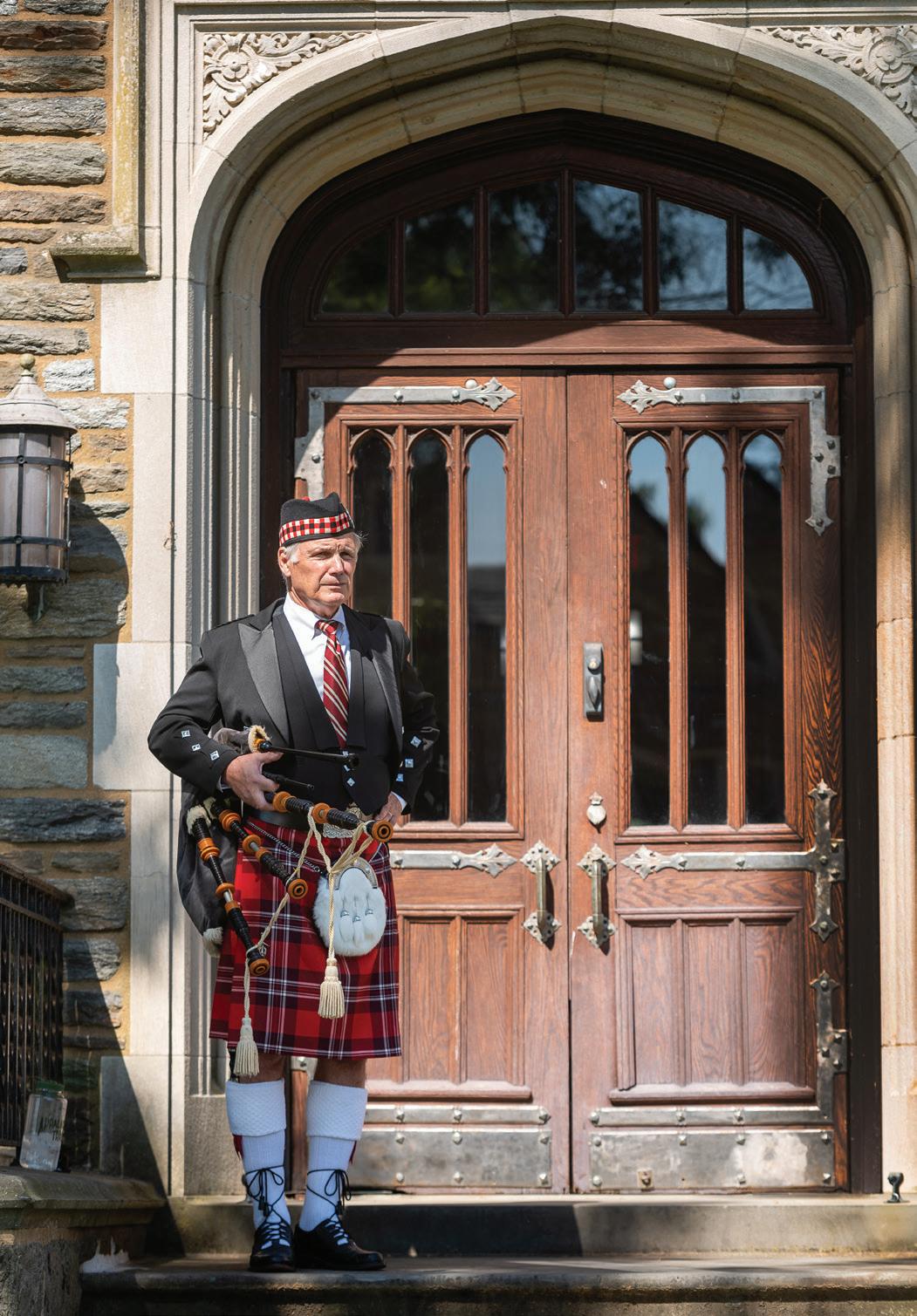
SAS / ST. ANDREW’S MAGAZINE 46 / FEATURE
Commencement2022
The Class of 2022 exceeded expectations. Together, you took on a moment not of your own choosing. And you not only survived, you thrived. You didn’t need to be told what to do, how to lead. You lived your values. You owned your culture. Your leadership, though an adventure not of your own choosing, has defined the experience of the III, IV, and V Formers who are here today and will leave an indelible imprint on generations of students to come. I am sure the St. Andrew’s history books will talk of this as a time of change as great as the years following World War II or the transition to co-education, of which I was a part. Future classes will look back and say, ‘Wow, look at what they did.’ The pandemic has changed each of us. But what has not changed for me is how my time at St. Andrew’s shows up in my life. And I hope the same for you. As confident as I am that your time here was not what you expected, I am even more confident that you are well prepared to tackle whatever this unpredictable, crazy, tragic, beautiful world has in store for you.”
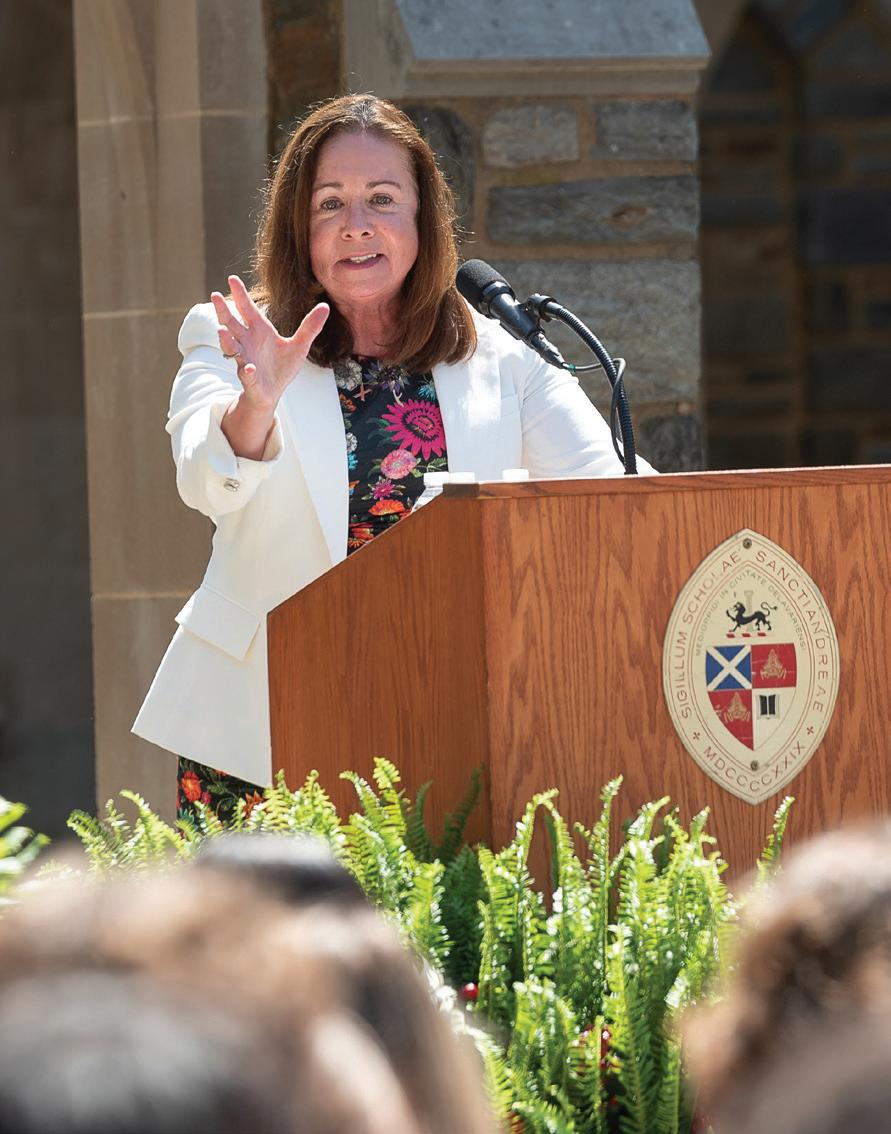
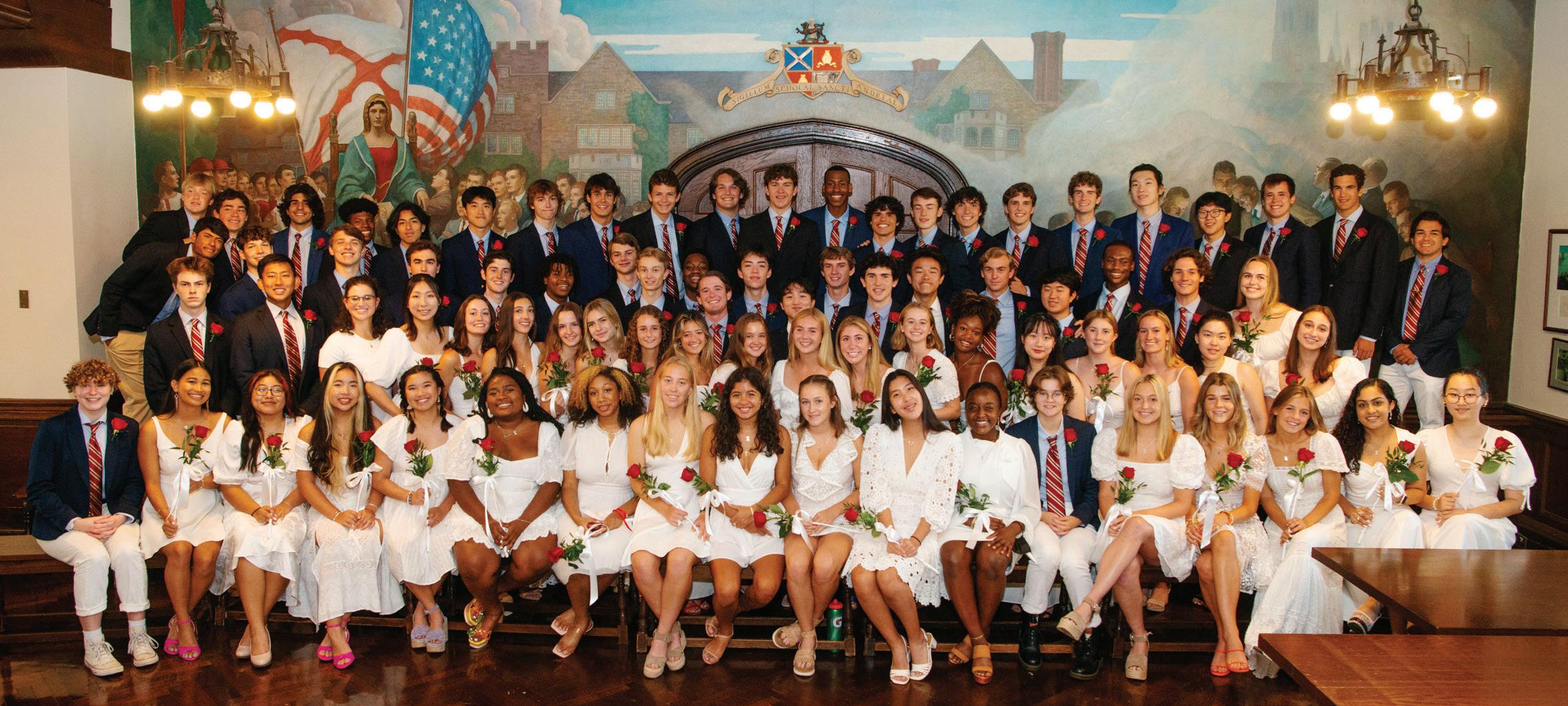
FALL 2022 47
COMMENCEMENT 2022 /
—JANICE NEVIN ’77 P’13 Commencement keynote
(FACING PAGE, CLOCKWISE FROM TOP LEFT) Gordon Brownlee ’75 P’05,’09,’14 prepares to play the processional bagpipes. • School co-president Aunyae Romeo ’22. • Graham Abramo ’22. • Pati Lunsford ’22 receives her diploma from Head of School Joy McGrath ’92. • School co-president Liam Hurtt. • April Seo ’22.
(CURRENT PAGE) Members of the Class of 2022. • Janice Nevin ’77 P’13 delivers the Commencement address.
All things must come to an end. Whether it be a game, a season, a career, a lifetime, or in this case, our time in high school, it will all inevitably end. The only constant is change. I have been roommates with Brandon Graves ’22 for four years, and I have known Frank Koblish ’22 since the summer going into sophomore year. I have only ever seen each of them cry once, and that was this year during the final seconds of our quarterfinal [basketball] game against Seaford. As time trickled down, we were forced to reckon with the fact that it was over. We would not be going to the B.O.B, we would not be going back to the hotel to celebrate, [Head Coach] Terrell [Myers] would end another season empty-handed, and we would never play basketball for St. Andrew’s again. And that hurt. But as we sat in that locker room and cried, I also realized I would have this team, this season, and this time at St. Andrew’s for the rest of my life. It was over, but I knew the memories we shared would last far beyond that grim gym in southern Delaware.”

(CLOCKWISE FROM TOP LEFT) Jake Kelly ’22. • Gigi Sempertegui ’22 celebrates with April Seo ’22. • Alani Davila ’22 gets a big hug from her mom Viviana Davila ’85 P’18,’22.
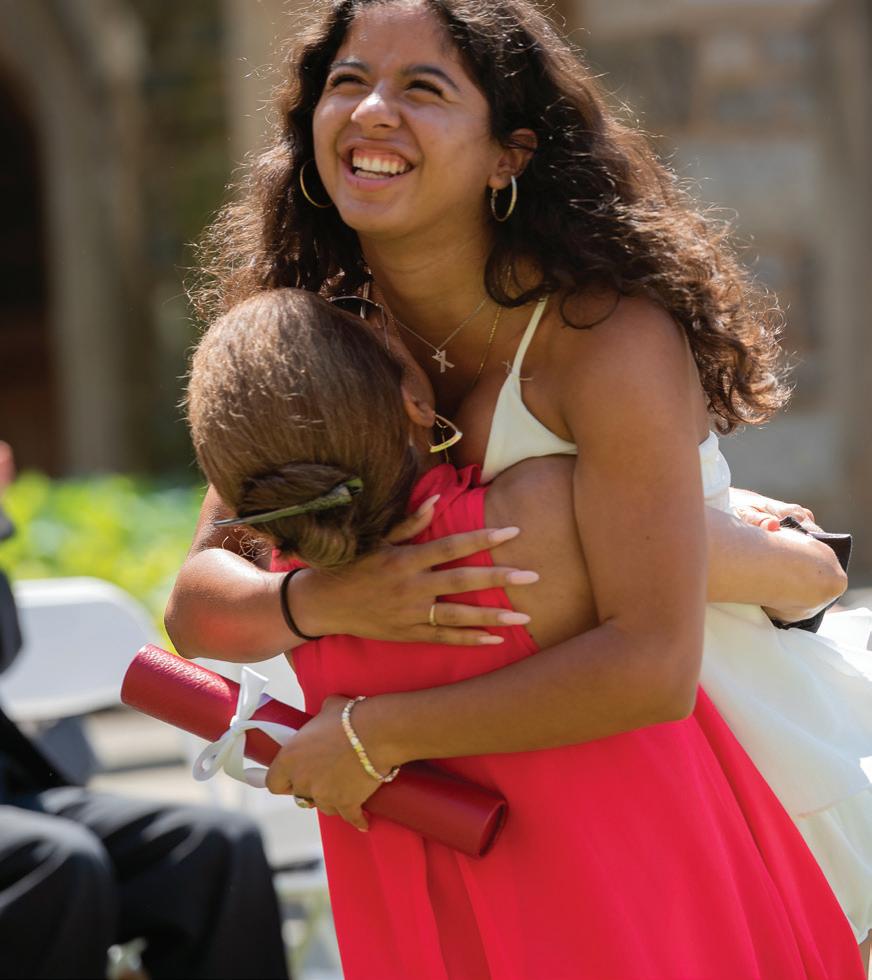
(FOLLOWING PAGE, CLOCKWISE FROM TOP LEFT) Gavin Frazer ’22, Nick Oxnam ’22, and Graham Abramo ’22 hug it out. • Sonal Bhatia ’22. • Members of the Class of 2022 Christo Butner, Jake Pellechia, Amari Bryant, Patrick Windels, Rocco White, Pranay Sanwal, and Evan Gervais pose at the VI Form dinner. • Chara Anekwe ’22.

SAS / ST. ANDREW’S MAGAZINE 48
Our student voices echoed throughout Senior Week with weight and promise. Enjoy the following excerpts of those remarks.You can read these talks in full at standrews-de.org/front-lawn.
/ FEATURE
—JAKE KELLY ’22 Awards Night talk on athletics
Dance rehearsals will forever remain a golden memory of St. Andrew’s. [The week before Arts Weekend,] we’d meet in the afternoons and evenings to run through the entire show. Whether you were dancing to one song or five, you’d stay in the Cameron Room, cheering every dancer on as they practiced their piece and got feedback. The morning of the show, we’d arrive in Engelhard at 8:30 a.m. for a final run-through before the show. We were barely awake, yet Mr. Gold stood on Engelhard’s stage bright and energetic, ready for another great show, with his Diet Coke in hand. Then, in just 45 minutes of performance, you would experience and witness weeks and months of teamwork, collaboration, and vulnerability. This same theme occurs [across the other arts disciplines] as well. A whole year of practice, resilience, and hard work comes to fruition for our musicians, artists, actors, dancers, writers, and filmmakers during the best weekend of all: Arts Weekend. To my fellow seniors: I’m so proud of us. We’ve put ourselves out there, we’ve chosen to be vulnerable, and together, we’ve strengthened this community.”
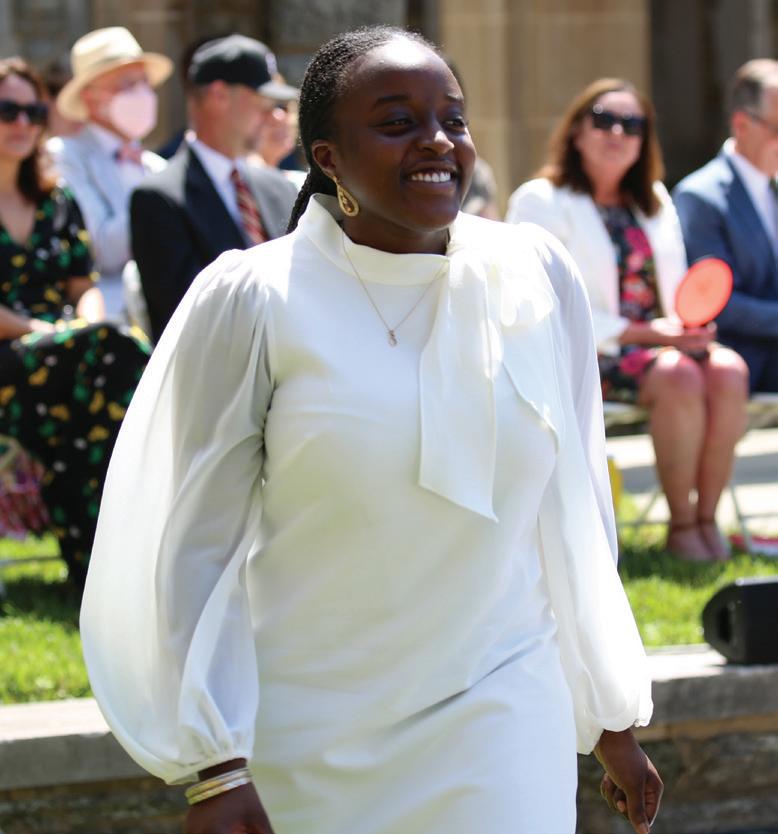
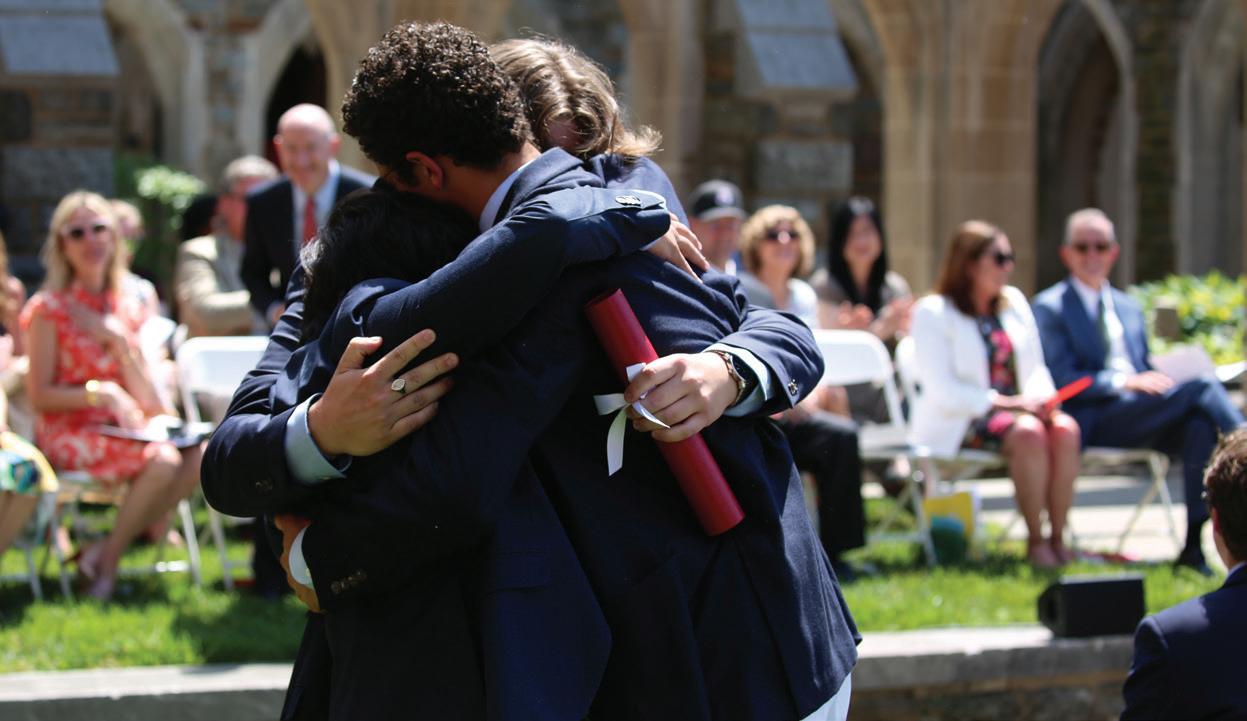


FALL 2022 49
COMMENCEMENT 2022 /
—SONAL BHATIA ’22 Awards Night talk on the arts
Believe it or not, I only spent 13 months on this beautiful campus. [When I think about my] virtual learning sessions over Zoom my sophomore spring and my entire junior year, all I can recall is how suffocated I felt behind my computer screen, hoping I could scream in the middle of an all-school meeting, or wishing someone would still remember me, the girl who joined Class of 2022 just a little while ago.
[Once I finally arrived on campus], I learned how lucky it is to grow up in the company of your parents, not worrying about packing your entire childhood into two suitcases, flying between countries and driving between states. I realized how much I hated Parents Weekend when I had to listen to other families plan for the weekend. I quickly found out I couldn’t even afford to be sick or have any mental breakdowns since I didn’t have the privilege to go home, or have my parents by my side to support me. So I have to congratulate myself on my graduation. For me, I am all I have. I have to be responsible for myself and my actions.
Perhaps in less than three years none of the student body will remember me, perhaps in five years the faculty would have a hard time matching my face with my name, perhaps Moss will become a new building and Founders won’t be the same ... there are so many uncertainties in the near future, but I’m absolutely sure about this: my Little Sister will greet her Little Sister the same way I met [mine] on the first day of school; my girls on Moss will become awesome residents on K, L, or M and soon turn into seniors who will make a homesick kid smile again; and most importantly, my advisor, Mrs. Berl, will forever be my American mom. Friends, I think I found it. After all these years, I found myself a place I can call home, I found myself a family who would teach me how to play blackjack no matter how much work they have, and I found myself people who I can trust and rely on.
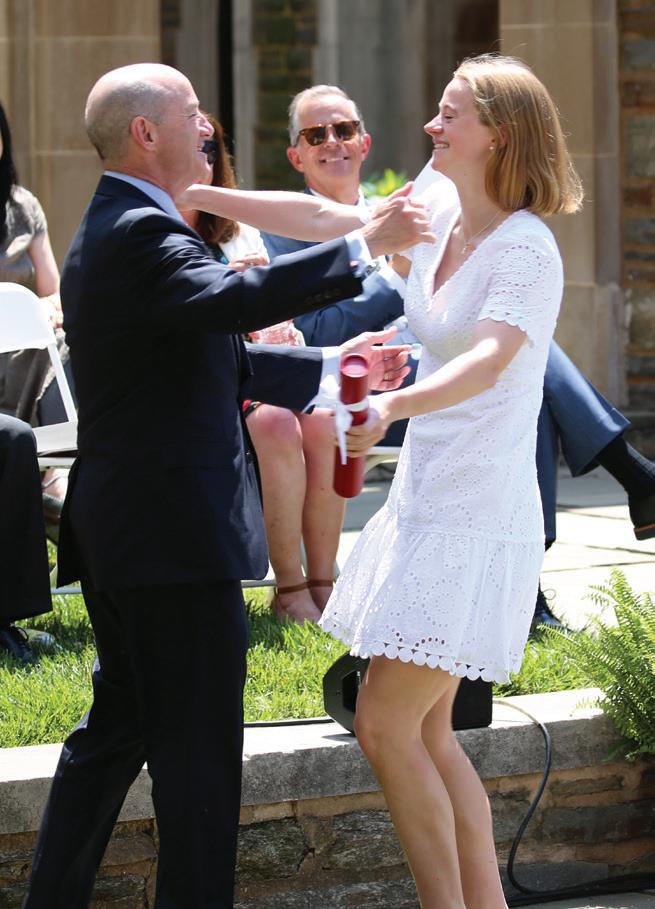

—YOYO CAO ’22 Mein Chapel talk (Yoyo hails from Shanghai and entered SAS as a new sophomore in the fall of 2019, shortly before the COVID-19 pandemic)
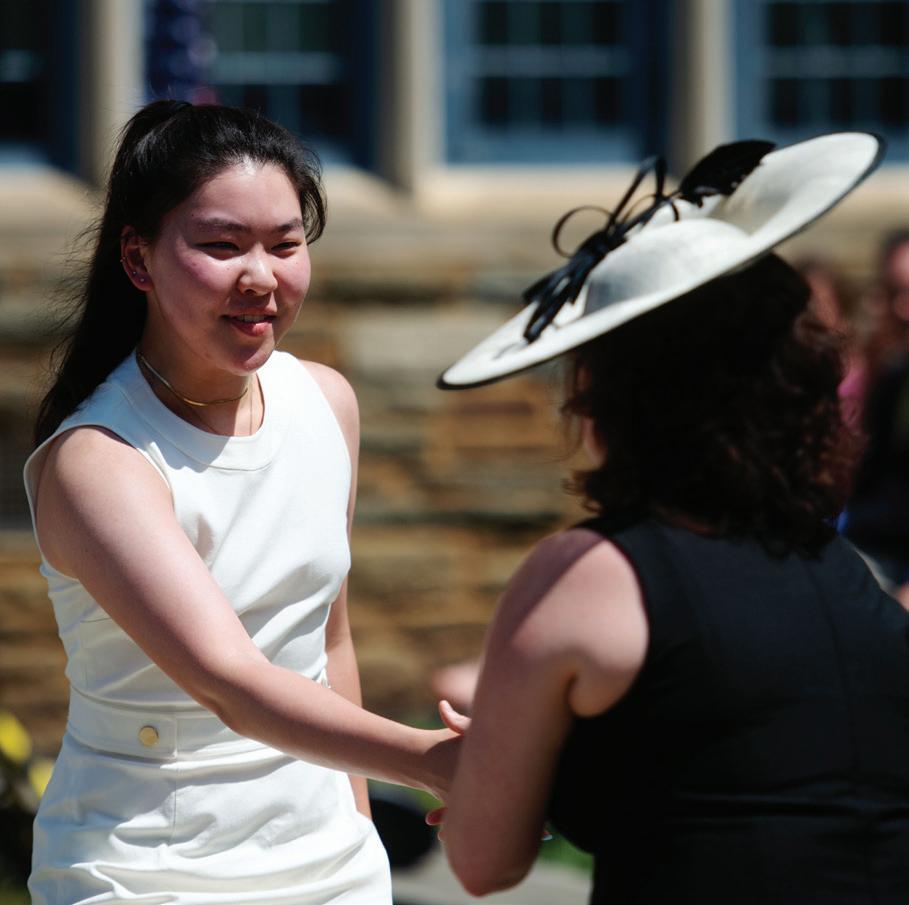
SAS / ST. ANDREW’S MAGAZINE 50
/ FEATURE
Dr. Walsh … had us analyze a poem titled Ithaka by Greek poet Constantine Cavafy. This poem begins with a declaration: ‘As you set out for Ithaka, hope your road is a long one.’ As high schoolers, we think a lot about achieving goals, triumphing over obstacles, overcoming struggle. But when I reflect on my academic journey at St. Andrew’s … I think about the math classes I’ve taken. I wish I could [say it was] just one of them that challenged me, but truthfully it’s been every single one. It’s taken a few tears, and it’s taken many teachers pushing me to keep struggling, until I eventually learned to value my own hard work as much as any end result. I think about the many nights I’ve stayed up much later than I should have, totally engrossed in that Humanities paper, that heated conversation with my roommate about Beloved. I’m not saying you should stay up past your bedtime, but what I am saying is that St. Andrew’s has shifted my perception of the word ‘struggle,’ instilling in me a sense of excitement and craving for it, rather than dread. St. Andrew’s is a place that celebrates immersion in the learning process, whether in round table discussions, the exhibition process, its collaborative approach to problem solving, or just through teachers that cultivate such a contagious commitment and passion for learning.

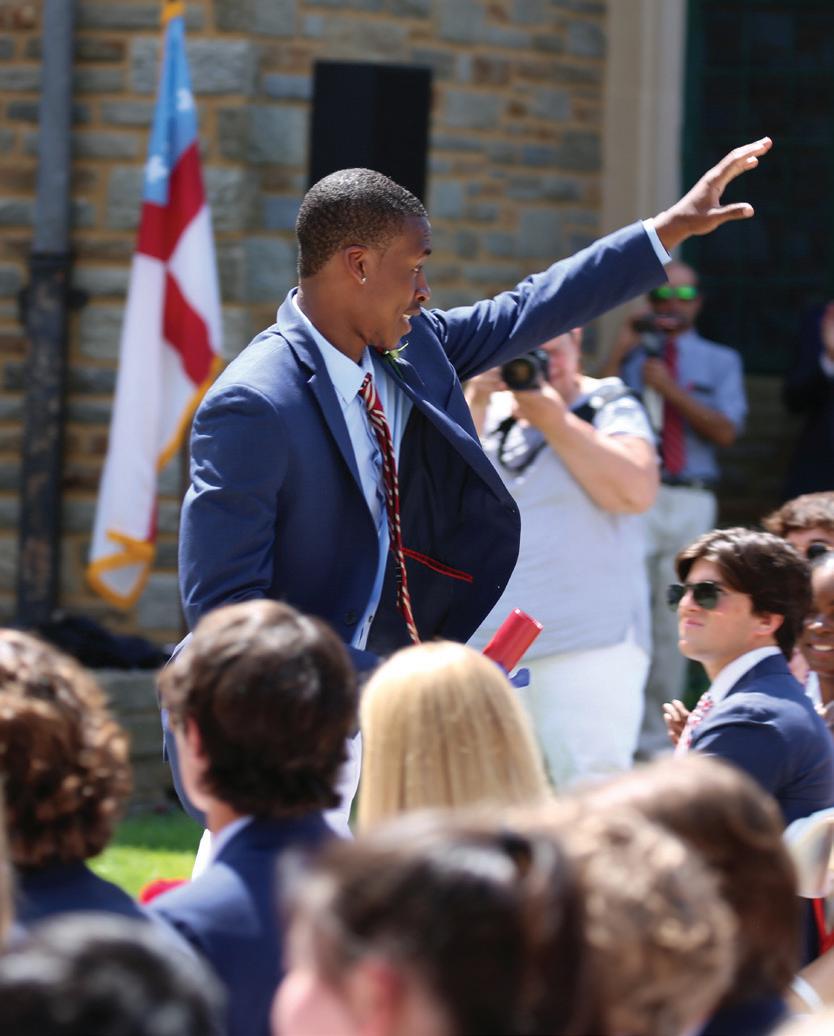


FALL 2022 51
COMMENCEMENT 2022 /
—ADELAIDE DIXON ’22 Awards Night talk on academics
(FACING PAGE, TOP TO BOTTOM) Emily Murphy ’22 gets a hug from her dad, Trustee Paul Murphy P’17,’19,’22. • Hunter Melton ’22 celebrates his graduation. • Yoyo Cao ’22.
(CURRENT PAGE, COUNTERCLOCKWISE FROM TOP) William Yu ’22. • Adelaide Dixon ’22 receives the Christopher Edward Wilson Award from Christopher’s mom, Juanita Wilson P’95,’99. • Brandon Graves ’22. • Class of 2022 students cheer each other on.
COMMENCEMENT AWARDS
ROBERT T. JORDAN AWARD
Given by his classmates and former teachers at St. Andrew’s in memory of Robert T. Jordan, Class of 1986, who died September 11, 2001 in the World Trade Center attack, to the IV Form boy and girl who display the qualities that made Robert so memorable and distinctive: a love of humanity, an appreciation of friendship, a willful perseverance and resolve amidst adversity and opportunity, a unique and refreshing perspective on life and all its possibilities.
Sasha Nichols DeCosta
Marie Sheradan Dillard
Charles Denton Lunsford
CHRISTOPHER WILSON AWARD AND SCHOLARSHIP
Given by his parents in memory of Christopher Edward Wilson, Class of 1999. The award recognizes that senior who best embodies Chris’ virtues and personal qualities: a love of St. Andrew’s, a quiet and authentic appreciation of life, friendship and community, a devotion to service and to children, and a kind and generous spirit.
Adelaide McKnight Dixon
THE CRISTIN C. DUPREY DIVERSITY AND INCLUSIVITY AWARD
Awarded in memory of Cristin C. Duprey, Class of 2004, to the VI Former who has provided exceptional service in the cultivation of a diverse and inclusive St. Andrew’s School community.
Sonal Bhatia
Jake Thomas Kelly
Aunyae Janyah Romeo
JONATHAN B. O’BRIEN HEAD OF SCHOOL AWARD
The Head of School Award celebrates the brilliant and courageous leadership and vision of St. Andrew’s third Headmaster, Jon O’Brien, who led the School from 1977 - 1997. The Award recognizes seniors who contribute to the ethos of the School with integrity, humanity, generosity, and love.
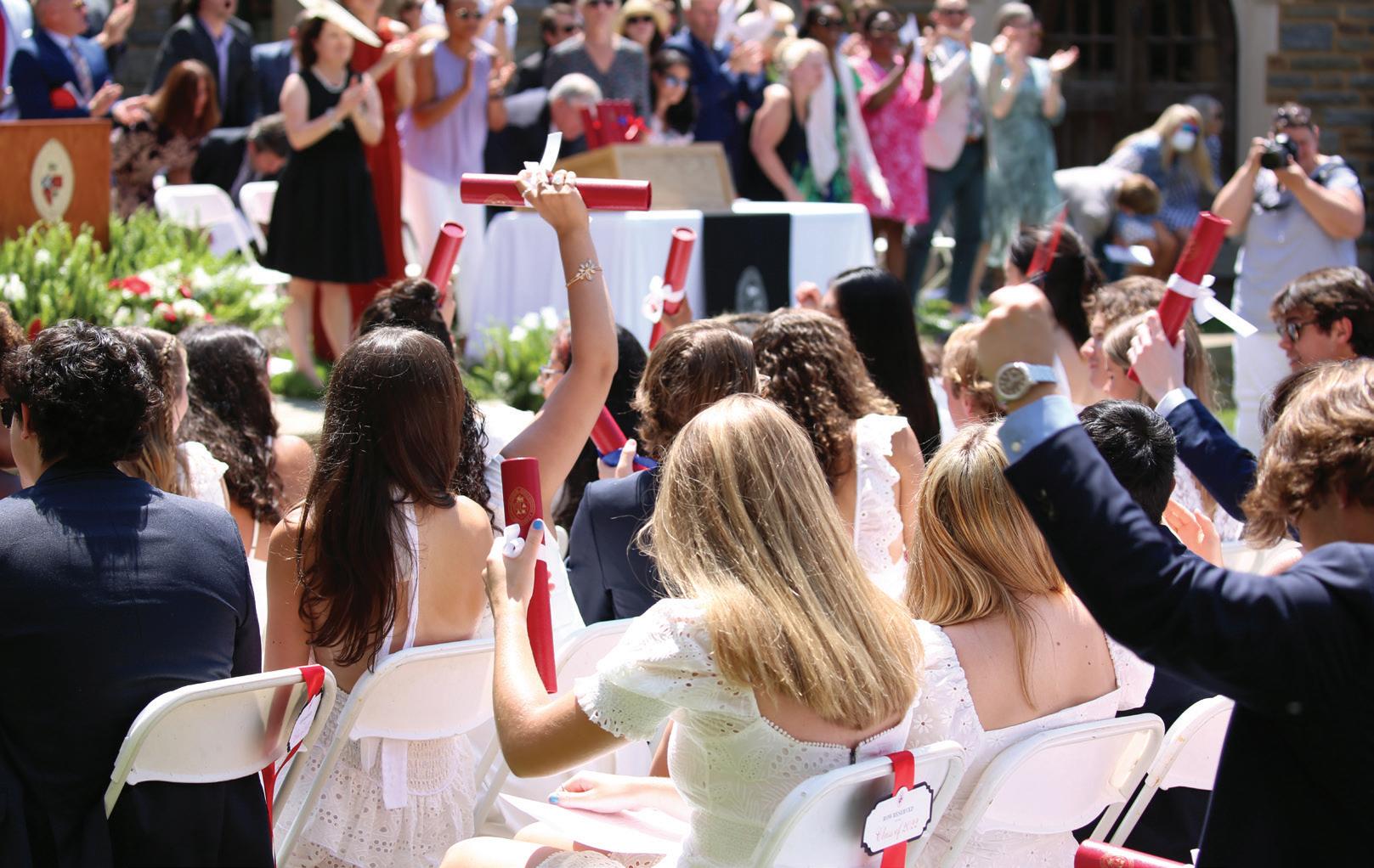
William Callender Hurtt IV
Aunyae Janyah Romeo
JOHN MCGIFF FINE ARTS AWARD
Awarded to the student who has made the greatest contribution in the fine arts and demonstrated a depth and quality of talent that demands our recognition.
THE HENRY PRIZE
Jacob Peter Pellechia
Awarded to the VI Form boy and girl who have been of the greatest service to athletics. It recognizes not only personal athletic skill, but also service to the teams of which the students were members.
Allaire O’Brien Berl
Brandon I Graves
Phineas Thomas Takai Hunt
CHARLES H. WELLING, JR. PRIZE FOR WRITING
Given by members of his class in honor of Charlie Welling ’45, writer and raconteur, to the student who has produced exemplary non-fiction writing in all disciplines throughout his or her career at St. Andrew’s.
Emily Susan Murphy
AMANDA LEYON PRIZE FOR CREATIVE WRITING
Given in memory of Amanda C. Leyon ’95 by her classmates, to the student who has excelled in creative writing.
Madison Grace de Guia Macalintal
John Hunter Melton
LOUIS C. MANDES LIBRARY PRIZE
Given in memory of Louis C. Mandes, Jr., School Librarian, to the student who has demonstrated a love of books and a deep appreciation for the Library.
Yevheniia Khalabadzhakh
Lila Darden Shuman
SHERMAN WEBB PRIZE FOR HISTORY
For outstanding work in history.
William Andres Atkinson
Sonal Bhatia
Jun Andrew Choi
W. LEWIS FLEMING PRIZE FOR FRENCH
Given by the Alumni in memory of W. Lewis Fleming to the student of French who is most deserving in interest, effort, and achievement.
Danny Jiahan Huang
THE KING PRIZE
For the leading scholar during the VI Form year.
THE FOUNDER’S MEDAL
Jiayi Yuan
Awarded to the scholar in the graduating class who, during his or her career at St. Andrew’s, has achieved the best academic record in the Form.
Jiayi Yuan
THE NANCY K. HARGROVE PRIZE FOR SPANISH
Given by Joe Hargrove, Class of 1967, in memory of his wife, who was a great admirer of St. Andrew’s. Awarded to the student doing outstanding work in Spanish.
Emily Susan Murphy
Gizelle Ashley Sempertegui Gomez
CHINESE PRIZE
WILLIAM H. CAMERON AWARD
Given to the VI Form boy and girl who have performed outstanding service to the School.
Sonal Bhatia
Jake Thomas Kelly
Awarded to the student doing outstanding work in Chinese.
Austin Willis Daly
Jake Thomas Kelly
ST. ANDREW’S CROSS
Given in honor of the late Bishop Cook of Delaware, who was associated with the founding of the School. It recognizes the student whose contribution to the School has been distinguished for Christian qualities of concern for others, humility, and high principle.
Yevheniia
Khalabadzhakh
ACADEMIC AWARDS
CHESTER E. BAUM PRIZE FOR ENGLISH
Given by the members of the English Department in honor of Chester Earl Baum, for 29 years an outstanding teacher of English at St. Andrew’s School, to the VI Former who has excelled in English scholarship.
Adelaide McKnight Dixon
William Callender Hurtt IV
William Alexander Vogel
G. COERTE VOORHEES PRIZE FOR CLASSICAL LANGUAGES
Given by his children in memory of their father, G. Coerte Voorhees, Latin teacher at St. Andrew’s School from 1935 to 1962. Awarded to the student who has done outstanding work in Latin and/or Greek.
Adelaide McKnight Dixon
WALTER L. HARRISON PRIZE FOR MATHEMATICS
Given in memory of his mother by Walter L. Harrison, Class of 1966, to a student of high achievement, whose work in mathematics is distinguished for its depth of interest, imagination, and creative thinking.
Jiayi Yuan
52
/ FEATURE
CLASS OF 2020 CELEBRATION
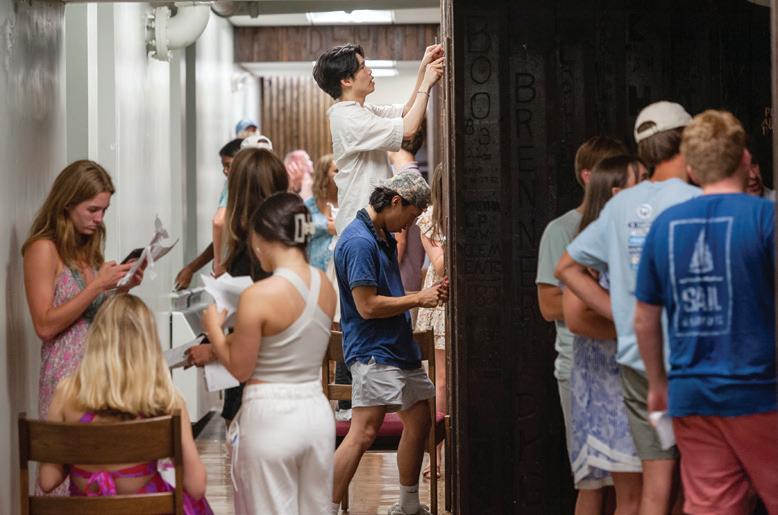
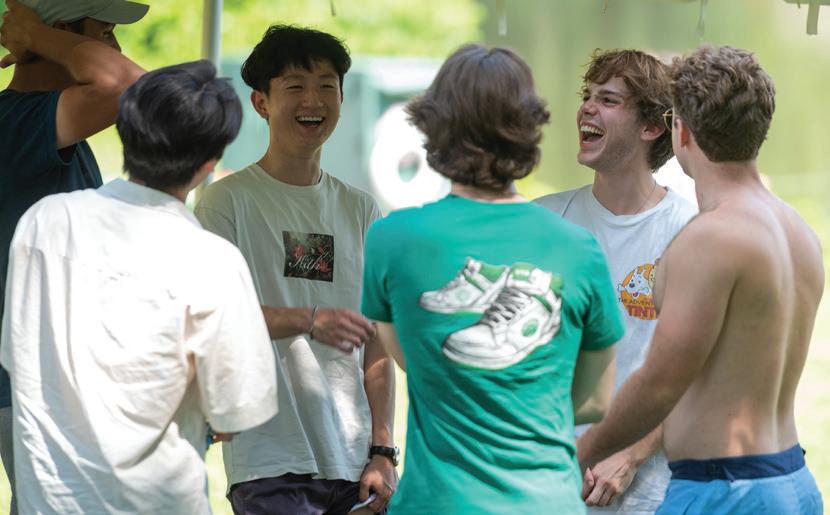

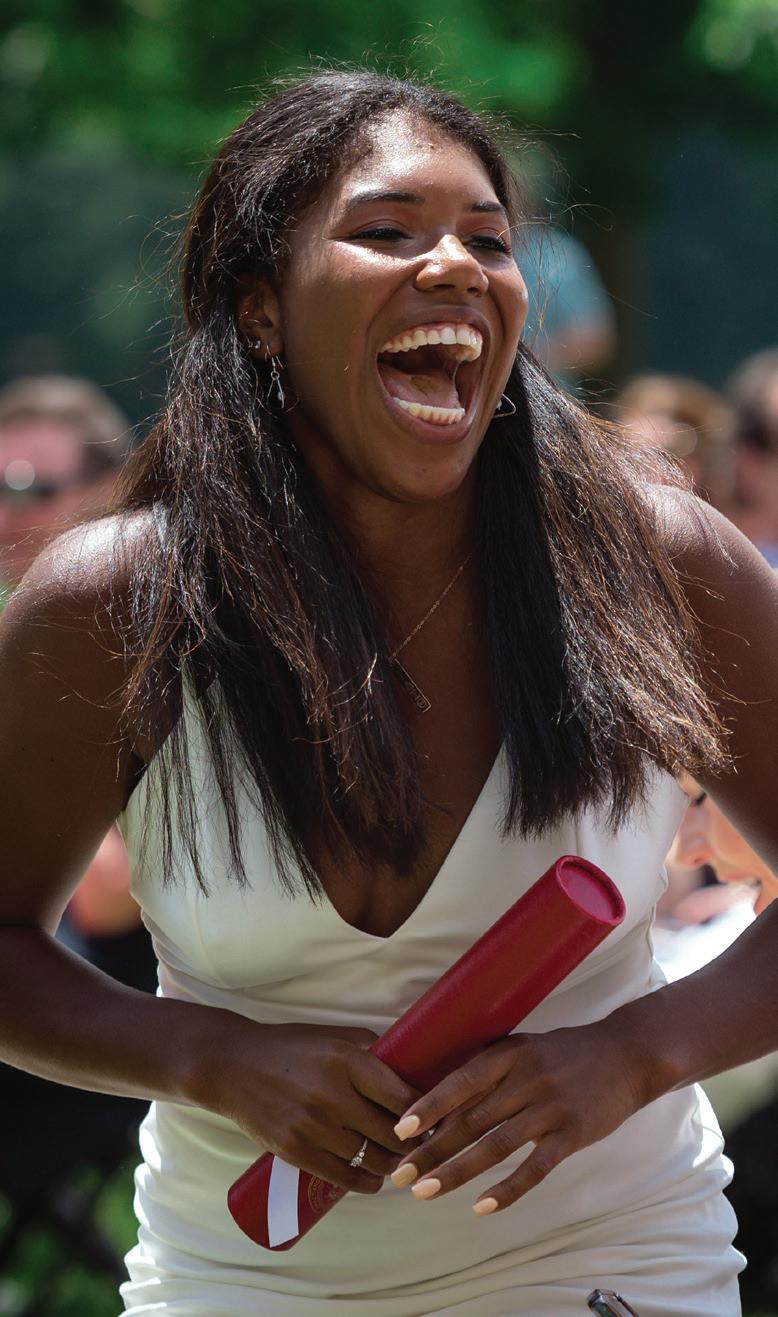
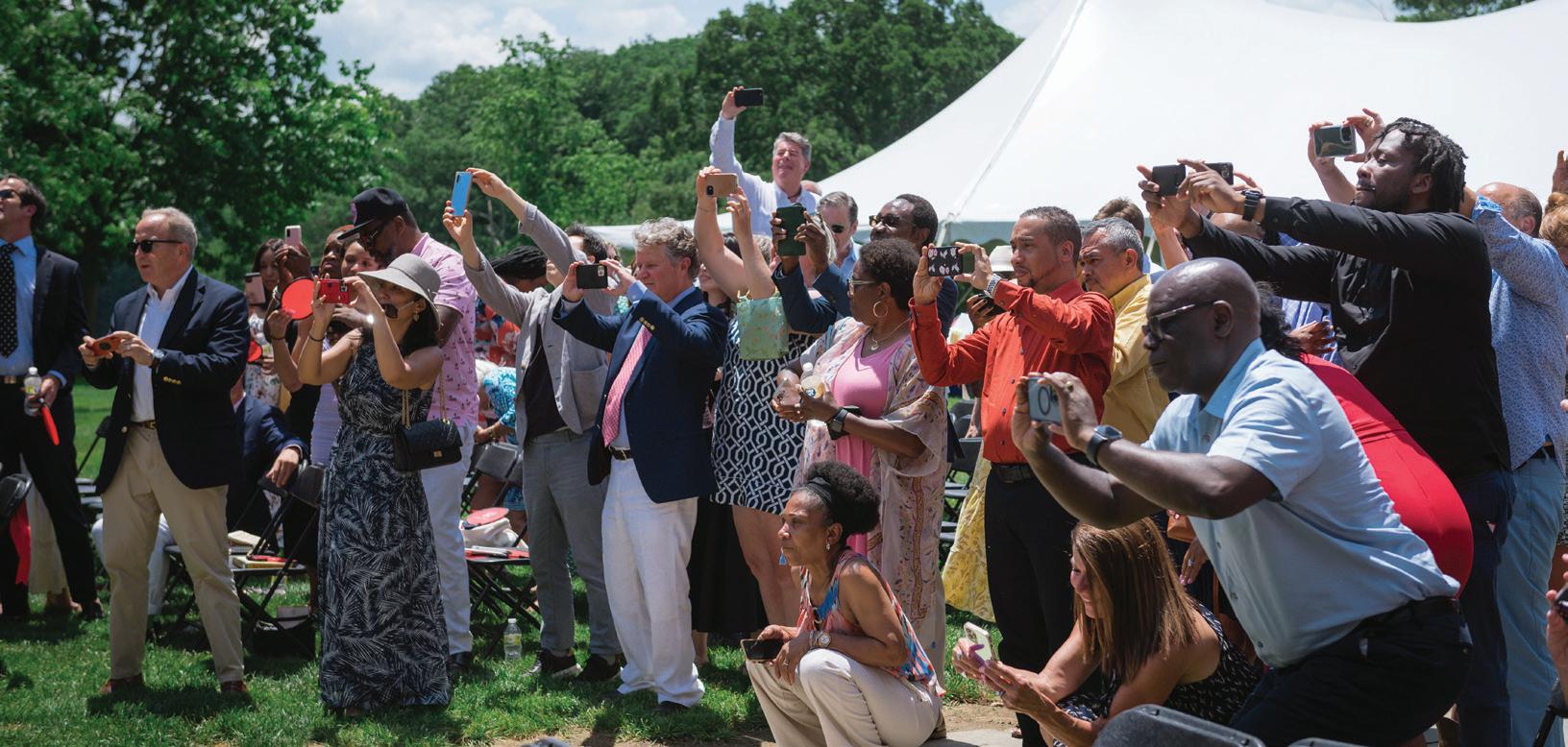

54
/ FEATURE
As Saints, our connections with each other run deep and true, even after we leave this place, and even in those times when we can’t be together. The Class of 2020 might know this better than most. After the pandemic cut their senior year short, the school held their Commencement over Zoom. But on June 9 of this year, they traded their screens for serene blue skies over the Front Lawn at a jubilant do-over two years in the making.
In an inspired burst of just 24 hours, the Class of 2020 made up for lost time. They spent the night on dorm, took advantage of Noxontown Pond in resplendent sunshine, danced at a mini Spring Fling, held prayer service in the chapel, bonded over dinner with faculty and, of course, etched their names into the alumni wall.
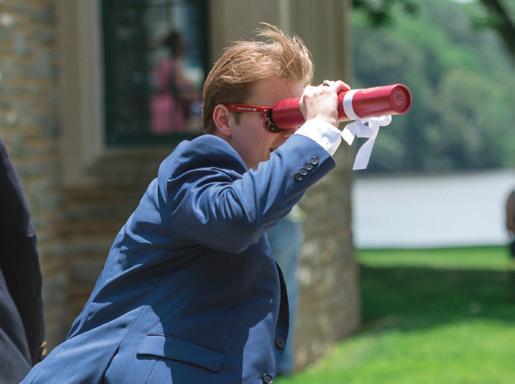
They also took some time to reconnect with an old, familiar friend from spring 2017: the Class opened the letters they wrote to themselves at the end of their III Form year.
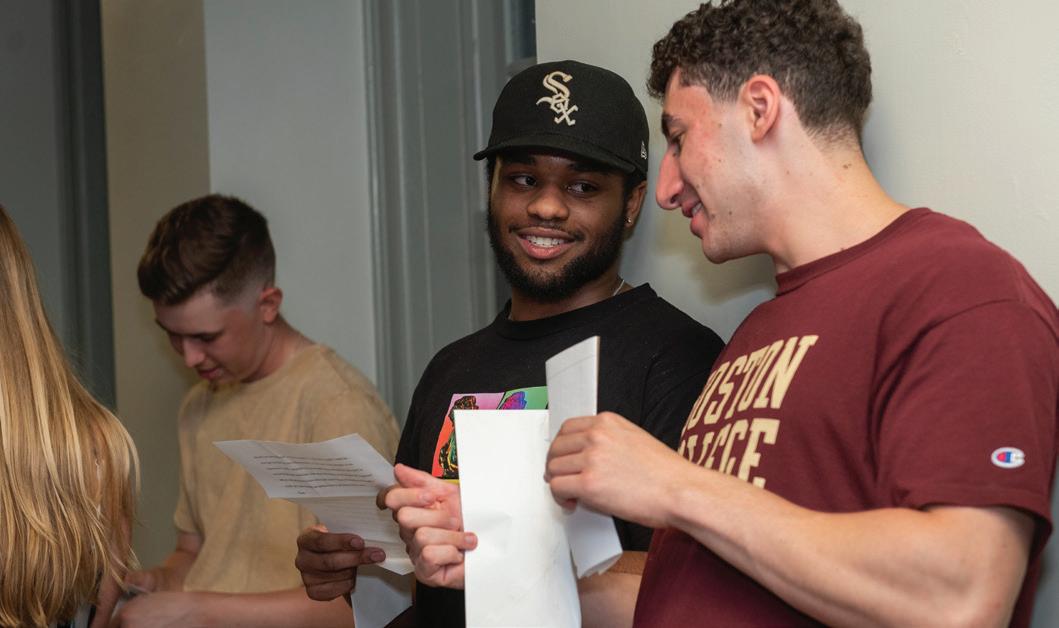
(While we can’t confirm how late they stayed up that night, we can confirm there was a bonfire and revelry on the Front Lawn.)
The class awoke to brunch with their families in the Dining Hall, followed by their diploma ceremony. Former Head of School Tad Roach gave the Commencement address to the more than twothirds of the Class who were able to attend. Class of 2020 students, we were so thrilled to welcome you home. J


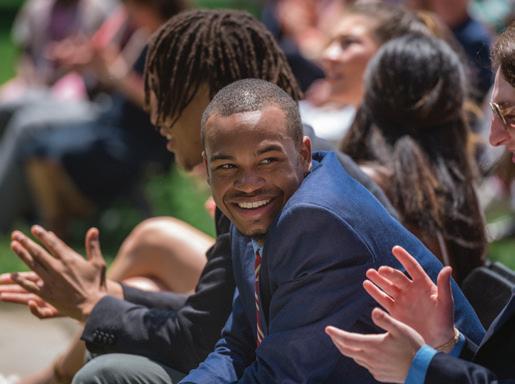
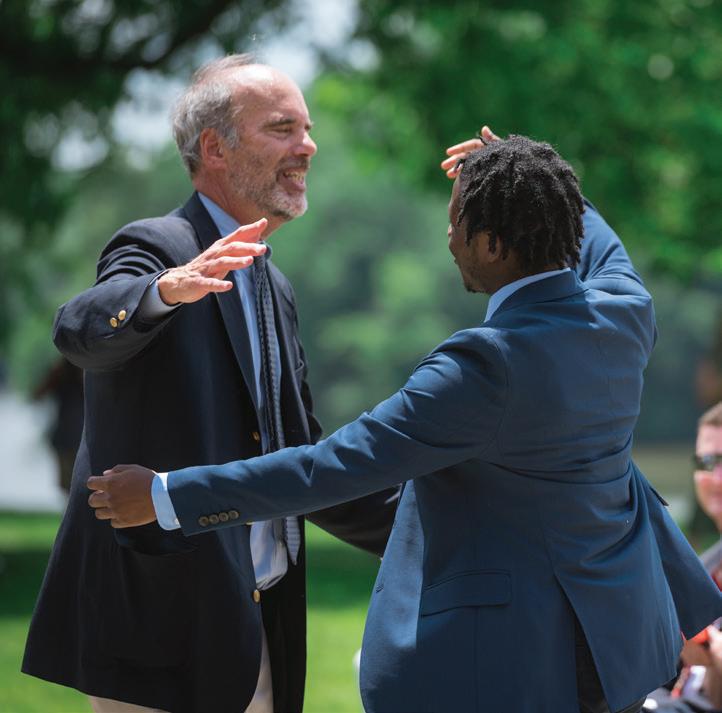
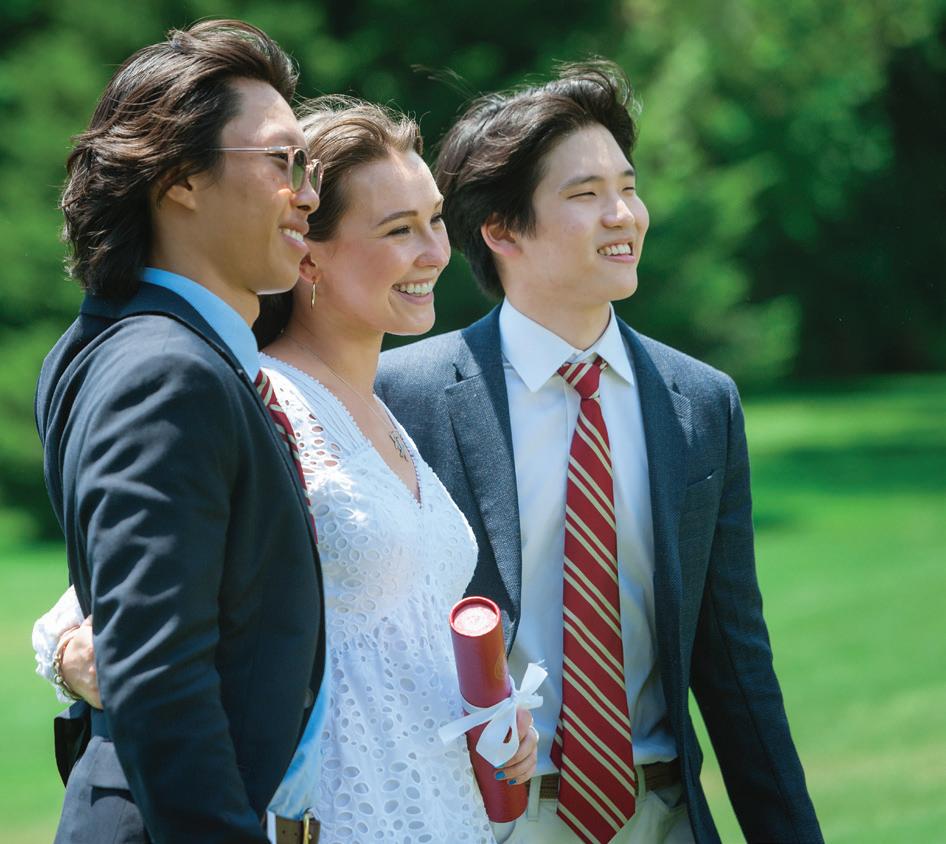
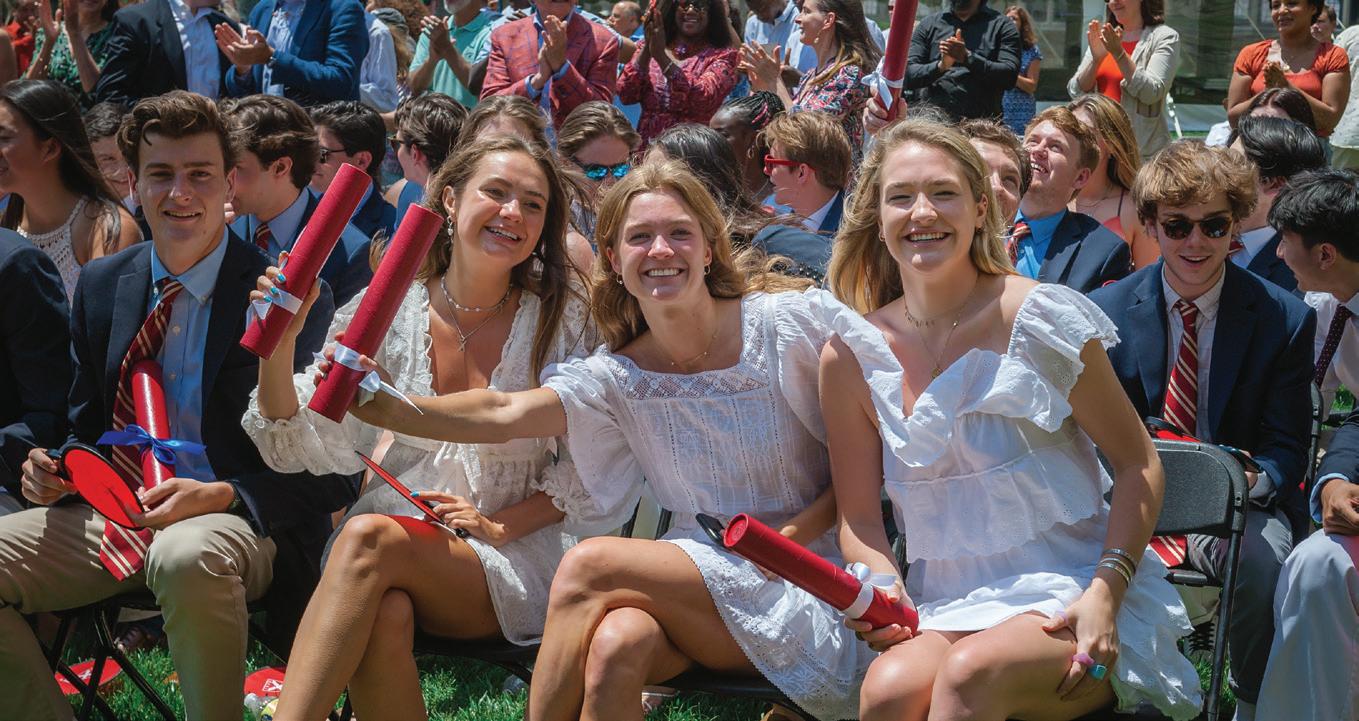
PAGE, CLOCKWISE FROM TOP) The Class of 2020 (not all classmates pictured). • Students carve their name in the alumni wall and read their “letters to themselves.” • Parents and relatives of the Class of 2020 cheer on their graduates. • Bobbi Cooke ’20. • Members of the Class of 2020 reconnect at check-in.
(CLOCKWISE FROM TOP LEFT) Canoeing on the pond. • Eddie Mo ’20, Miles Abney ’20, and Jeffrey Roh ’20. • Former Head of School Tad Roach P’04,’07,’13,’18 goes in for a hug with Michael Kwashie ’20. • Billy Ewles ’20. • Cierra Martinez ’20 catches up with Michael Kwashie ’20. • Ethan Paradee ’20, Zach Tull ’20, and Karim Dahr ’20 read letters they wrote to themselves at the end of their III Form year in 2017. • Logan Cameron ’20, Campbell Nicholson ’20, Ingrid Hoopes ’20, Ruth Lunsford ’20, and Owen Pinto ’20. • Lamar Duncan ’20. • Christine Wu ’20 poses with family.
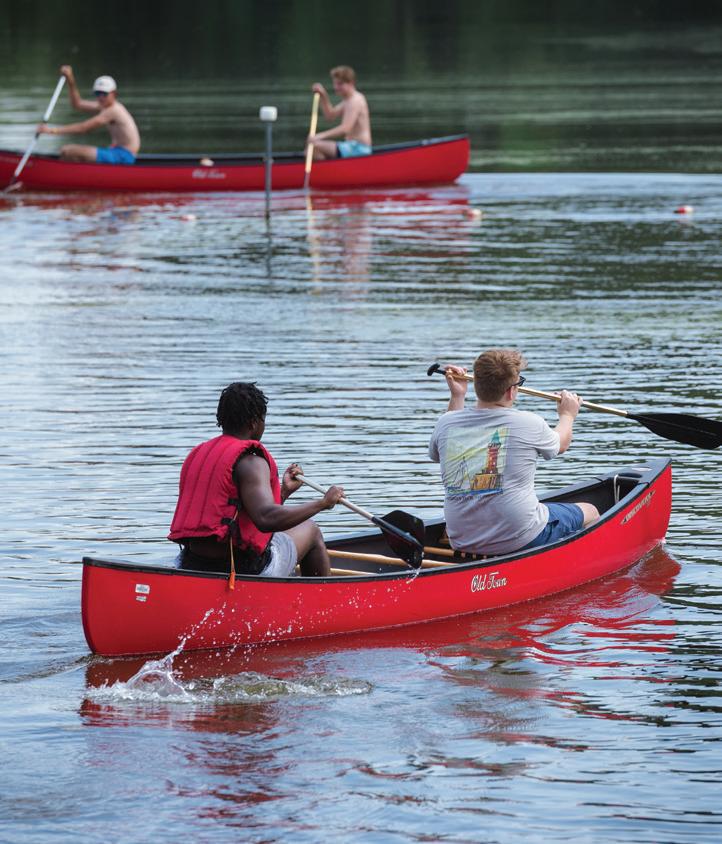
FALL 2022 55
MORE PICS COMMENCEMENT 2020 /
(FACING
BACK together again!

Reunion 2022
Why simply throw a reunion when you can throw a jumbo reunion? That’s the question we asked ourselves over the weekend of June 10-12 when we looked around and saw a flurry of more than 600 alumni and their families enjoying every wondrous nook and cranny campus has to offer.
We feted not only alumni from the current Reunion cycle (Class years ending in 2s and 7s), but also the previous two cycles (Class years ending in 0s, 1s, 5s, and 6s) who weren’t able to gather in person in 2020 or 2021.
Cheers to the Class of 1972, which celebrated its 50th Reunion, and to the Class of 1997, which marked its 25th.
The most senior alumnus in attendance was Walt Liefeld ’54, with Stephen Baldwin ’55 close on his heels. (Fun fact: Stephen and Walt were both on campus to witness the construction of the “new wing and tower” of Founders Hall in the mid-1950s.)
Hugh Cameron ’92 and Breffni Kehoe ’86, visiting from Australia, traveled the farthest to attend Reunion. We also welcomed international travelers from Chile, China, France, Portugal, Scotland, and Spain. In terms of strength in numbers, the Class of 2017 held the title, bringing 60 percent of its class to Middletown.
On Saturday evening, Saints gathered in the Sipprelle Field House for “A Tribute to a School”—a celebration of former Head of School Tad Roach and former Dean of Teaching & Learning Elizabeth Roach, who retired last June and who we were unable to celebrate in person at that time. The tribute included the unveiling of their St. Andrew’s portrait, which will be hung with portraits of other past school leaders in the Dining Hall.
“After this weekend, I think that I realized more than ever that the school itself is a connector of amazing people,” said Luke Baer ’98. “There is an energy that flows through the campus, through the student life, through the faculty, that binds us all together. The campus itself and the school, like anything in life, is flawed. It isn’t perfect. But the experience that we shared there, our connection to each other now because of that shared experience is something to remember, something to celebrate, something from which to grow and enrich our lives.”
We are so grateful to all of our alumni who came back to campus for Reunion Weekend 2022, and sorely missed all those Saints who couldn’t be with us.


FALL 2022 57
REUNION 2022 /
DISTINGUISHED ALUMNI AWARD
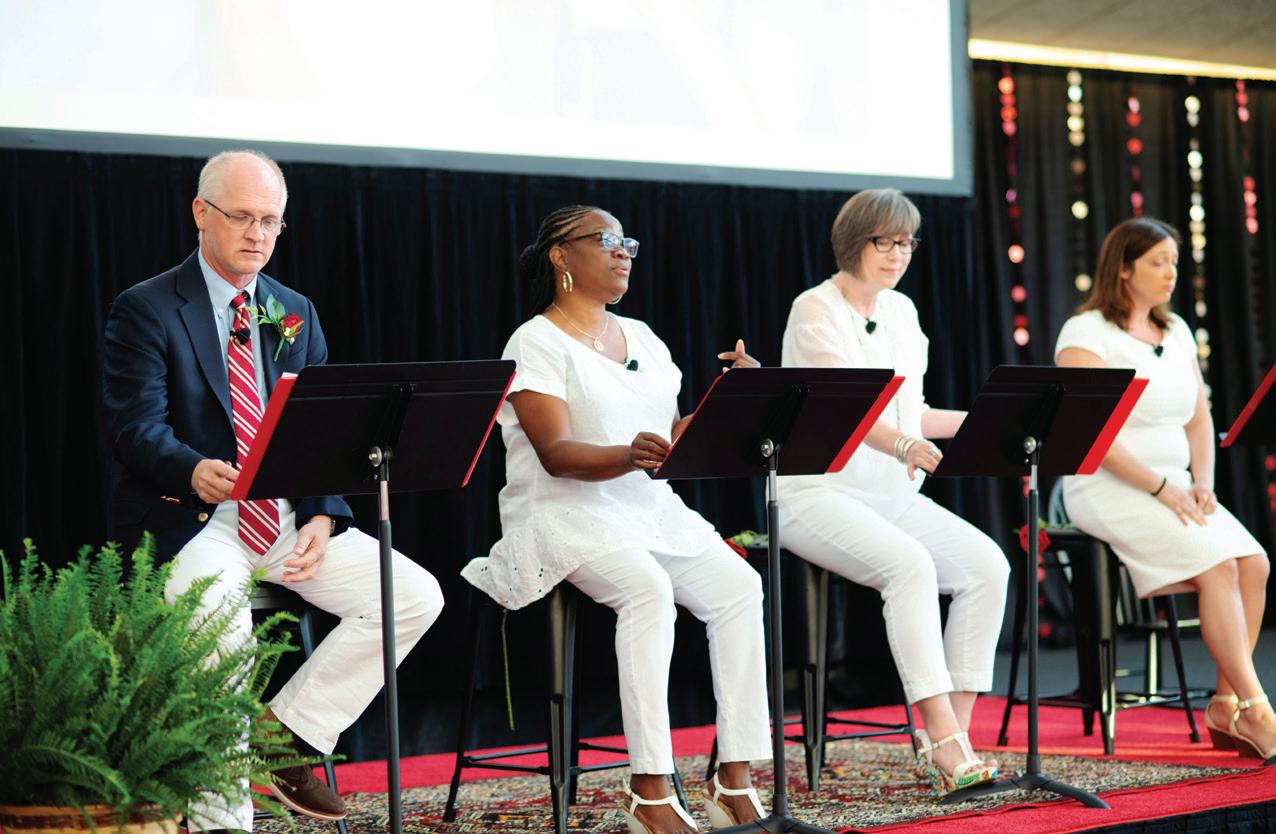
Perry Yeatman ’82 earned this year’s Distinguished Alumni Award. Established by the Class of 1959 at its 50th Reunion in 2009, the Award celebrates the alumna or alumnus who has distinguished themselves professionally, personally, and in service to the community and country with strength, commitment, and perseverance.
“Over the past three decades, Perry has built a track record as a seasoned global business leader, successfully working at the intersection of business and society, leveraging her breadth of experience across sectors, industries and markets to help clients capitalize on opportunities and solve problems in ways that simultaneously deliver economic, social and environmental benefits,” Head of School Joy McGrath said during the award presentation. “In addition, Perry has leveraged her experience to become a recognized expert on women’s career development and advancement. By combining award-winning books, blogs for leading publications, a popular podcast, and a successful consulting and coaching practice, Perry has helped thousands of women not only survive but thrive in their careers. Currently head of corporate partnerships at Save the Children, Perry combines focus, determination, hard work and personal sacrifice with appreciation for the generous support of others in her life’s work to deliver economic, social and environmental benefits.” •
(PREVIOUS PAGE, INSET PHOTO) Former Head of School Tad Roach and former Dean of Teaching & Learning Elizabeth Roach P’04,’07,’13,’18 at their portrait unveiling on Saturday morning.
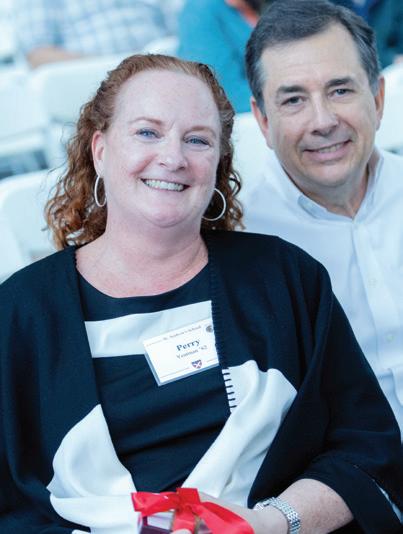
(CLOCKWISE FROM TOP LEFT) Alumni and families gather in the Sipprelle Field House for the Reunion awards program.

• Michael Meers ’86, Bill Brakeley ’86, and Win Goodbody ’85. • Wendy Taylor ’17 (foreground) and Caitlin Cobb ’17 take on a game of cornhole.
• Humanities course alumni snapped a group photo on the Front Lawn with teachers
• Alumni gather in the A. Felix duPont, Jr. Memorial Chapel for the alumni memorial service on Sunday morning.
Elizabeth Roach and Emily Pressman.
• Steve Salter ’77, Chuck Walton ’77, Dick Wiebolt ’71, Sheldon Parker ’71, and Trisha Farinholt.
• Tristan Thomas ’16, Cai Johnson ’16, Mac von Oehsen ’16, and Rooney deButts ’16.
• Peter Hoopes ’89 P’20,’22, Stacey Duprey ’85 P’04,’10, Ann Taylor ’86 P’18, and Jenn Wilson ’03 performed “A Tribute to a School”—a spoken-word theatre production in honor of the Roaches—on Saturday morning.
• Khary Dennis ’12.
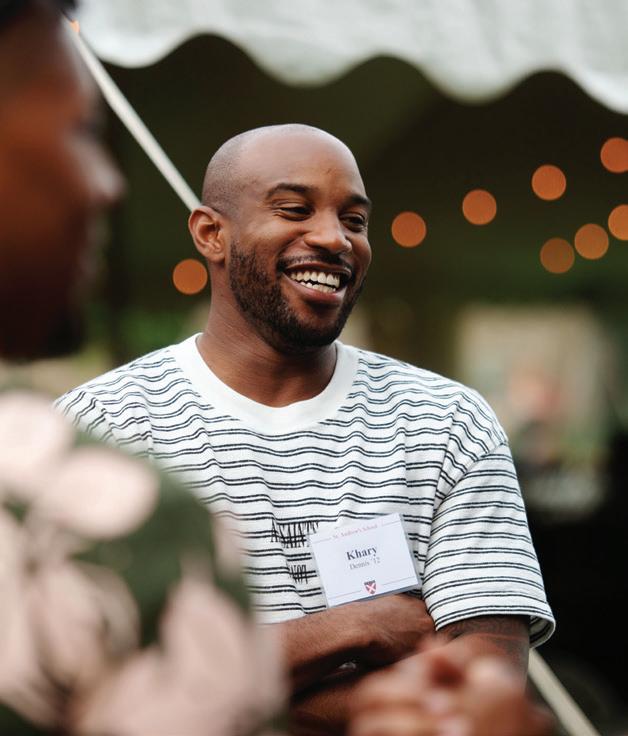
• Alumni gather on the T-Dock on Friday evening.

SAS / ST. ANDREW’S MAGAZINE 58
/ FEATURE
IN PERPETUITY
On Saturday afternoon of Alumni Weekend, we honored two departed alumni for their immense contributions to our school.
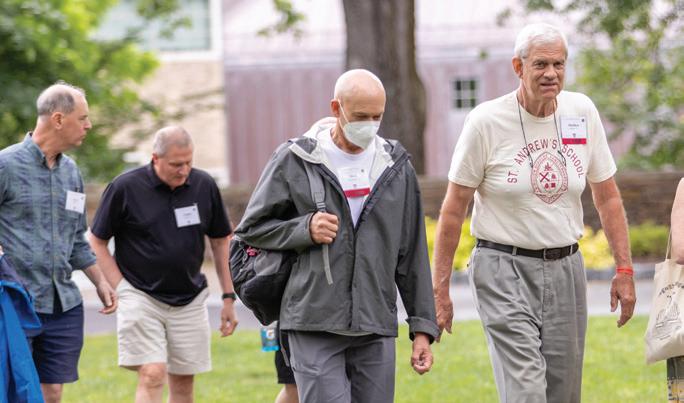
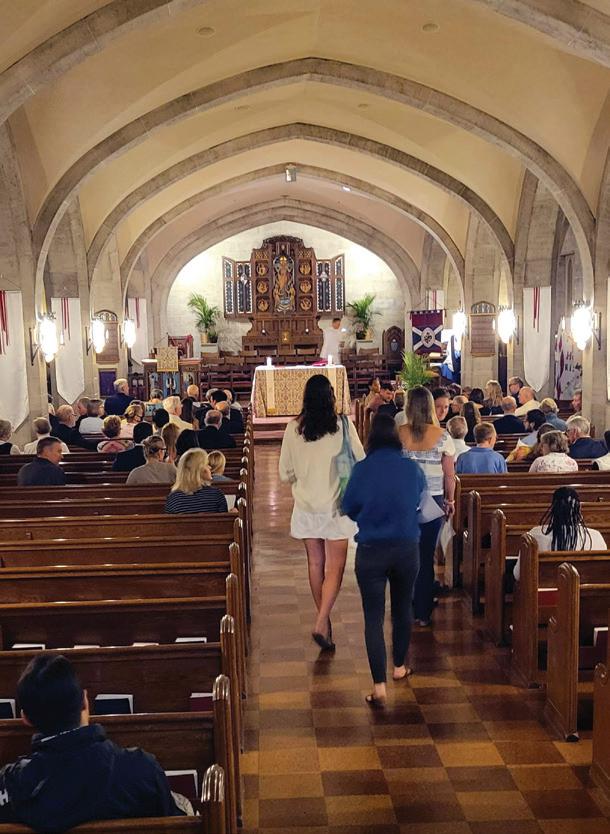
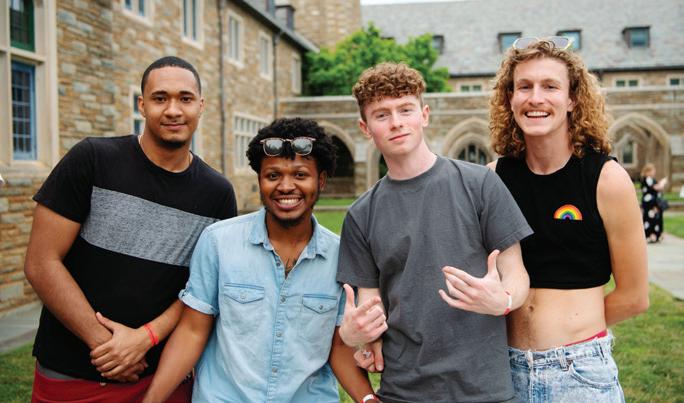
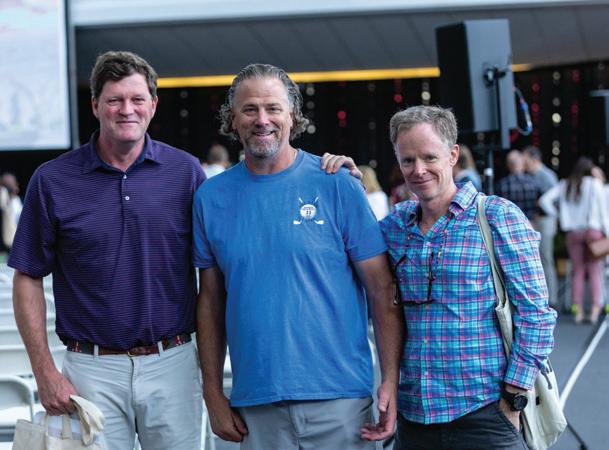
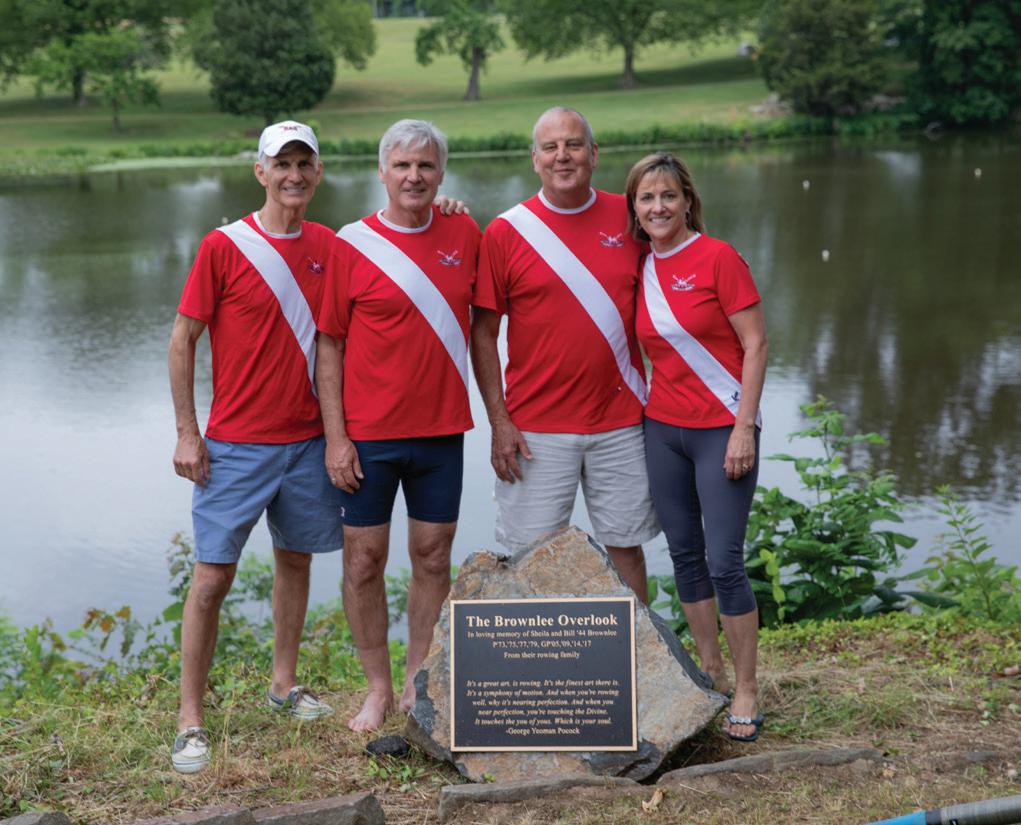
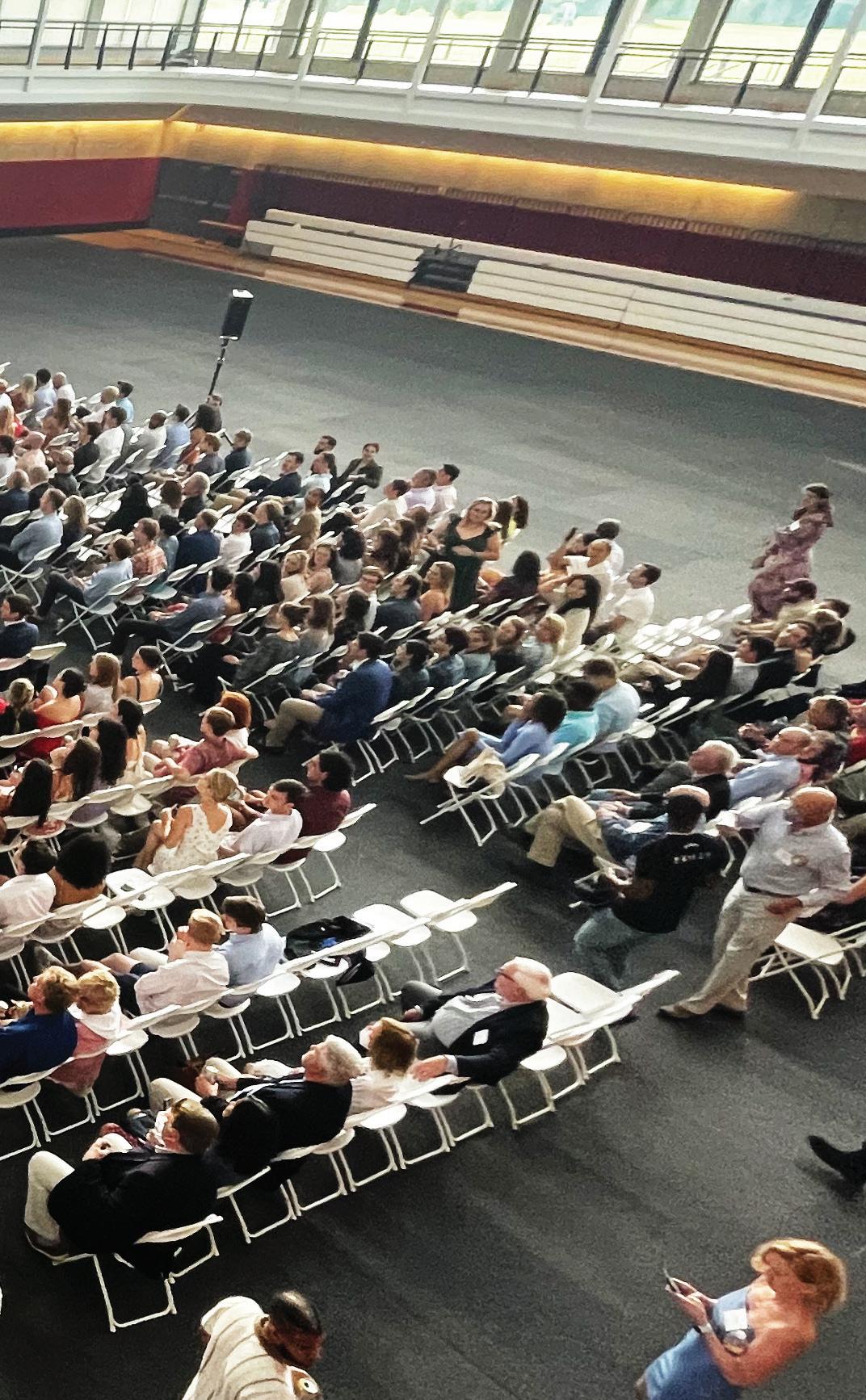
(above) A portrait of Tom Hooper ’71 is unveiled. The portrait of Hooper, the school’s first Black school president, trustee and trustee emeritus, was painted by lifelong friend Rob Seyffert ’71, seen here with Tom’s wife, Diane Hooper. The class also established an endowed fund in Hooper’s name to support his work in recruiting and developing students to become compassionate advocates for diversity, equity, inclusion and social justice.
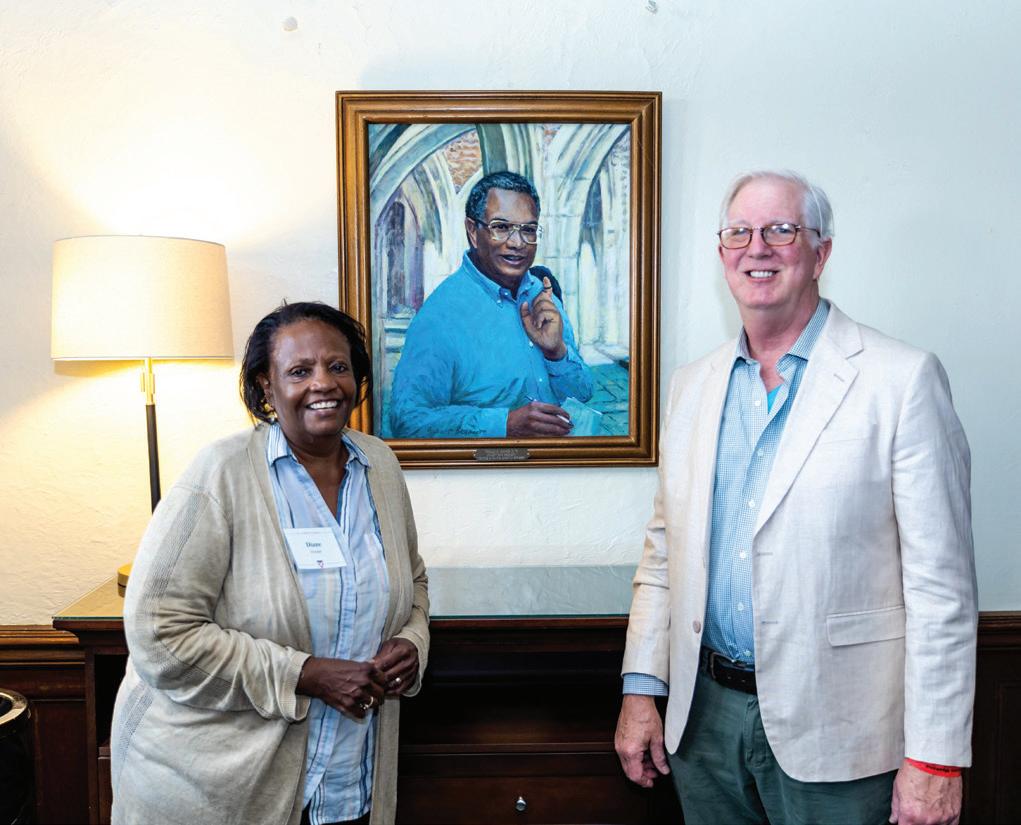
(below) Alumni and their families gather on the lawn behind Trapnell House to pay homage to Bill ’44 and Sheila Brownlee P’73,’75,’77,’79 GP’05,’09,’14,’17 for their lifelong dedication to St. Andrew’s and the school’s rowing program. What was once Alumni Point will now forever be Brownlee Overlook. J

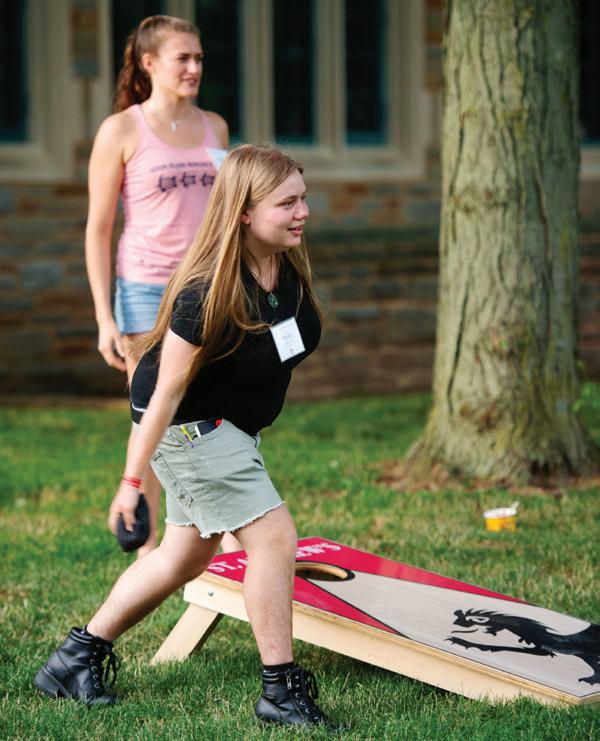
FALL 2022 59
REUNION 2022 / VIEW MORE PICS
From the Archives
“For almost 30 years after the school’s founding, students worked in the kitchen as dishwashers. The job was extremely popular, for two reasons: workers could wear old and comfortable clothes, and they could have as much as they wanted to eat before the school’s meal began. Professional kitchen workers always saw that the boys’ plates were heaped high with the choicest portions available. When student kitchen help was discontinued, several… migrant laborers on surrounding farms were hired to do the job. The popular Jose Fonseca and Arcadio ‘Happy’ FonsecaVasquez, who later transferred to the Maintenance and Housekeeping departments, were among the first.”
—from page 87 of Time to Remember by Bill Amos P’67,’74,’75,’78 GP’03,’10,’11
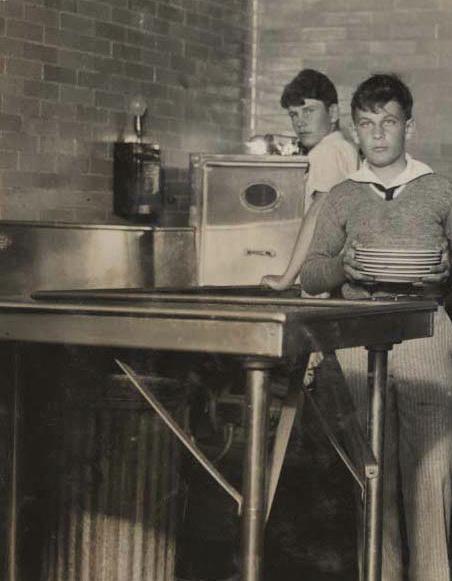 For more memories of Happy, who died early this year, see page 83.
For more memories of Happy, who died early this year, see page 83.
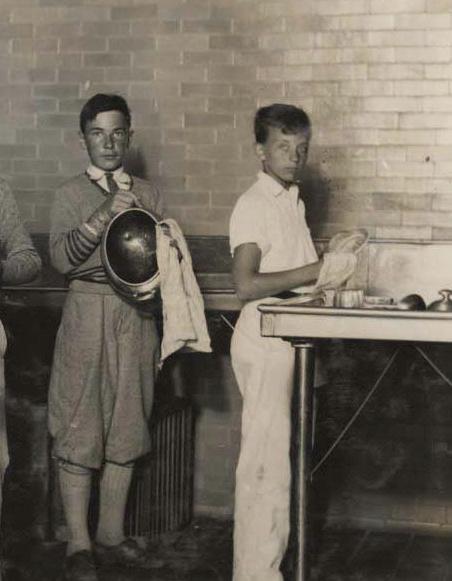
Alumni Reflection
William Hollingsworth Whyte ’35
“American Urbanist” Decades Ahead of His Time
by Charles Kolb ’69
St. Andrew’s alumnus William Hollingsworth (“Holly”) Whyte (19171999) has interested me for decades, beginning when I first heard about him in the mid-1960s.
During my five years as a student St. Andrew’s (1964-1969), Whyte was already a legend: war hero, prolific best-selling author of The Organization Man, Fortune magazine writer, conservationist, and a St. Andrew’s School trustee. You got the feeling that Whyte was someone who made Ches Baum and Bull Cameron—at that time, pillars of the school’s faculty—extremely proud: he knew how to write.
This spring, Richard K. Rein, a New Jersey-based reporter and “sustainable urbanism” advocate, has published a splendid, immensely readable, and thoroughly engaging Whyte biography entitled American Urbanist: How William H. Whyte’s Unconventional Wisdom Reshaped Public Life.
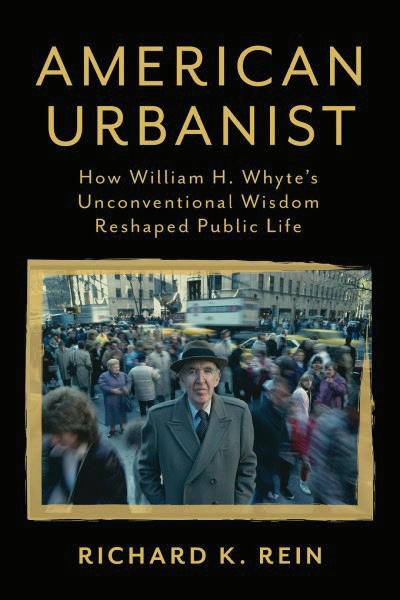
You can enjoy reading Rein’s biography on several levels.
How did St. Andrew’s School shape this remarkable writer and pioneer?
How did Whyte’s devotion to close observation and factual reporting inform his many books and articles?
How did this son of bucolic West Chester, Pennsylvania, and the farmland bordering Noxontown Pond become such a devoted urbanist?
How did Whyte’s celebration of individuality over a more homogenized humanity shape his life and work?
How have his many books on urban planning and the use of architectural space managed to remain so relevant today?
St. Andreans will appreciate Rein’s description of Whyte’s years at the school and their impact on his life. At age 13, Whyte entered St. Andrew’s in the spring semester of 1931 and graduated in 1935, the school’s first graduating class.
At St. Andrew’s, Whyte seems to have developed his lifelong commitments to clear expression and individualism. He credits his adviser, the aforementioned William H. “Bull” Cameron—who was also my adviser decades later—with helping him master the declarative sentence, a style that characterized all of Whyte’s professional writing.
Keynoting the school’s 50th anniversary in 1980, Whyte observed that “[t]he school has always been congenial to self-expression, and the tradition started with Walden Pell.” While his grades were below average, Whyte managed to get into Princeton—thanks primarily to Walden Pell’s strong recommendation— where he majored in English. Following a wartime stint in the Marines, Whyte came on staff at Fortune magazine in 1946, where he remained on the masthead until 1958.
In his most famous bestseller, The Organization Man (1956), Whyte described how organizations function and how they affect the people working
SAS / ST. ANDREW’S MAGAZINE 62 / CAN'T HELP BUT CONNECT
inside them. He became intensely skeptical of business communications and, especially, personality tests: they adversely affect human “intuition, inspiration, perception, and the like.” He examined closely the tensions inherent between people—their individuality and their creativity—and the organizations in which individuals function.
Whyte posited that personality testing harmed individuals and shortchanged organizations by screening out potential nonconformists. He also coined the term “groupthink” and questioned approaches based on credentialism and scientism.
Organizational structures that promoted “instinctive, rationalized conformity,” he argued, would eventually give rise to problems. Whyte would surely be appalled at today’s human relations “profession” that often relies so heavily on algorithms to screen out individuals in the hiring process.
Notwithstanding his “small town” roots, Whyte became one of our most celebrated urbanists, and his passion for New York City, in particular, was exuberant. In book after book— The Exploding Metropolis, Cluster Development, The Social Life of Small Urban Spaces, and City: Rediscovering the Center—Whyte was guided by his intense observational skills to see how people actually moved into and through urban spaces: on streets, through plazas, and around small parks.
Though he would consult tables, charts, graphs, and empirical studies as he formulated his views, he also, for example, studied sidewalk food vendors and people who gathered at street corners. He distrusted abstract theoretical urban-planning approaches
that were divorced from practical reality: “There is no substitute for a confrontation with the physical. You see things that theory misses.”
Decades ago, Whyte worried about the urban inequality that so often plagues today’s cities: “More and more, the city is becoming a place of extremes—a place for the very poor, or the very rich, or the slightly odd.” He could have been writing about many of today’s urban centers.
Consider the impact of COVID-19. How will it influence our use of urban spaces, including, as Rein notes “streets, parking lots, and public spaces”? Whyte raised concerns about our shared use of public spaces years ago.
He was also a generous man who nurtured others along the way. Rein’s description of Whyte’s efforts that launched the career of another famous urbanist, Jane Jacobs, is a fascinating read.
Whyte credits a St. Andrew’s School Commencement speech he delivered in 1946 with shaping his belief that major social advances resulted from someone bucking the status quo—someone who, says Rein, was “ready to ‘blow the lid off everything’ if necessary.”
Rein calls Whyte “a conservationist, an environmentalist, an urbanologist, a sociologist, an urban planner, an urban anthropologist,” and “a public intellectual.” Architecture critic Paul
Goldberger considers Whyte “our prophet of urban spaces,” a man who taught us to “[b]elieve in the fact that the people who use cities are often way ahead of the people who design them.”
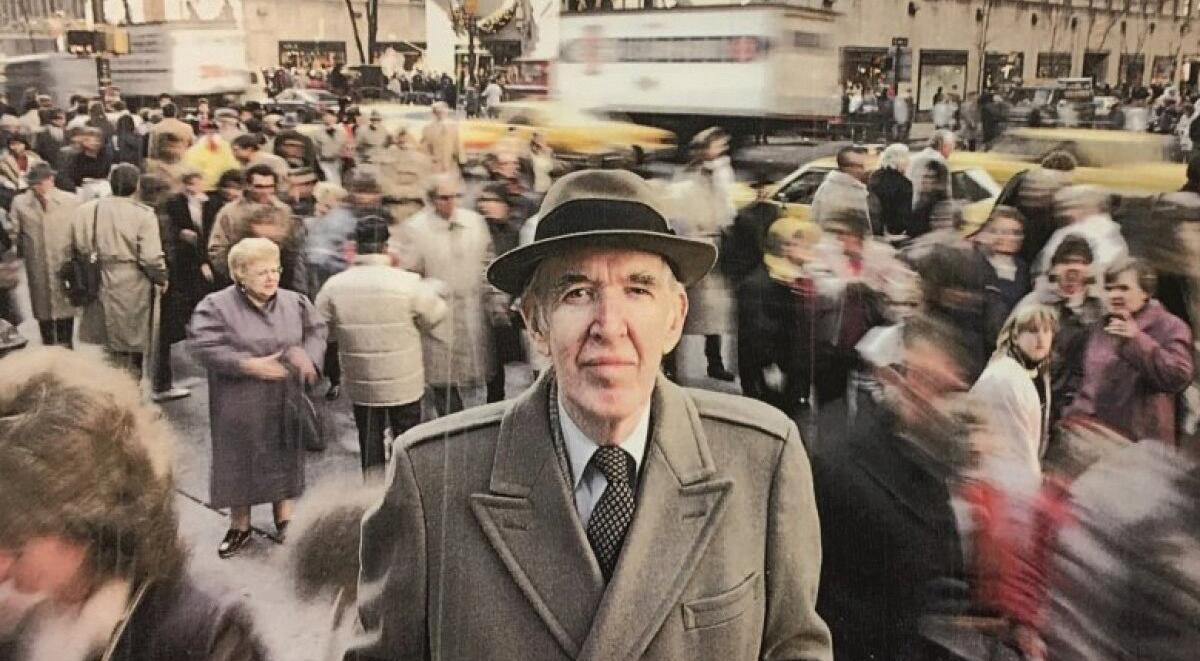
In today’s world of social media connectivity and the craving for instant fame, Whyte remained a true individualist who never sold out to fame and fortune. He became a celebrity—but his celebrity revealed solid substance, deep understanding, clear thinking and writing, and major accomplishments.
In those 50th anniversary remarks at St. Andrew’s, Whyte praised the fact that the school was always “somewhat out of step,” then added that perhaps SAS wasn’t really “out of step enough.” In that regard, Whyte anticipated that legendary “Welton Academy” faculty member, English teacher John Keating, played by Robin Williams in Dead Poets Society
“Seize the day, boys,” Keating urges his students. “Make your lives extraordinary.”
Whyte described, lived, and cherished the essence of St. Andrew’s. Our school made him. He realized the richness of this gift and sought ways to give back to St. Andrew’s. This extraordinary individualist—far ahead of his time on so many issues—teaches us the importance of constantly seeing our world in different ways.
“Carpe diem!” J
FALL 2022 CAN’T HELP BUT CONNECT / 63
Can’t Help But Connect


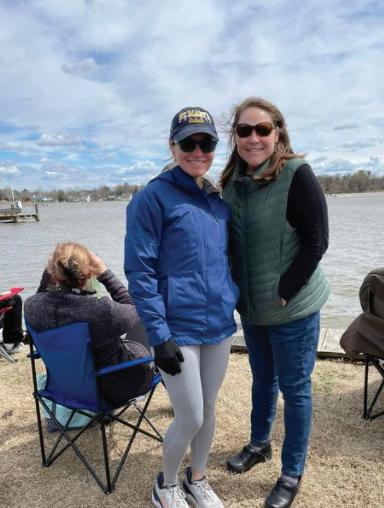
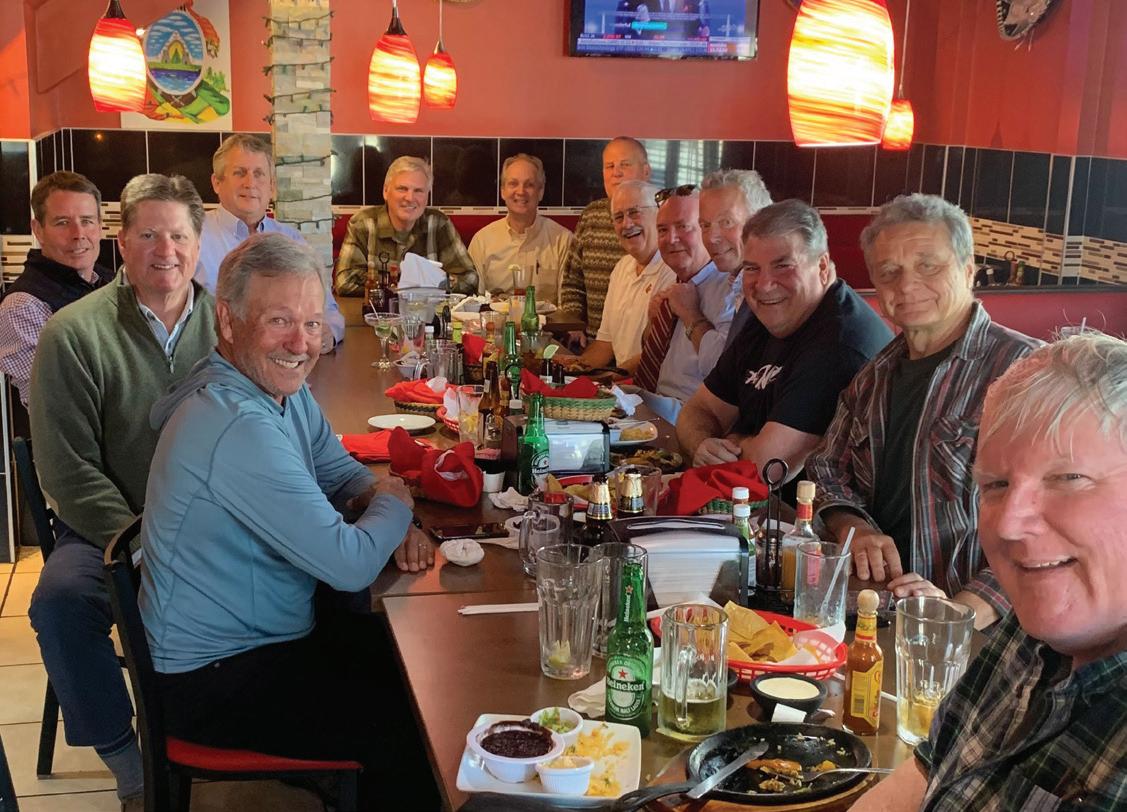
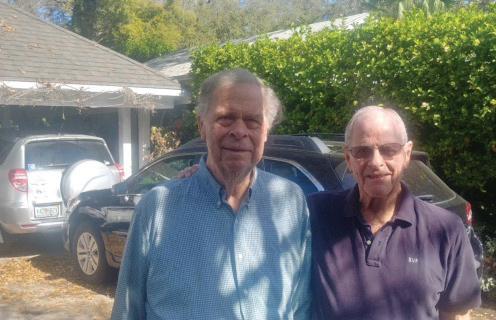
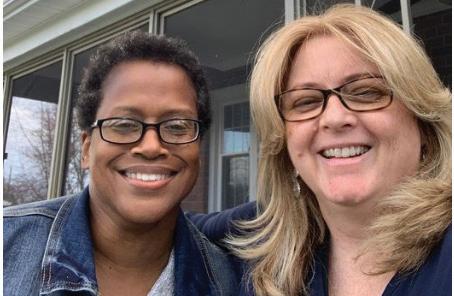
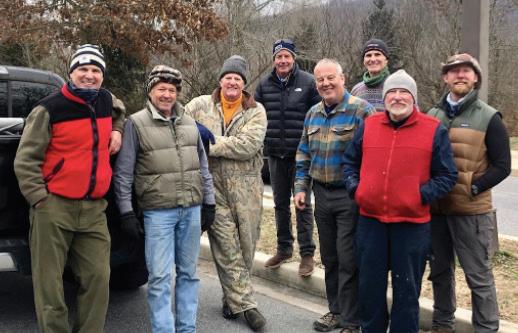
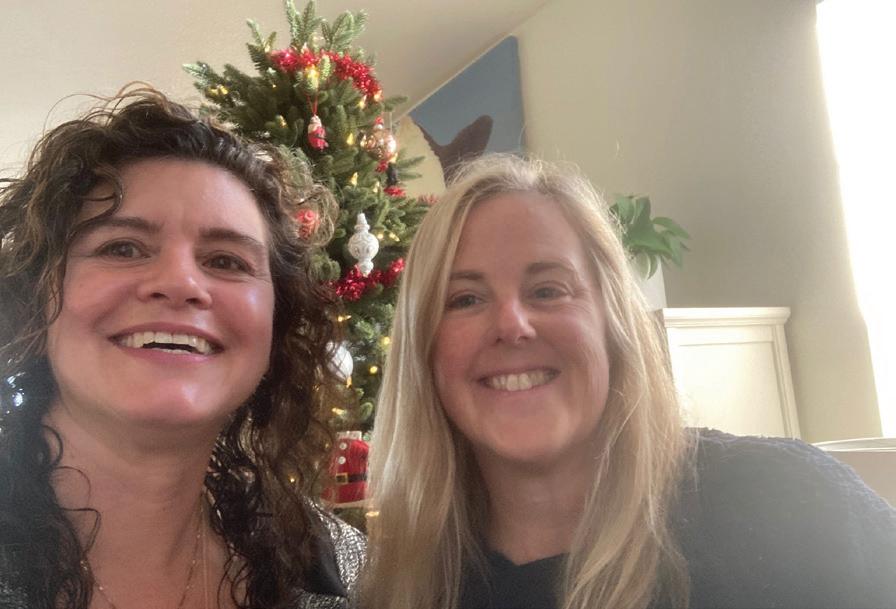

SAS / ST. ANDREW’S MAGAZINE 64 / CAN'T HELP BUT CONNECT
1 11 12 4 7 2 5 8 8
1 1951 classmates Noel Wright and Jack Fiedler gathered at Noel’s home in Isle of Hope, South Carolina. 2 1954 classmates Bill Barnett and David Ralston met up at Bill’s home in Jacksonville, Florida. 3 During a Star Warsrelated appearance at the St. Tammany Collectors Convention in Louisiana in early April, John Morton ’65 caught up with Andy Ringle ’66—“one heavily spiritual and literary dude who drinks life to the lees,” John wrote. “We went to St. Joseph Benedictine Abbey in Saint Benedict, Louisiana. Andy wanted to share some 55 years of perspective with his fellow ‘Moviegoer’ as we walked toward the cemetery. Once there, we meditated at the graves of Walker Percy and his wife Bunt, with whom Andy was acquainted. (Our SAS schoolmate, Jay Tolson ’67 wrote the definitive work on the great man, “Pilgrim In the Ruins.”) Afterwards, we sat on a bench in the shade, ‘talkin’ ’bout our generation’ as we surveyed score-upon-score of grave markers of departed monks. Every so often, living seminarians and monks in their black albs, two-by-two in soft conversation, strolled along the paths. It was timeless. Deep. Righteous. And the Mandalorian in me thought for a moment… ‘This is the Way.’” (See page 65 of the SAS Magazine Winter Review 2022 issue for the backstory of John’s Star Wars involvement.) 4 The Class of 1975 got together for their 47th annual—yes, you read that right!—winter camping trip, held this year during a nor’easter! Seen left to right are Gordon Brownlee ’75, Bill Shields ’75, Bob Greenlee ’75, Chris Walsh ’75, Ian Brownlee ’73, Steven Brownlee ’77, and friends Van and Andrew Button. 5 The Class met up again this spring, this time for lunch on the Eastern Shore of Maryland. Pictured (all Class of 1975 except when noted) are: Bill Shields, Bob Greenlee, Chris Walsh, Tripper Showell, Gordon Brownlee, Dave Strong, Ian Brownlee ’73, Jamie Gerrish, Pete Schaeffer, Mike Kadick, Tyler Johnson ’76, Norman Ware, and Chris Gale. 6 On the dock are Bill, Tripper, Scruffy, Norm, Jamie, Bob, and Dave. 7 Lela Demby ’84 and Valerie Stevens ’84 met up at Valerie’s home in Glenolden, Pa. 8 Melissa Batie Lahey ’91 and Susan Willock ’89 met up to watch Washington College crew races in Chestertown, Md., this spring. 9 Darron Mills ’89 and Victor van Buchem ’89 “caught up to kick off Vic’s spring break. A wonderful home cooked meal prepared by Kimberley (Mills) was soothing after a long drive and happy we can take time to be together.”

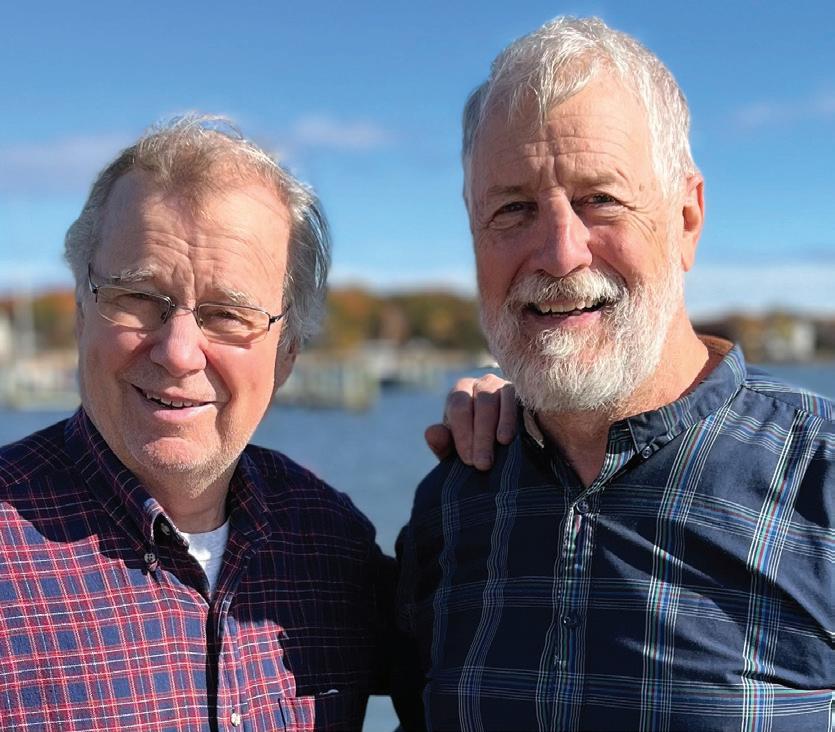
10 Philadelphia Union fans Cal Hurtt ’90, Taylor Cameron ’90, and Dixon Shay ’89 met up at Subaru Park in Philly to watch some Major League Soccer. 11 The Class of 1989 Loves to Connect! Rebecca Wendell Watters and Amy Wilson got together over the holidays. 12 Class of 1989 women gathered at the shared vacation home of Catherine Pomeroy ’89 and her sister Nancy Beth (Pomeroy) Garrett ’83 in Tennessee for a few days of chatting, good food, and mountain adventure. In attendance were Megin Adams, Barrett Brewer, Allison Hamilton-Rohe, Melissa McLoota, Catherine, Zibby Hammond Pyle P’21, Kristen Kreuzkamp, and Susan Willock 13 Hiking in Patapsco State Park: Becca Wright ’82, Mike Berrigan ’79, Jeff Lilley ’82 P’21,’21, Eric Olson ’82, Bruce Colburn ’82, and Lynn Lilley ’82
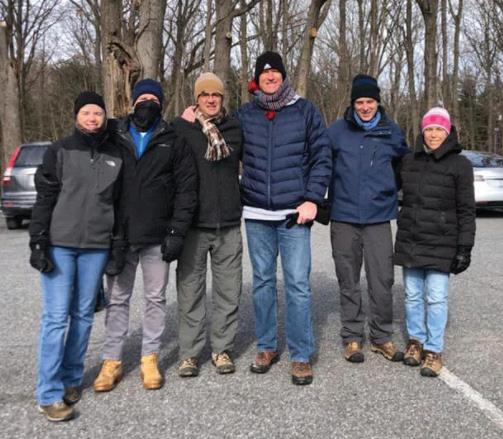
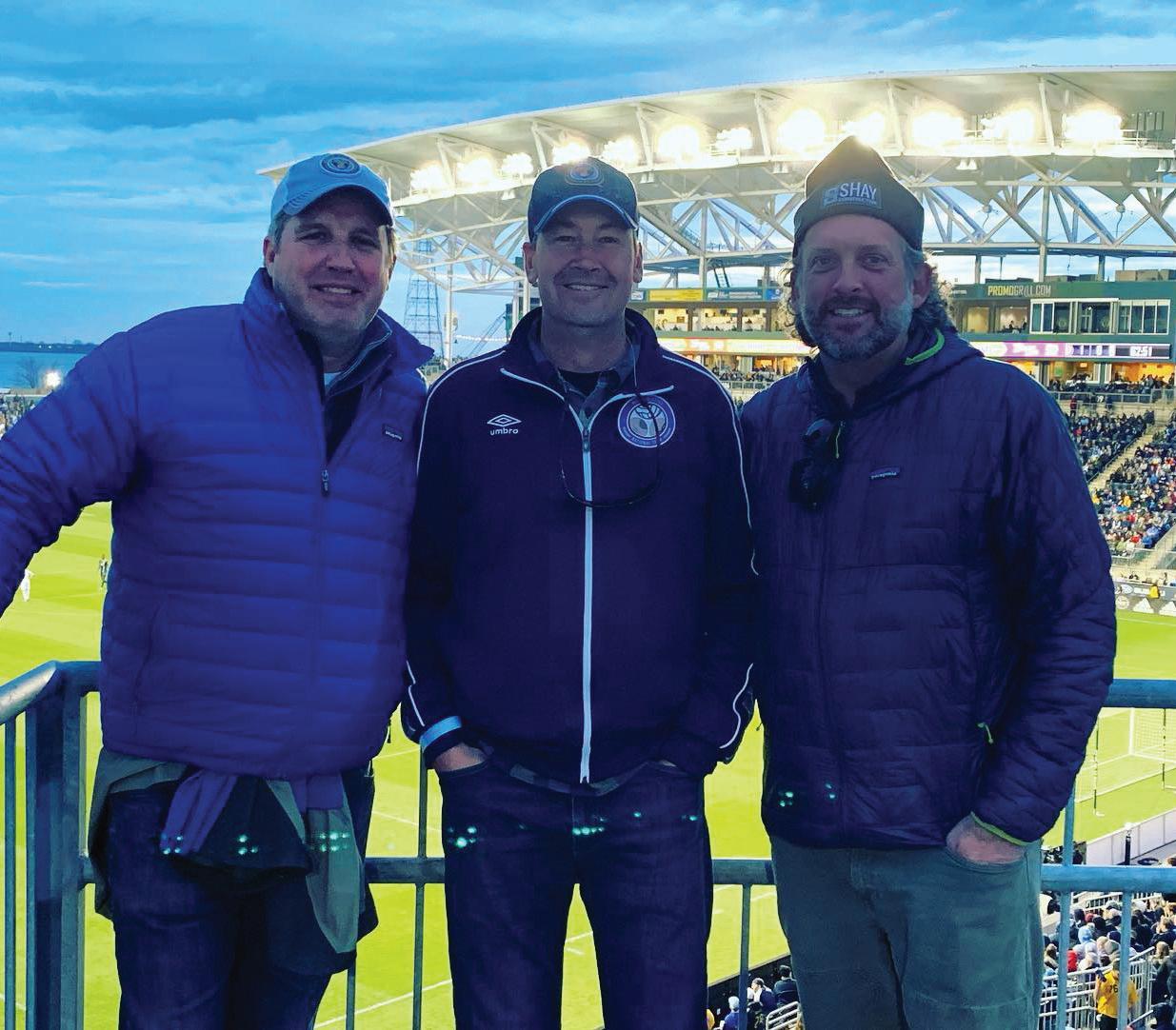
FALL 2022 CAN’T HELP BUT CONNECT / 65
3 6 10 13
Saints on Social
Did you know you can connect with your fellow Saints on LinkedIn?


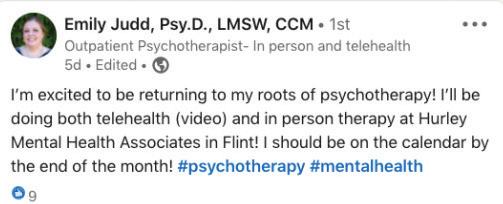
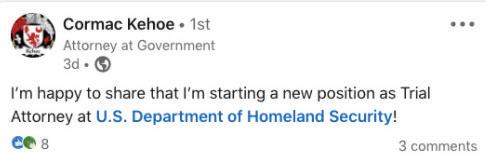
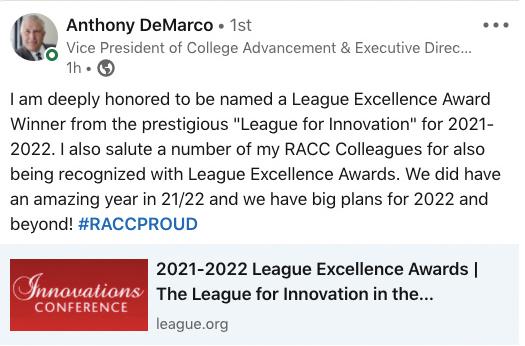
Join our closed group for alumni— search groups for “St. Andrew’s School (DE)”—and be sure to add St. Andrew’s School to your education history in your profile. LinkedIn is a great way to not only share your professional news, but to share job opportunities and recruit St. Andreans to your place of work.
You can also connect with Saints and St. Andrew’s on:
FACEBOOK
Join our closed group for alumni —search for “St. Andrew's School (DE) Alumni”— and like/follow our school Facebook page @SASdelaware.
INSTAGRAM
@SASdelaware
@SAS_athletics
@life.in.obrien
TWITTER
@SASdelaware for athletics news and updates!
TIKTOK (Yes, we’re on TikTok!)
@SASdelaware
Enjoy content created by current students.
SAS / ST. ANDREW’S MAGAZINE 66 / CAN'T HELP BUT CONNECT
Anthony DeMarco ’80 was recognized for his leadership at Reading Area Community College.
Cormac Kehoe ’87 shared news of a new position on LinkedIn…
… as did Emily Judd ’96
… Sulaiman Jenkins ’99…
…and Jamie Devereux ’06!
Saints on Social

Art Butcher ’88 shared on LinkedIn: “March marked the launch of our Boston Scientific R&D Center in Pune, India. It was my privilege to join the local R&D team… for the inauguration of this center, our second in India. I often talk about the positive energy that comes from teams being back together in person, and that has certainly been evident throughout this trip… India’s healthcare plans strongly resonate with our mission to transform lives through innovative medical solutions that improve the health of patients around the world. We are excited to be a continuing part of India’s innovation journey.”

Christina
Anna Vocino ’91 and her lifestyle brand Eat Happy Kitchen were recently featured on the podcast “Second Act Stories.”

Illustrator Christopher

recently published watercolor and gouache illustrations of plants in Flora Magazine, published by the California Native Plant Society.
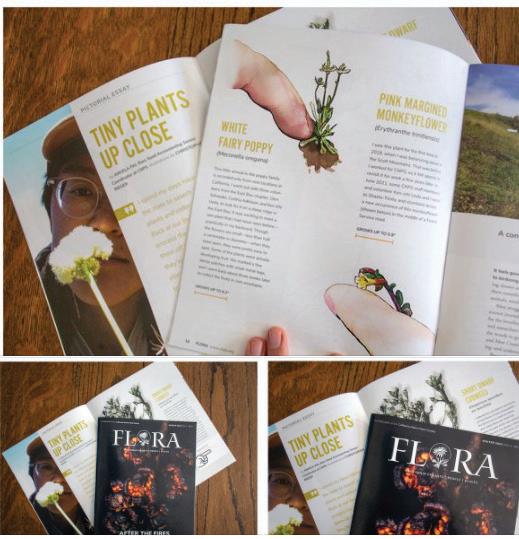
FALL 2022 CAN’T HELP BUT CONNECT / 67
(Robbins) Cain ’90 shared that her translation of a popular Swiss travel guide is finally in print!
Reiger ’95
Dominique Fontanilla ’99 was recently recognized and promoted for her work in pharmaceutical research:

JJ Geewax ’05 has written a book on application programming interface (API) design; fellow software engineer Wes Doyle ’04 gave him a shoutout on LinkedIn:
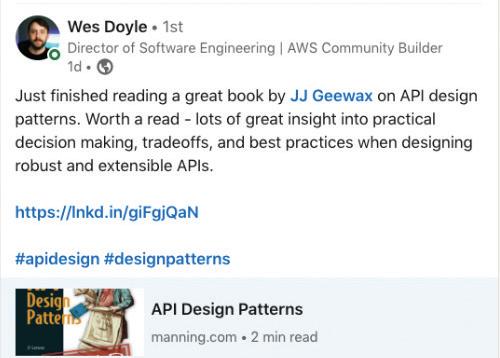
Searcy Milam Morgan ’02 was named one of the top fifty women leaders in Austin, Texas, by Women We Admire; she was recognized for her work as founder and director of Matterlab, an organization working to “reimagine systems around equity in education.”
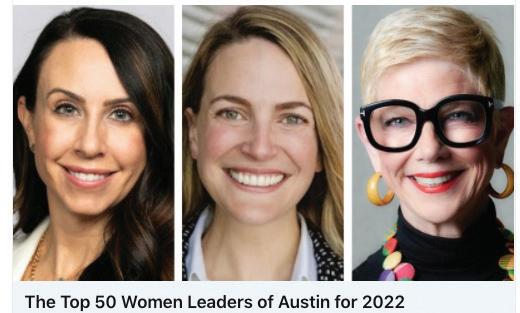
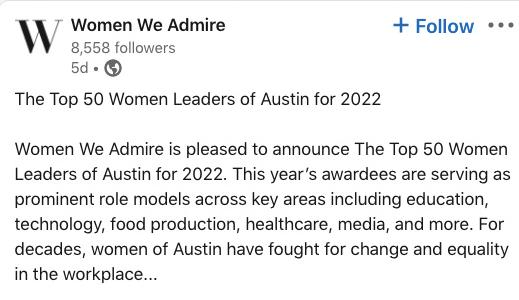
We spotted Ike Amakiri ’12 in this photo (third from left) shared on LinkedIn by his orthopedic trauma surgery colleague Dr. Christian Pean, who wrote: “Black men make up less than 2% of practicing orthopedic surgeons in the US, but on this unique day we were 100% of the orthopedic surgeon team in OR 70 at Massachusetts General Hospital.” Ike received his MD and MBA from Dartmouth in 2021, and is currently an orthopedic surgery resident at Mass General.

And, bringing things full circle, earlier this year Holley McShan ’15 accepted a position as a software engineer at… you guessed it… LinkedIn!

SAS / ST. ANDREW’S MAGAZINE 68 / CAN'T HELP BUT CONNECT
Randy Brinton ’64
You may have heard the phrase “triple threat” used in reference to faculty; the phrase refers to faculty who teach, coach, and serve as dorm parents. Well, Randy Brinton ’64 can be considered a triple threat alumnus—over the years, he’s served as Class Agent, Alumni Board member and officer, and Trustee. He’s been on both sides of the advancement table—the giving side, and the soliciting side.
In March, Randy and classmates Steve Ockenden, Rig Baldwin and Al Day took a stroll around campus, down memory lane, and up on A Corridor (today known as Sherwood), and also witnessed a student chapel service on the Front Lawn—a celebration of Holi, the Hindu rite of spring. The service was quite a different scene from their days, but all remarked that the foundations that were central to their St. Andrew’s experience were still apparent, even among the clouds of colored Holi powder.
Part of the reason for their visit, unbeknownst to Randy, was to recognize Randy’s longstanding commitment to St. Andrew’s. The group gathered in the office of Head of School Joy McGrath ’92, who presented Randy with a resolution from the Board of Trustees that highlighted his “unique abilities, integrity, passion and commitment…his commitment to public service, persistent energy, and love for and service to St. Andrew’s School and St. Andreans.” From generations of Saints current, past, and future: thank you, Randy! J
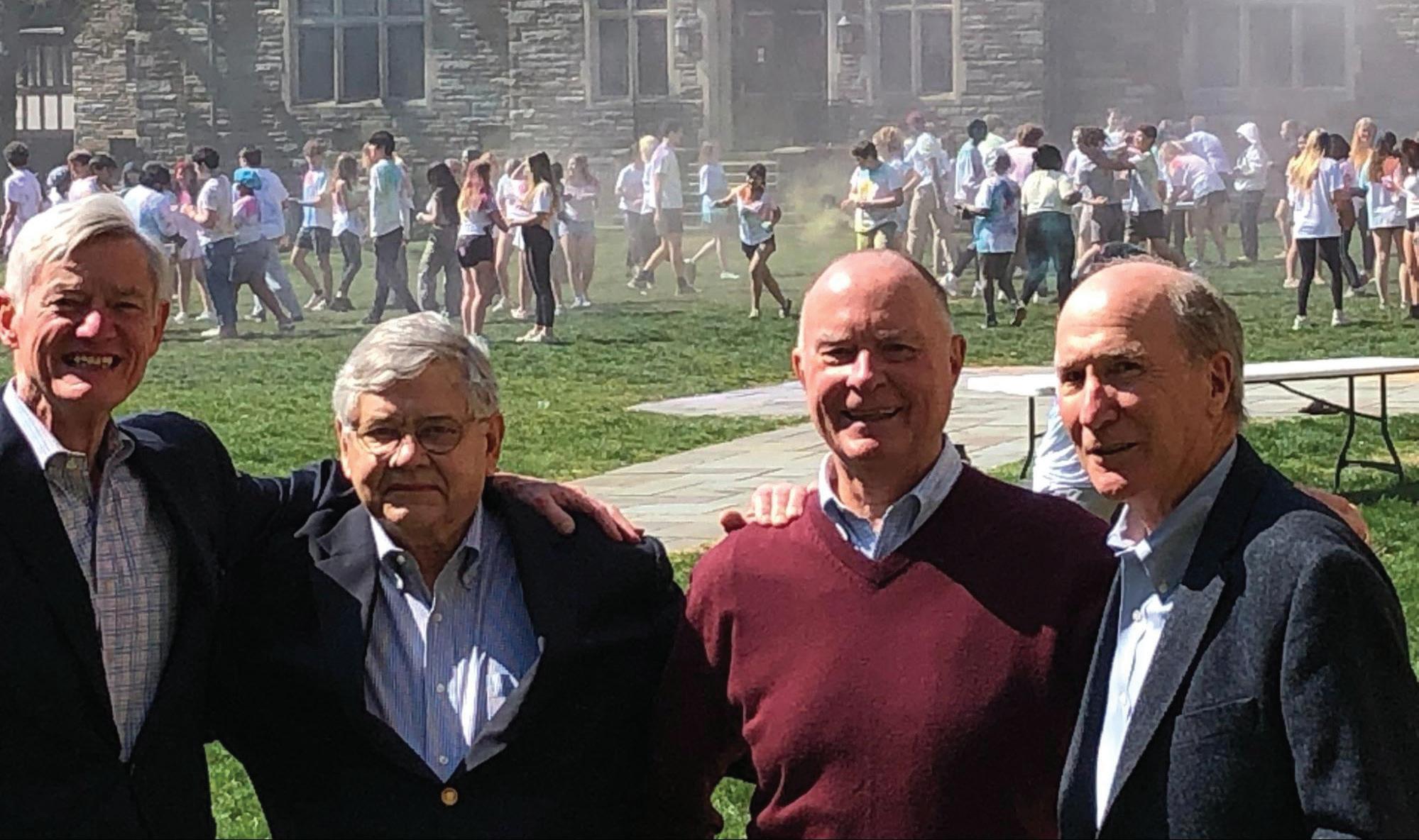
FALL 2022 CAN’T HELP BUT CONNECT / 69
(right) Randy Brinton, Steve Ockenden, Al Day and Rig Baldwin, all Class of 1964, pose on the Front Lawn while the chapel service in celebration of Holi unfolds in the background.
VOLUNTEER SPOTLIGHT

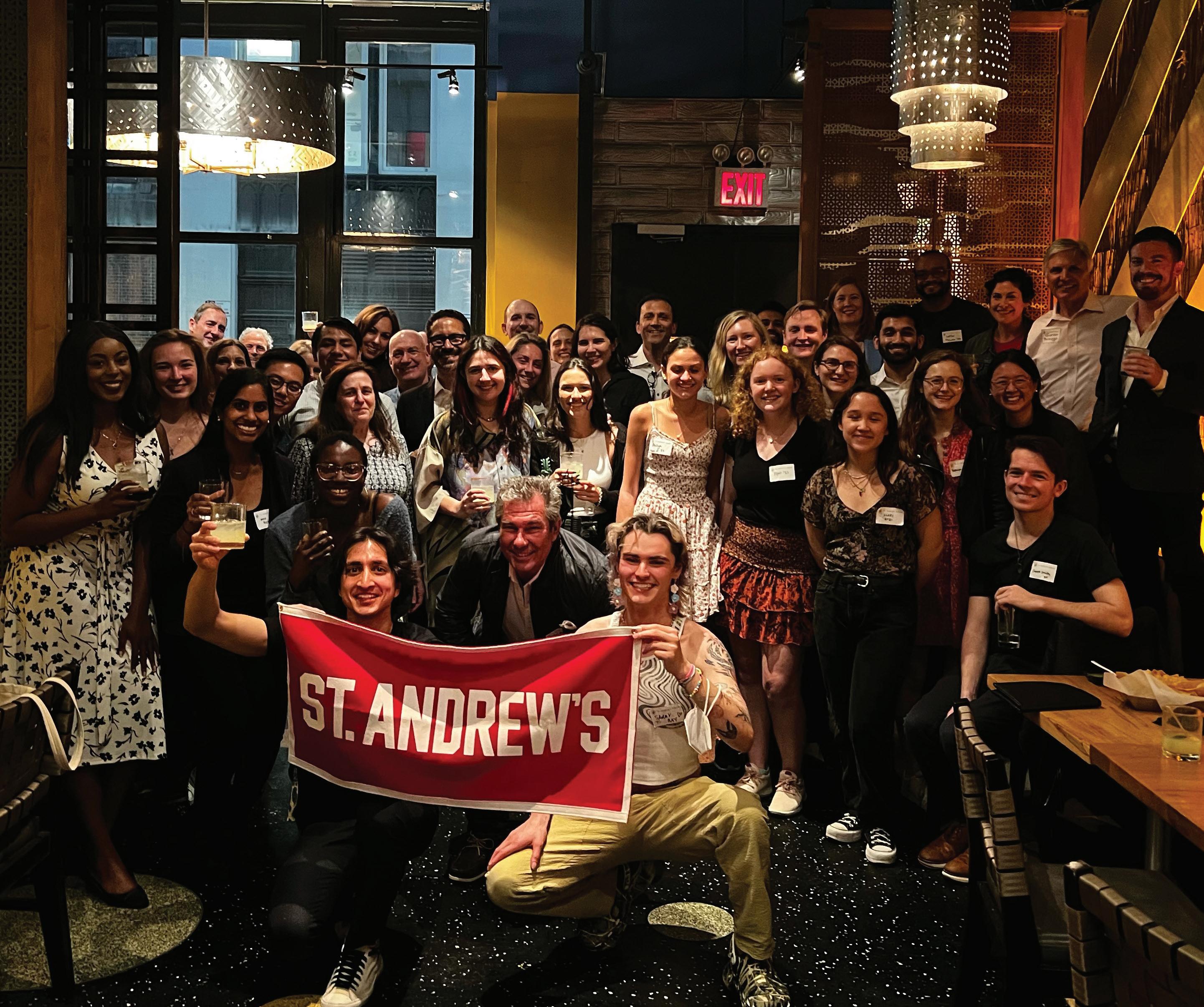
SAS / ST. ANDREW’S MAGAZINE 70 COAST TO COAST TOASTS BRING US TOGETHER! Visit standrews-de.org/front-lawn to see more photos from this year’s Toast. / FEATURE BOSTON, MA NEW YORK CITY


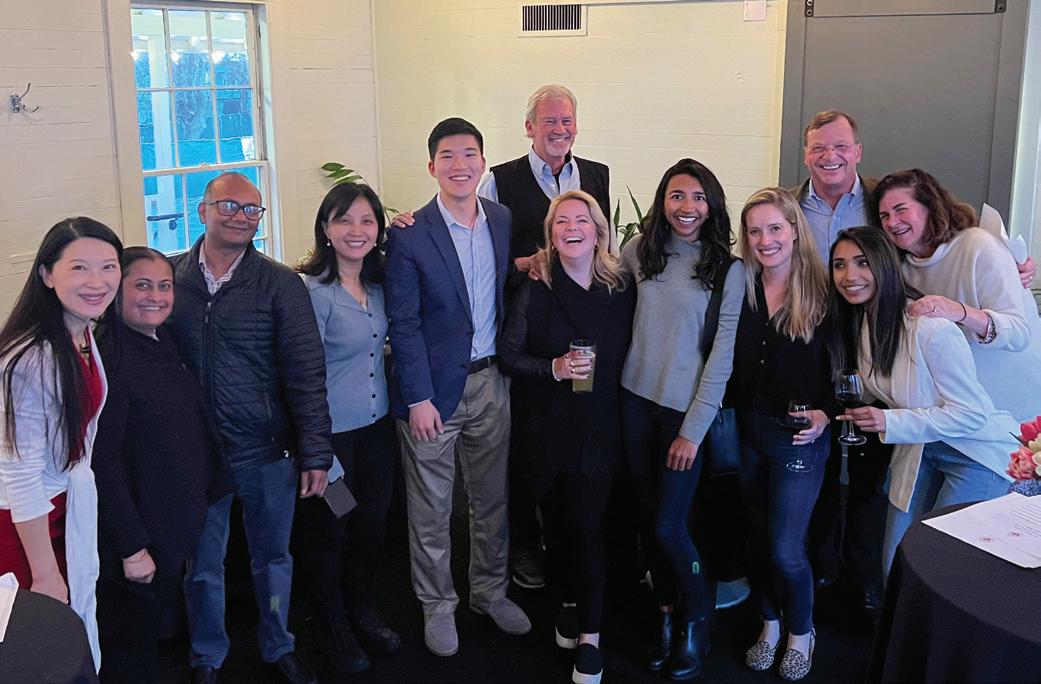

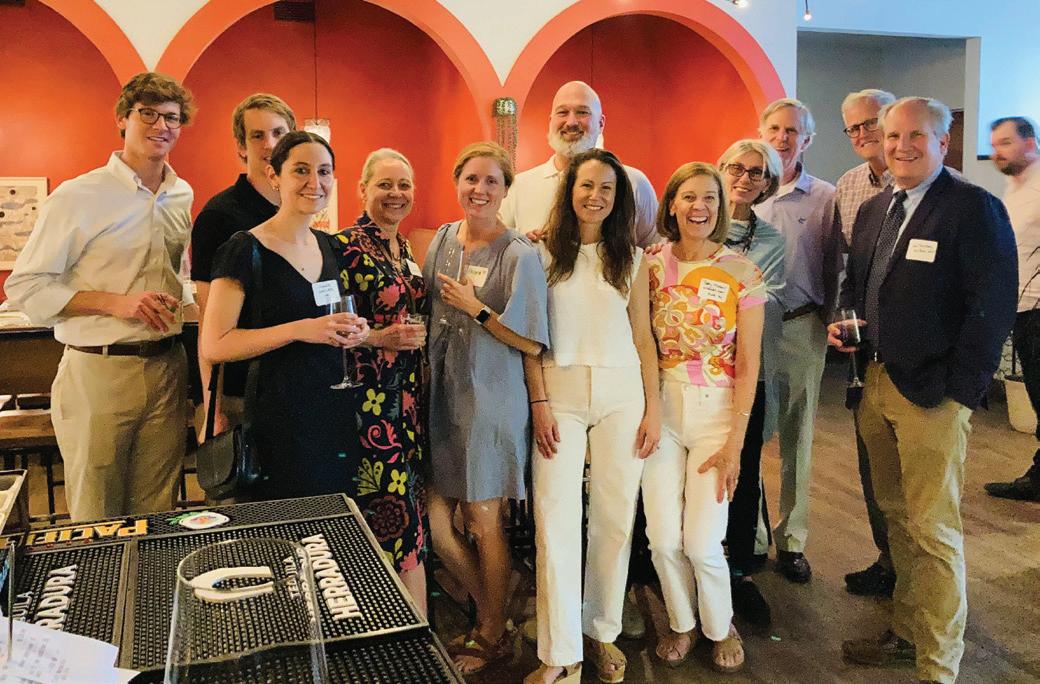
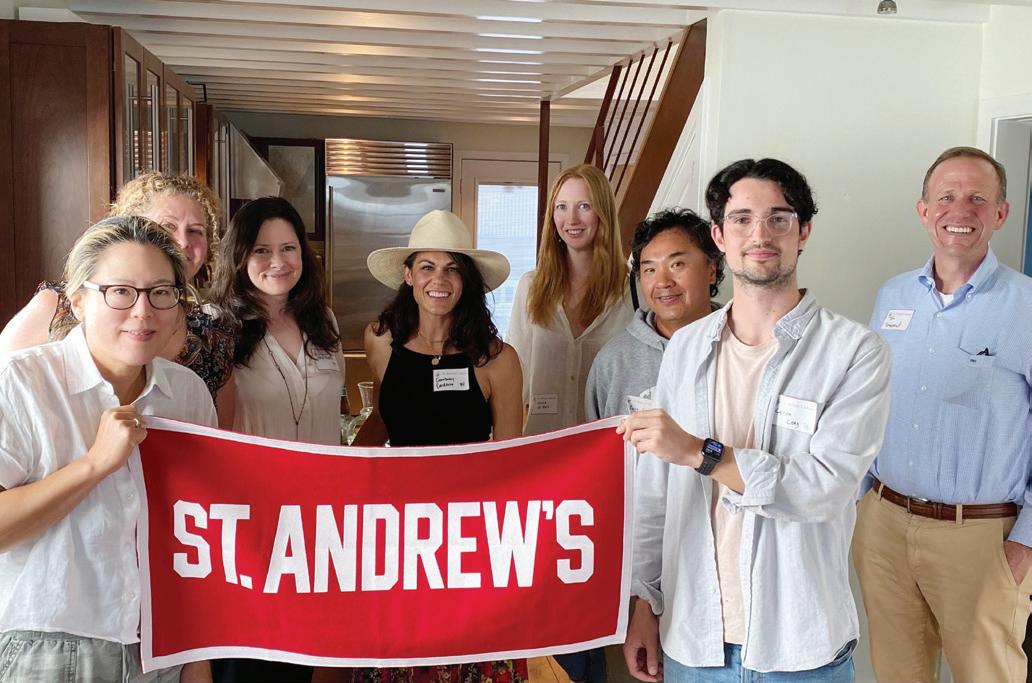
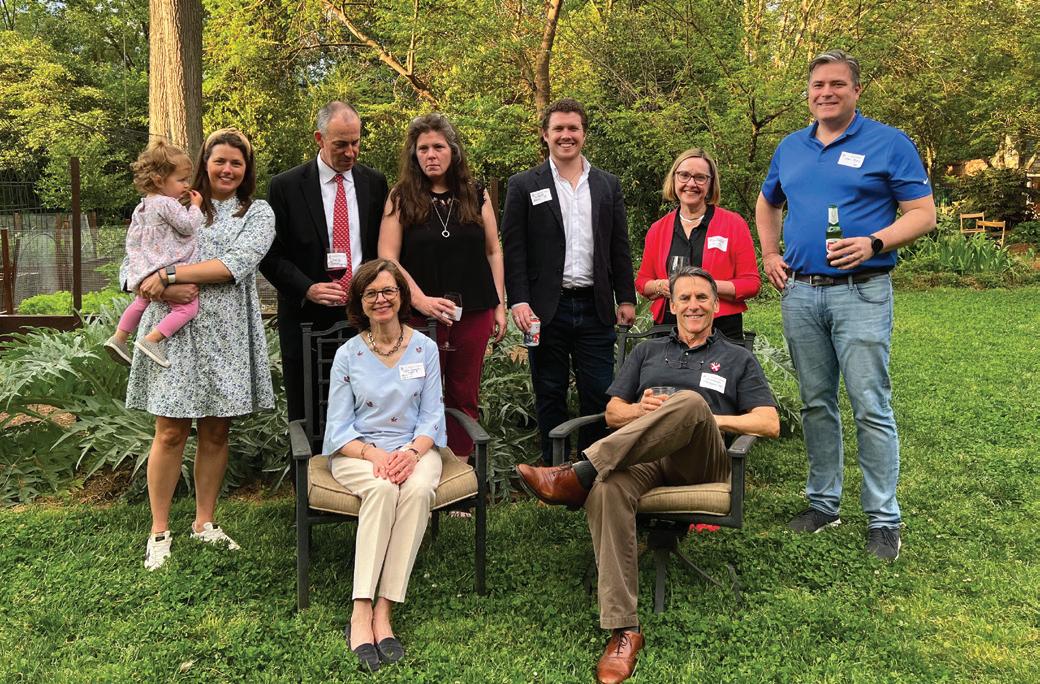

FALL 2022 71 COAST TO COAST TOAST 2022 /
HOUSTON, TX
LOS ANGELES, CA
LEWES, DE
RICHMOND, VA
SAN FRANCISCO, CA
VIENNA, VA
CHARLOTTE, NC
MIDDLETOWN, CT
Saints Create & Collaborate
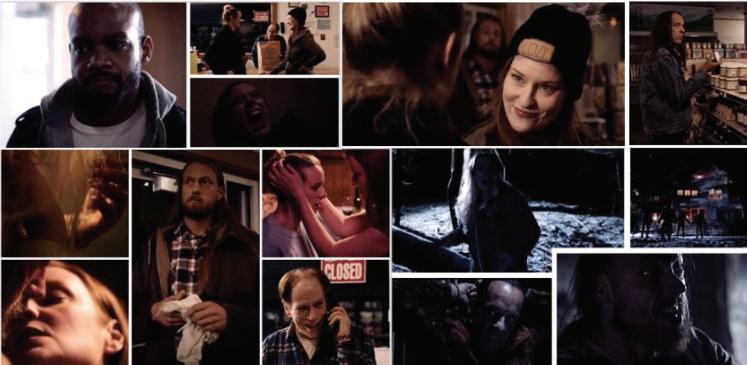
CLASS OF 1986 ALUMNI BAND TOGETHER California based singer-songwriter and producer Theo Hartman ’86’s new album “Made for This” involves musical and technical collaboration with his SAS classmates Charlie Crystle on guitar and Dave Wike on drums (plus Dave’s brother Mark), as well as a deep SAS backstory.



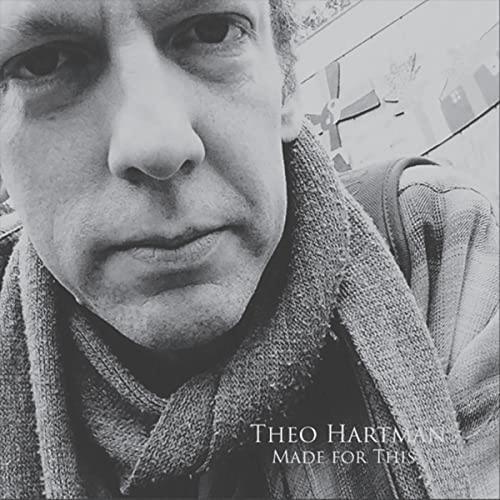
As Theo tells it: “Dave and Charlie and I started playing together as a band on campus—at the Student Center, dances, the Everett Theatre in town—around the same time we were the rhythm section in Larry Walker’s stage band, circa 1984-86. We continued together after graduation as ‘Parrish Blue’ for a minute in 1987.
“In the summer or fall of 1994, I wrote the songs for this album, assembling demos on a drum machine and 4-track at Charlie’s place in Lancaster, Pennsylvania. The following spring of 1995, I sent off cassettes of the demos to the Wike brothers in hopes of convening to record them.
“That summer, Dave, Mark, Charlie, and I met at Toad Hall, the Wikes’ home in Berwyn, Pennsylvania, to sift through the material and work up versions to record. The following day we tracked five songs. That fall, Charlie and I did some overdubs and lay-back mixes on the ADATs (Alesis Digital Audio Tapes). Then I moved to California, after which time the work sat unreleased.
“Fast forward to 2022: some additional tracking and pulling the tunes together for this album, and ‘Made for This’ is released.”
The album includes this note from Theo: “I have fond memories of these sessions and enormous gratitude for the musicians who helped shape these songs, taking them places I could not have envisioned. You are like brothers to me. It took long enough, but I hope in their final form these tracks do you proud.” •
SAS / ST. ANDREW’S MAGAZINE 72 / CAN'T HELP BUT CONNECT
WATCH THIS READ THIS
LISTEN TO THIS
HAPPY TRAILS
Skip Middleton ’83 lives in Asheville, North Carolina, eight miles as the crow flies from the Appalachian Trail. This spring he hosted a couple of Appalachian Trail throughwalkers for a hot shower, a few good meals, and a warm bed. One walker was Eli Abbott, the 18-year-old son of Tim Abbott ’86, who was on mile 260, or roughly 10%, of his 2200mile trail journey. Eli “paid” for his stay with a song he played on the ukulele that he carried with him on the trail. •
BUILDING GREEN
Brian Court ’92 was featured in the William and Mary Magazine for his perspective on sustainable design. An excerpt:
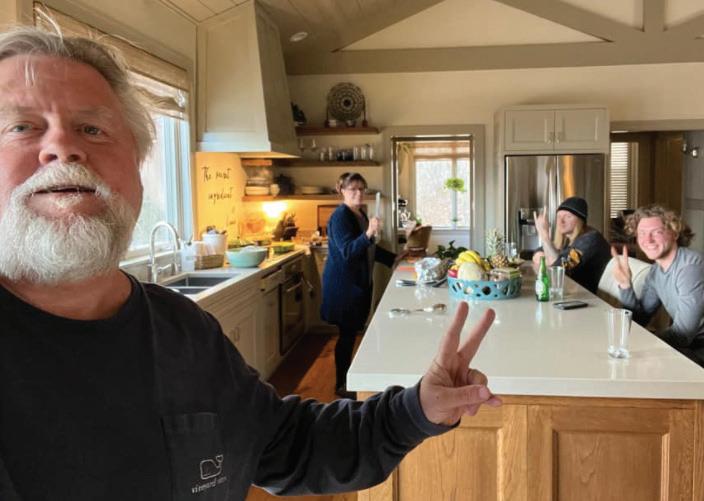
“What do the historic buildings in Colonial Williamsburg and some of the most technologically advanced buildings of today have in common? They’re both exceptionally environmentally friendly. That was one important lesson for Brian Court ’96, who built on his education at William & Mary to become one of the leading architects in sustainable design.” •
MAKE A FILM, MAKE A MARK
LeMar McLean ’00 has exciting news! He writes, “I wrote and directed Who’s Afraid, a cautionary horror tale about white supremacy. My partner Siobhán Lee and I bet BIG on ourselves with this project, self-financing principal photography and crowdfunding for post-production. We create to inspire anyone who’s ever daydreamed about following a passion but chose a more practical path instead. We create because it feeds our souls in ways that no other pursuit can. We create to plant guideposts for a better world than the one we’ll leave behind. I’m hoping people will see that we’re serious about making a mark, an imperative I’ve taken to heart since Will Speers talked about it in chapel. You can stay updated on the film by following @WhosAfraidMovie on Facebook, Twitter, and Instagram.” •
FALL 2022 CAN’T HELP BUT CONNECT / 73
We create to inspire anyone who’s ever daydreamed about following a passion but chose a more practical path instead. We create because it feeds our souls in ways that no other pursuit can. We create to plant guideposts for a better world than the one we’ll leave behind.
—LEMAR MCLEAN ’00
Can’t Help But Connect

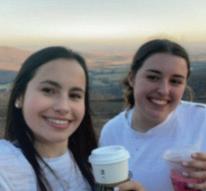
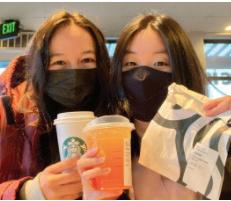
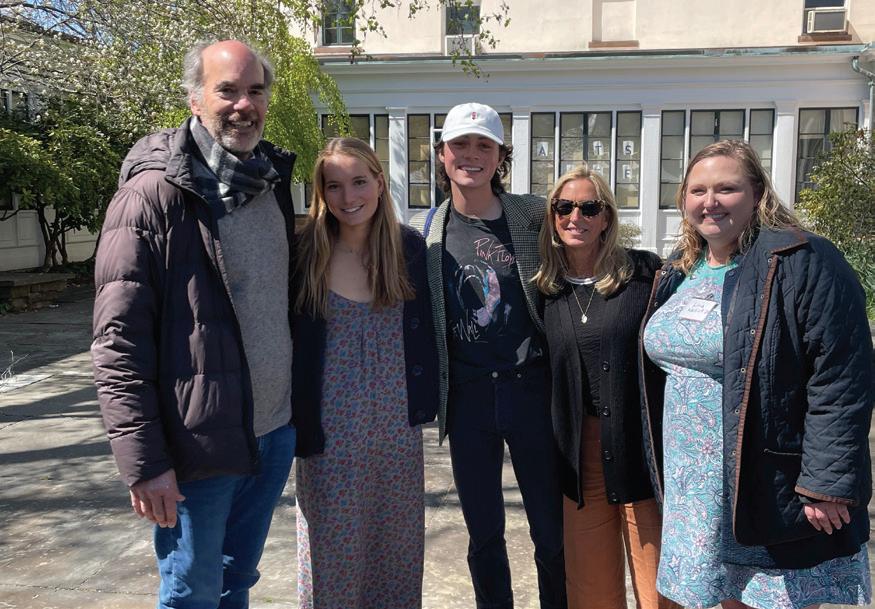

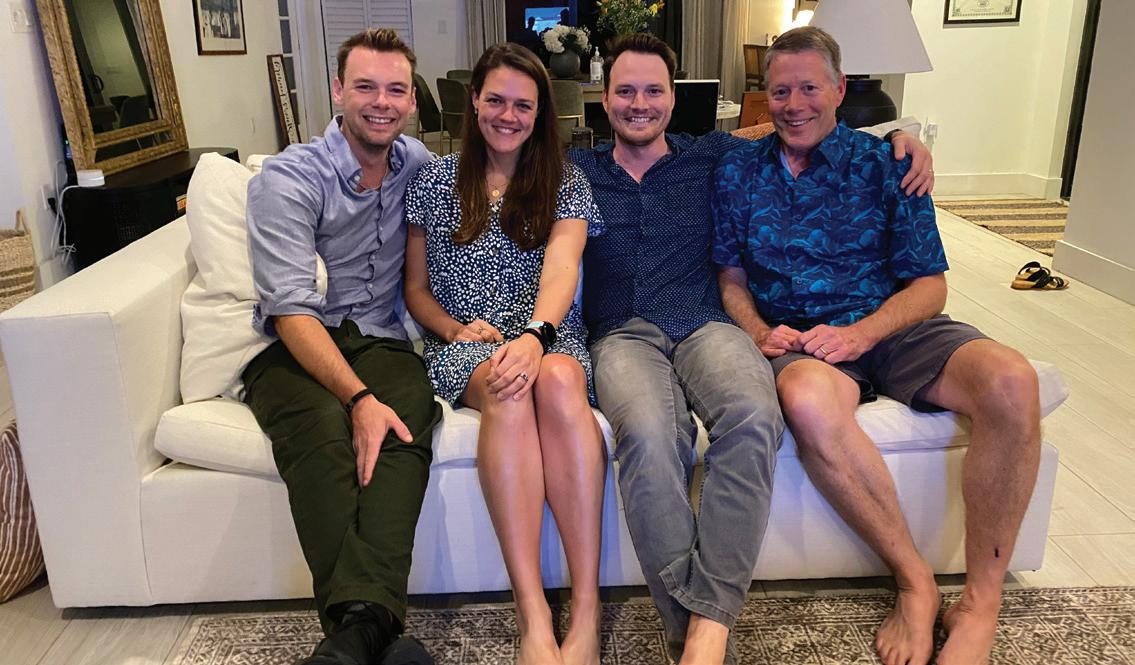
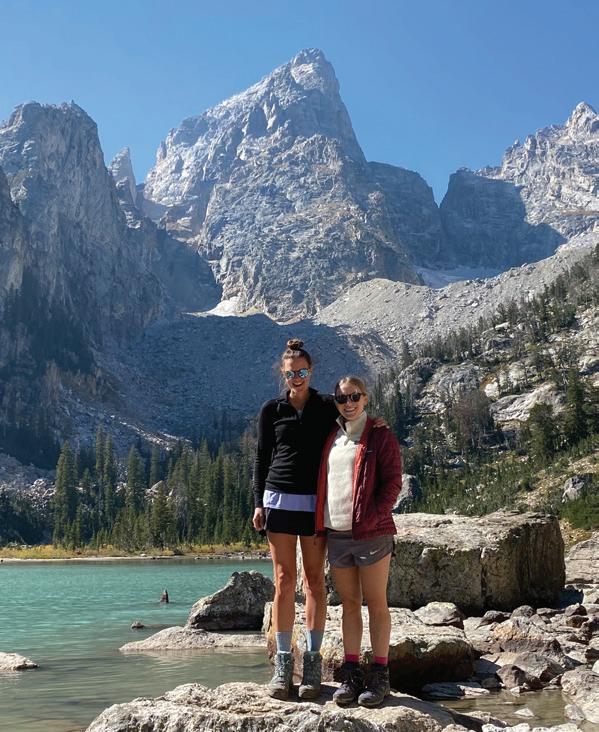

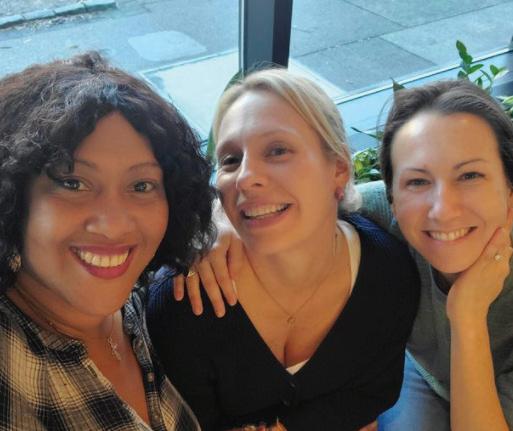

SAS / ST. ANDREW’S MAGAZINE 74 / CAN'T HELP BUT CONNECT
1 4 5 6 8 9 11 12 2
1 While traveling in Chile, Lisa Velasco ’82 and her husband made a stop in Pucon at the andBeyond Vira Vira Lodge. “Who did I meet but fellow alum Maddie Izard ’13!” she wrote. “Maddie and her mom were having lunch when we arrived. We sat at a table nearby and introduced ourselves. When we said we were from Delaware, Maddie said, ‘I went to boarding school there.’ Hence the connection immediately.” 2 On Zoom this spring, the Class of 1982 prepared to rally for their 40th Reunion in June. (top) Eric Olson, Andrew Seymour, and Jennifer Neal, Becca Wright; (middle) Van Smith, JW Clements, Kevin Grandfield, and Chris Profaci; (bottom) Mark Dimmick and John Buda. Not pictured but on the Zoom: Gretchen Rada Willingham, Jay Smith, John Schwab, and Paul Eichler. 3 Members of the Class of 1990 caught up at First State Brewing right here in Middletown. “35 years and counting!” said Taylor Cameron, pictured with Mark Cheng, Earl Walker, and Tim Fallaw. 4 Class of 1995 meet-up in Richmond: Noelle Frieson, Liz van Sickle, and Shelley Huntington 5 Richard Hutton ’01 and Clementine James ’01 met up in London last fall. Rich continues to serve in the US Army and is currently assigned to the UK and living in London with his family. Clementine was traveling through London for work on her way back to South Africa. 6 Eloise Repeczky ’07 quit her job and traveled across the United States for three-plus months, visiting 16 states and hiking over 700 miles. Classmate Stephanie Chubb ’07 joined for ten days to explore Jackson, Wyoming, Teton National Park, Yellowstone National Park, Missoula, Montana and Glacier National Park. 7 Morgan Scoville ’00, Luke Baer ’98, and Alex Baer ’00 caught up in the Outer Banks. 8 Ian James ’07, Eloise Repeczky ’07, Chris ’07 and Will Speers P’07,’09,’13 gathered at Chris’ home in Miami, Florida. 9 Saints gathered for a house party at the home of Peter Brownlee ’08 in Burbank, California. (front, l. to r.) Grace Seekins ’12, Annie Pohl ’13, Pam Brownlee P’05,09,’14, MacKenzie Lilly ’09, Sarah Khan ’09, and Grace Saliba ’12. (back) Andrew Jarowenko ’12, Molly Gillespie ’14, Colin Brownlee ’09, Gordon Brownlee ’75 P’05,’09,’14, and Lindsay Brownlee ’05. Peter and Josh Speers ’09 were in attendance but not pictured! 10 Theodora Simons ’17, Macklin Fishman ’19, and Millie Spencer ’16 all met up in Oxford, England recently. “Millie and I are doing our master’s degrees and Macklin was studying abroad for the term,” Theodora says. 11 Annie Roach ’18 read from her high honors thesis—a novella titled “Cadaver”—at Wesleyan in late April; in attendance were Tad & Elizabeth Roach P’04,’07,’13,’18, Carson McCoy ’19, and Livia Wallick ’16 12 Saints love Starbucks: Lian Bourret ’18 and Noelle Yoo ’18 met up for an afternoon snack at Wellesley, and Rhett Edens ’21 and Emmaline Rickert ’21 had their Starbucks with a view at Sewanee. 13 Matthew Mitchell ’21 and Felix Hernandez ’21 rowed against each other as members of the 1V boats at Trinity and the US Coast Guard Academy, respectively. They were racing in early April on Mystic River in Medford, Massachusetts, in competition for the Fred Emerson Cup, established in 1968. Trinity prevailed this time! •

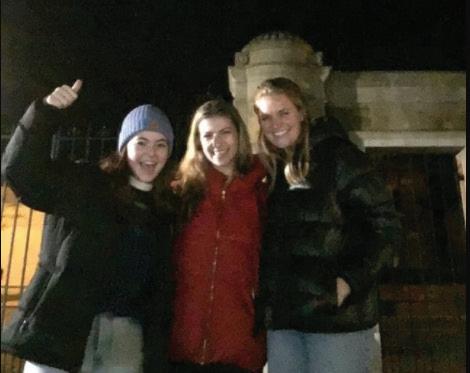
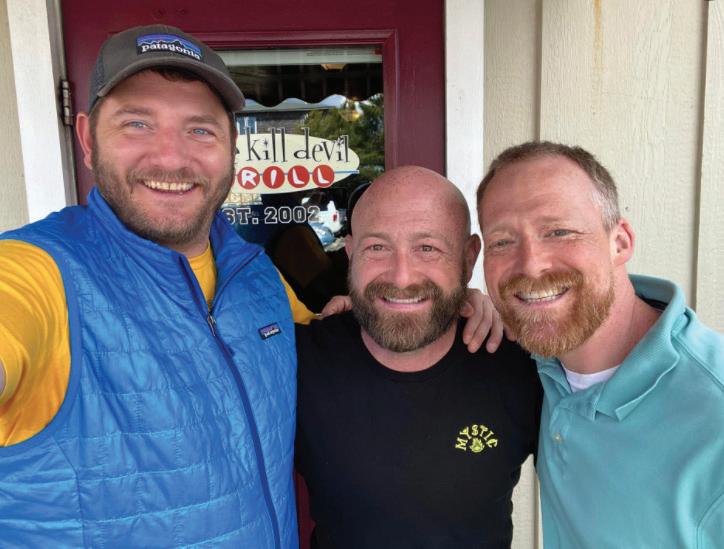

FALL 2022 CAN’T HELP BUT CONNECT / 75
3 7 10 13
Class Notes
1953
From Class Agent—or “Class Scribe,” as he calls himself—Tom Quirk:
“Art Wright reports he is dabbling as a marine geophysicist in Seattle and still chasing the perfect rowing stroke. Your Humble Scribe notes his bones are creaking more but otherwise things are pretty good.”
1957
Long-serving Class Agent George Brakeley reports, “During one of our recent Zoom calls, Mike Bateman revealed that he has been diagnosed with late stage 3 pancreatic cancer. With his usual aplomb and positive attitude, Mike is embarking on a regimen of chemo treatments at Rose Cancer Center at Beaumont Health System in Royal Oak, Michigan. We send him our best wishes and will cheer him on as the situation develops.
“Other than that sad news, we seem still to be experiencing the pandemic blues. Mike Quillin reports, ‘Unfortunately things are pretty boring around the Quillin household. Just waiting for warmer weather and the end of COVID. I am very lucky to have all of my kids and grandkids live within 12 miles of me and everyone is doing well.’
“‘No news worth reporting,’ says Jack Kramer. ‘At our period in life, I think that is great. Bev and I hope to make the Reunion in June.’
“Bill Nuckols and Tuula have been at their DelRay beach home since January but will have returned to Finland by the time of our 65th Reunion in June.

“Tom Rightmyer is up to his usual volunteer activities: ‘I continue to work as an election judge, helping people vote from nursing homes in early voting and on election days. My desire to serve the community was strongly influenced by St. Andrew’s and especially the example of Dr. Pell.’
“Les Fairfield writes that he and Lynnie are well, each twice vaxxed and once boosted, and no signs of COVID. They lead a very quiet life as ‘hearingimpaired geezers,’ reading books, taking walks, drinking cups of tea. ‘Horizons do contract as one ages!’ Les is teaching two or three online courses a year for Trinity School for Ministry, where he taught ‘live’ for 30 years. Lynnie exercises a lot to maintain her healing from the stroke ten years ago.
“Tom Rightmyer notes that: ‘Les Fairfield wrote his Ph.D. dissertation on John Bale, a Reformation-era Church of England clergyman. His work is referenced in the article on Bale in the current issue of Anglican
and Episcopal History, a journal published by the Historical Society of the Episcopal Church.’
“Tim Bloomfield reports with no small pride that daughter Maia, an assistant professor of urban studies in the College of Education at Temple, had an essay on the pandemic’s effects on education, titled We Failed to Put Schools First, published in the Opinion section of the March 10 edition of The New York Times
“And, blessed with good health and reasonable fitness, Tamara and George Brakeley ski, golf and play tennis and platform tennis regularly in Vermont.”
1958
Flora Wigglesworth D’58—an 11year-old Great Pyrenees—finds 5ºF too strenuous and clearly is not satisfied with any old sweater, writes her companion Jerry Wigglesworth. Go Saints! Woof.
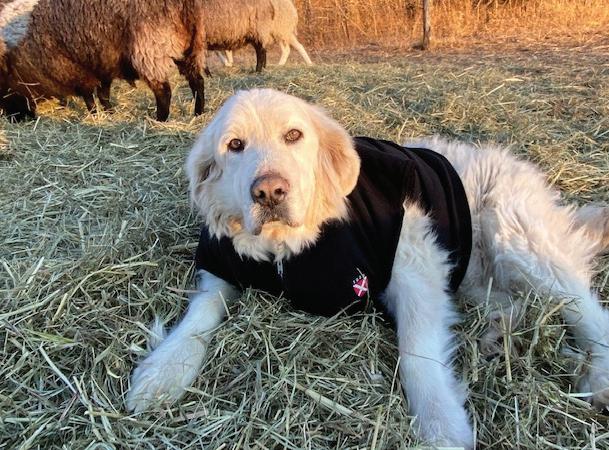
1966
Charly Gates got his classmates talking with this check-in note, “I came across this long email thread from some time ago, and it has prompted me to reach out and wish everyone best wishes for the ‘post-COVID’ (I hope) era. I am now beginning to resurface after the long hibernation and look forward to whenever our next get together will occur…”
Ted Thornton responded, “Patter and I are very well—and have evaded COVID so far. We’re both on the board of the Amherst-based Da
SAS / ST. ANDREW’S MAGAZINE 76 / CAN'T HELP BUT CONNECT
’58
’89
p Flora, pup of Jerry Wigglesworth ’58
p John Little ’89 with his family (l. to r.) children Kate and Scott and wife Nancy.
Camera Singers. There was no singing at all during the first year of COVID. This year we’ve put together a season overruled by caution: we rehearse and sing fully masked with N95s. All singers are required to be fully vaccinated and boosted. We interrupt our rehearsals with room ventilation breaks. Concerts are open only to fully vaccinated patrons. So far, no one in the group or attending our concerts has fallen ill.
“In the same vein, the church I belong to and occasionally officiate in—the Episcopal Church of Saints James and Andrew—has remained healthy by requiring masks, keeping doors and windows open, and serving bread only for the Eucharist.
“I’m busy maintaining three websites for nonprofits and was a charter member of Northfield’s iteration of the national Village-toVillage movement, which is an effort to help seniors remain in their homes as long as possible. I play and sing folk songs on my Martin acoustic at the local farmers market with Patter, and play rock oldies with other veterans of 1960s rock bands with my Fender bass and Telecaster (I think the spirit of Mark Dryden has possessed me—I can’t stop acquiring guitars and related equipment!) Finally, our two grandsons (ages 8 and 2) are thriving and we enjoy keeping up with them. Patter and I will celebrate our common birthday (Ides of March) with them down in Seymour, CT. Patter is exactly two years younger than I and never tires of reminding me just how much younger she is than I. My response always is, ‘Yes, but you’re catching up with me fast, Dear.’”
1967
Gil Hicks sent this update, “Sad to report that Donna, my wife of 44 years, died of lung cancer in September 2021. My son and daughter-in-law moved from Long Beach, California, to Tennessee in December and I have moved there to be closer to them. It’s important for me to be near family.
I sold my house in Pacific Palisades, California.”
Franklin Smith writes, “Spring is unfolding in Summerville, South Carolina, with only one more night of threatening frost. Having been married now for 42 years, Linda and I have four grown and married children all living in South Carolina along with the 13 grandchildren that they have. Having retired from the Dorchester County Sheriff’s Office, I now spend my time assisting various children with God knows what as the need arises. In late February of this year we planted 30 fruit trees on our farm. Ten peach trees, ten pear trees, six plum trees, two apricot trees and two cherry trees (yes, I know that cherry does not grow in our climate). Maybe these will make it. This spring, Linda and I are planning to visit her oldest brother for his 80th birthday on March 24. Bill is one of their family’s nine brothers, and Linda also has four sisters. If you can add, that makes a total of 14 with one set of parents. Linda is number seven.”
1989
Class Agent Allison Hamilton-Rohe reports, “Despite Omicron, the Class of 1989 has been keeping up with regular Zooms and a WhatsApp group, which we started to share intel about Rick [Hall] after his tragic death last year, and which has evolved into a hilarious group chat. We know Rick would love that!”
Great news from John Little: “Life is good for my wife Nancy and me and our kids, Kate and Scott. Nancy just passed her 20 year anniversary with The Home Depot; currently she manages their huge capital budget. For five years I’ve been with CoStar Group [founded by SAS alumnus Andrew Florance ’82], the world’s largest provider of commercial real estate data, analysis, and marketing. Specifically I train and coach our 400-person sales force. Kate is 13 and headed to Marist School in Atlanta this fall. Scott is 11 and a fifth grader at Kittredge Magnet School. The kids are excited for summer camps in Tennessee and
North Carolina and we’ll continue to travel as the pandemic recedes, having visited Chicago, the Grand Canyon, and Universal Studios Orlando in the past year.”
1996
Emily Rausch writes, “In 2018, I left the corporate world and began a career in fundraising in suburban Philadelphia. I currently work as the director of annual giving for the Agnes Irwin School, which I absolutely love. My son, Connor, is in seventh grade at the Shipley School and my daughter, Claire, is enjoying St. Andrew’s as part of the Class of 2025! She is so happy and is challenged every day. I am looking forward to Reunion and hope to see many of my fellow SAS alumni.”
2007
Lots of news from 2007 Class Agent Eloise Repeczky:
AJ Huenke has accepted a new position as a police officer in Delaware and began his journey in March.
Nicola Fleischer co-founded The Educator Wellness Project, a nonprofit organization that works to support the wellbeing and retention of educators. The organization partners with schools to provide wellness coaching and support for faculty and staff. The organization is currently establishing partnerships for the coming school year—visit edwell.org to learn more.
Congratulations to Shabazz Stuart and his mobility company Oonee for being one of the first Black-owned business to surpass a million dollars in equity crowdfunding! See page 21 of the 2020 Fall Review for more on Shabazz and Oonee.
Jessica du Pont recently joined Sotheby’s International Realty Brokerage and looks forward to connecting with the St. Andrew’s community in California. She is also involved with home renovation and residential development if anyone is looking to begin a home design or construction project. •
FALL 2022 CAN’T HELP BUT CONNECT / 77
Saints Babies
1 Andrew Mahlstedt ’94 shares: “On April 25, at 11:39 p.m., Gaia Aspen Patterson Mahlstedt joined us on earth. Four names? Sure... lots of cultures do it!” Gaia joins her big brother Aiden, who is almost 2 ½.
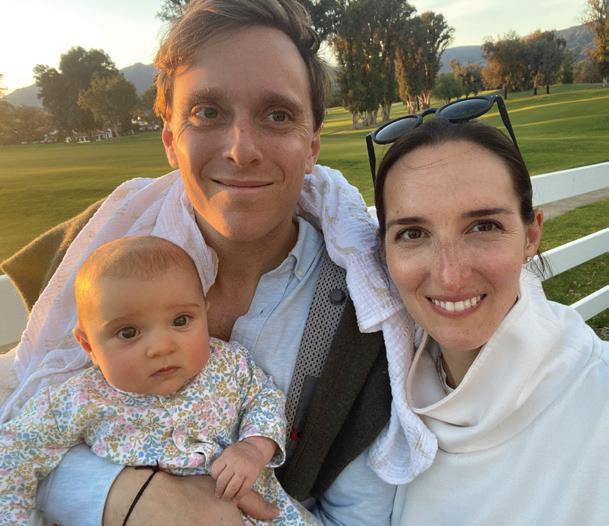
2 Patrick Hazelton ’98 and his husband Quang Dang welcomed Theodore “Thor” Liêm HazeltonDang to the world on December 13, 2021. Thor is adapting well to his new life with papas and friends in Portland, Oregon, and looks forward to meeting his far-flung St. Andrew’s family in the years to come. 3 Ashley (Gosnell) Mody ’02 is excited to share that her daughter, Keya, was born on February 9, 2022. “Darshan and I are settling into our new routine as a family of three, and we're hoping Keya will have a chance to meet some members of the Class of 2002 at the June reunion!” Keya also met Head of School Joy McGrath ’92 in mid-May; “Ashley was my advisee,” Joy notes, “making Keya my grand-advisee.”

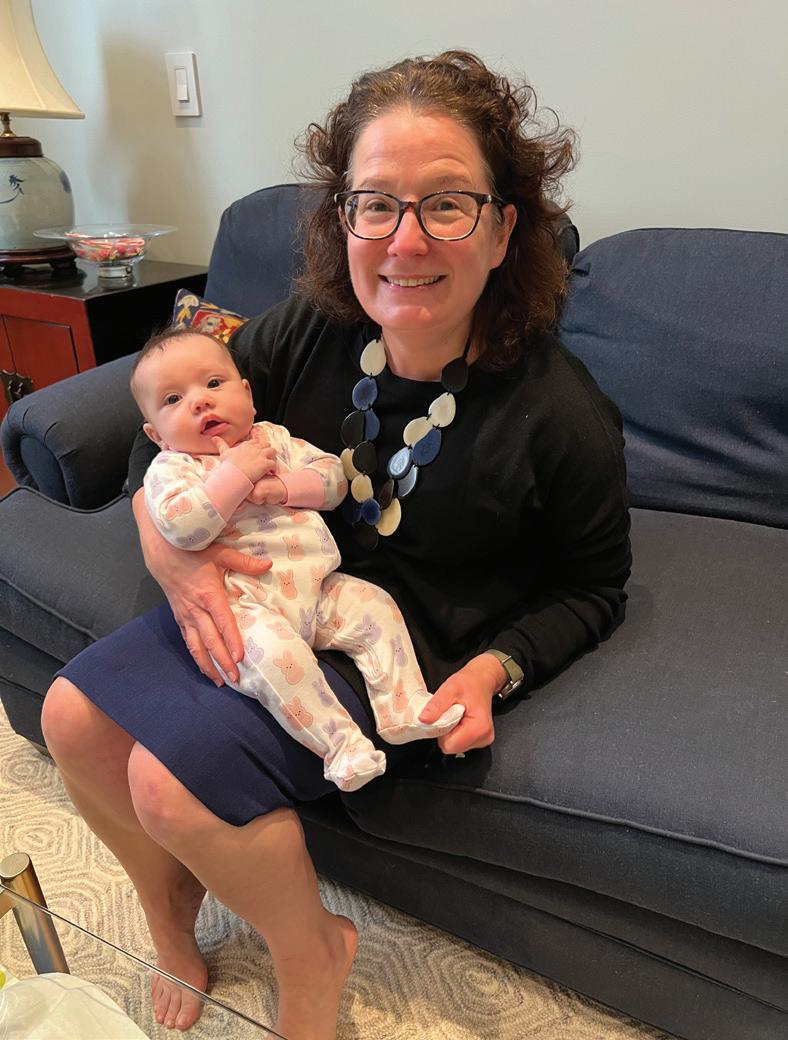
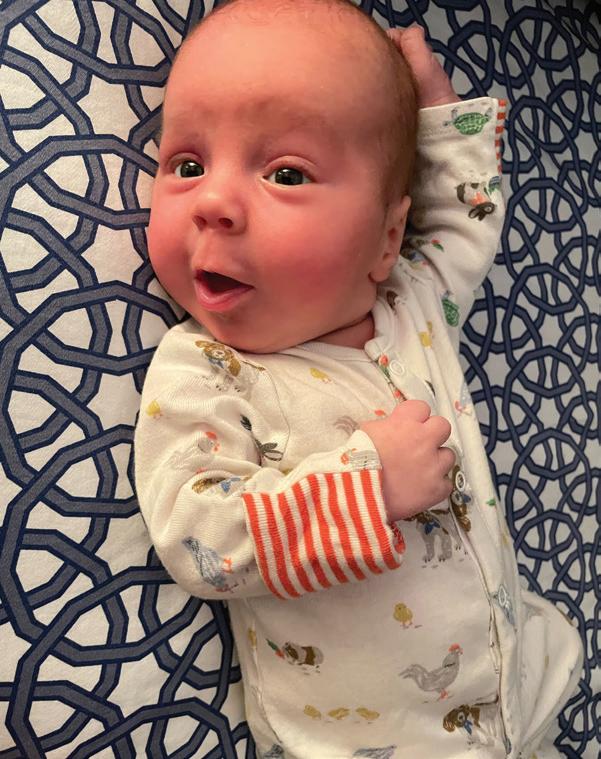

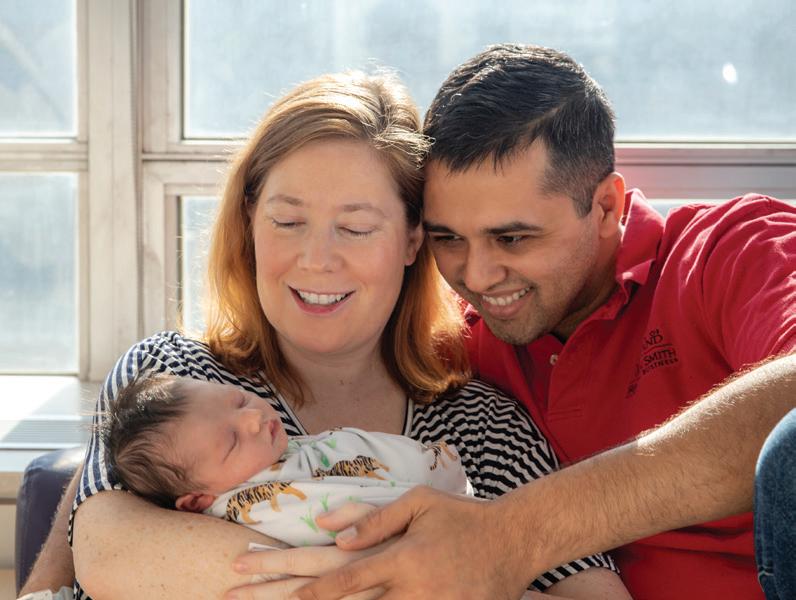

4 Charlotte Rajasingh ’07 and James Bryant welcomed their son Alexander James Rajasingh Bryant on February 2, 2021, and shared this photo from his first birthday. 5 Kathryn (Orfuss) ’07 and Ike Perkins welcomed their daughter Kathryn Carter Perkins on November 7, 2021. 6 Coincidentally, classmate Jim McNinch ’07 and his wife Danielle also welcomed their son J. Robinson McNinch V (going by his middle name, Robinson) on November 7, 2021. Robinson arrived six weeks early in November, but came home from the NICU just in time for Christmas. In June, he’ll be moving with his parents to Hershey, Pennsylvania, where Jim will be starting a fellowship in pulmonary & critical care medicine at Penn State. 7 Rosy and Chris Speers ’07 welcomed their son Mateo Savage Speers on April 23, 2021 and recently moved to Miami, Florida. •

SAS / ST. ANDREW’S MAGAZINE 78 / CAN'T HELP BUT CONNECT
1 2 3 5 4 6 7
Saints Get Married

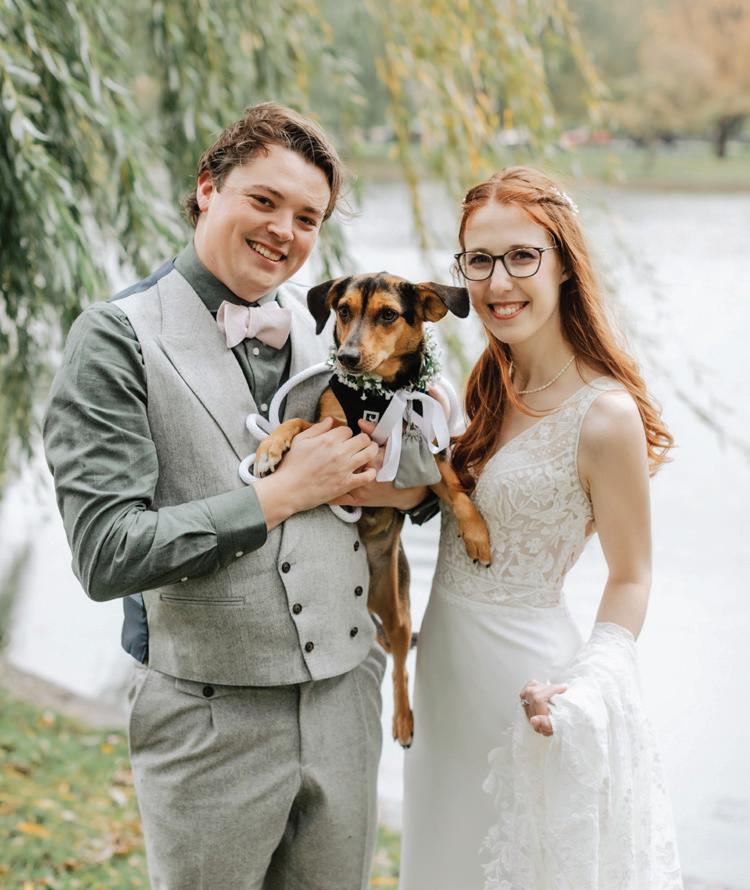
1 Hayley Swan ’09 married Adam McInturff on October 9, 2021 in Alexandria, Virginia. Members of the Class of 2009 were in attendance and managed to leave the dance floor long enough for a photo (l. to r.): Eliza Hamilton, Beth Martin Lane, Margot Mellon, Louise Dufresne Serio, Sarah Haroldson, Susie Gurzenda, and Sara Khan. 2 Zach Brak ’10 and Ally Graham were married on October 27, 2021 in Boston Public Gardens. They met while attending the Isenberg School of Business at UMass Amherst. The couple resides in North Attleboro, Mass. 3 Grace Benjamin ’12 married Charlie Walters in October. Saints joining the celebration (all Class of 2012 unless noted) (l. to r.): Dayton Geddes-Key, Molly Belk, Kara McDonough, Cesca Fleischer, Graham Dworkin, Maggie Rogers, Katie Toothman, Grace Walters, Annabel Wilmerding, Riley McDonough ’13, Faye Benjamin ’21, Grace Saliba. Not pictured: Thatcher Barton ’08. •
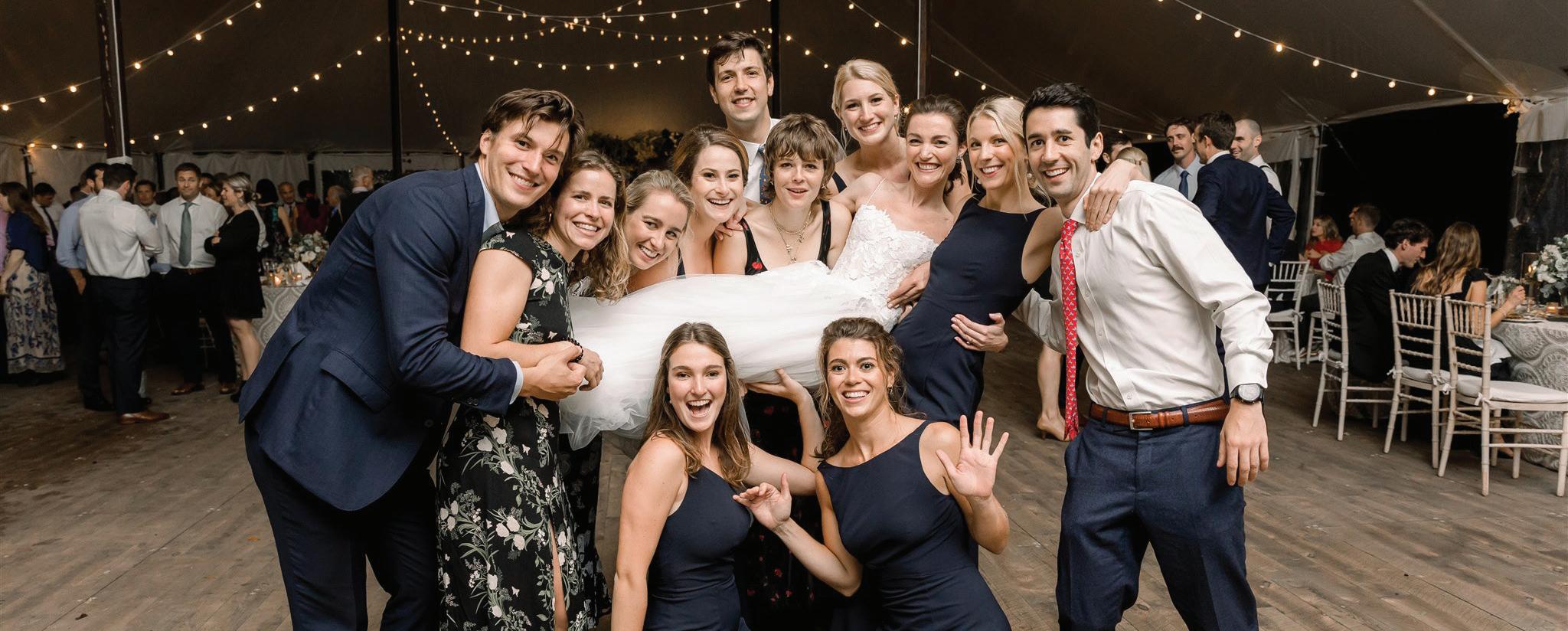
FALL 2022 CAN’T HELP BUT CONNECT / 79
3 2 1
In Memory
You may have noticed we’ve been experimenting with our In Memory section in recent issues. We’ve stopped printing full obituaries for deceased alumni in the magazine, but you can still read these obituaries, and leave a comment or reminiscence, on the St. Andrew’s website at standrews-de. org/inmemory. Our hope is that in these pages, the In Memory section can instead become a space where the school and its alumni can honor and share their own remembrances of departed St. Andreans. If you would like to submit a remembrance of a deceased alumnus or former faculty member, you can do so via email to Chesa Profaci (cprofaci@standrews-de.org).
ALUMNI REMEMBRANCES
1947
EDGAR R. “TYKE” MILLER, JR.
Kennett Square, PA
February 18, 2022
“Tyke Miller was the oldest living person associated with the founding of St. Andrew’s—and rightfully proud of the fact.
“As a young boy, he spent summers on the southeast corner of Silver Lake in the cottage that his parents bought in 1937 as a summer home. Every day, Tyke would go up the hill and across the road to the school farm where he learned to drive a pickup truck and tractor; to milk cows, and deliver milk to the back porches of the SAS faculty homes; and worked in the hay fields alongside Walden Pell, who often drove the thresher.
“Tyke was admitted to St. Andrew’s as a IV Former in 1946 when school was already in session. He took no admission tests. Tyke was popular with both students and faculty and became Senior Praefect. He won the Henry Prize for athletics (which he still had in his library in 2019). Though he said he wasn’t a student, he graduated from Dartmouth and then Harvard Medical School.
“Tyke remained in touch with Dr. Pell, and when Waldy had cancer, he consulted Tyke about what to do. Tyke operated on Dr. Pell, and then advised him against chemo as the cancer was too pervasive. Tyke was
at Waldy’s death bed, along with the Pell children: Stuyve, Missy, Lili, and of course, Mrs. Pell.
“Tyke refused to take payment for operating on Dr. Pell—$600 of insurance money—and gave it to the school to start the Pell Fund. He continued to support the Pell Fund throughout his lifetime, both as a tribute to Walden Pell, and also in support of what made St. Andrew’s important for him, and for so many others, the faculty. Last year, the Pell Fund provided over $30,000 for summer study of faculty working toward their M.A. or Ph.D.
“Tyke was a loyal alumnus as well as a wise man, and served on the Board of Trustees from 1980-1993. He had a profound and important impact on a number of decisions the board made regarding crucial and sometimes sensitive issues.
“Tyke was a modest man, but take time to read his obituary which celebrates a true St. Andrean.”— Chesa Profaci ’80, Director of Alumni Engagement
1952
HARRY B. CANNON
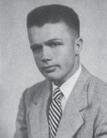
Hertford, NC
November 13, 2021
“I am sad to hear about Harry Cannon’s passing. I was always amazed how this handsome young man was also easily able to be a scholar and very easy to talk to and laugh with at the same time. I really admired him and send
my prayers for him and his family.” — Charlie Bill Kenney ’52
“I last spoke to Harry in April. He was having a colonoscopy the next day and I guess wanted some distraction. We discussed health, his meal ministry and work with the homeless, and of course, his family. We talked about his St. Andrew’s memories: the Green Dragon, the jobs system and working in the kitchen, study hall, walking into Middletown for apple cider and donuts; living in the gym, the Rifle Range, the Alpine Club—and George falling off, and many of you by name. And also about being on dialysis for 9 hours a night, every night. Harry’s faith was huge, but his heart was bigger.”— Chesa
Profaci ’80
“It was intensively distressing to learn of Harry’s passing, recalling he was originally in the Class of ’51 and sometime during the school year he dropped out of school due to a kidney disorder. He was operated on and had a kidney transplant from his father and returned later to SAS and became a member of the Class of ’52. He and two of his grandsons put in a brief appearance for our 60th Class Reunion.” —Carter Werth ’52
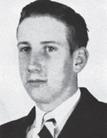
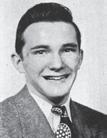
“Thanks for solving my history dilemma. As you might remember, I was one of about five to enter SAS in our junior year (V Form) and our dorm was the gym. I seem to remember Harry as being one year above me and he was also one of two of our hall monitors. So, all this time I’ve been wondering, ‘How did Harry Cannon get to be Class of ’52?’” —Robert Young
’52
1953
DANIEL L. ROUDEBUSH
Oakdale, CA
“Daniel Livingston Roudebush was born in San Pedro, California, in 1935, the son of Jack and Wilba (Billie) Roudebush. As his father was a Naval Academy graduate and a naval aviator, Dan grew up
SAS / ST. ANDREW’S MAGAZINE 80 / CAN'T HELP BUT CONNECT
accompanying his parents (and later, his younger brother Jay) on numerous duty assignments, including Colorado, Puerto Rico, and Lima, Peru. Dan graduated from St. Andrew’s and then the United States Naval Academy in 1957, and Naval postgraduate school in Monterey in 1961.
“Dan served in the US Navy from 1952, then in the reserves until 1977, attaining the rank of Commander in 1997. He met and married his beloved Ann Kendrick Martin (Rome, New York) while stationed in Long Beach in 1963 and they had two children, Laura (1963) and Jack (1966). Dan and his young family lived on a lagoon in Foster City, California, while his children were growing up, and enjoyed sailing, soccer, and rowing. Dan and Ann moved to Kailua-Kona on Hawaii’s Big Island in 1991, where they designed and built their dream home overlooking the ocean.
“Dan loved the water: he swam, snorkeled, paddled with a Kapuna (seniors) rowing team, built an outrigger canoe, outfitted a kayak for fishing and sailing, and regularly took out his fishing boat, the Honey Bunny, to catch ono, mahi mahi and on a lucky day, a marlin. Dan was a world soccer aficionado. He coached youth soccer and conducted coaching clinics for coaches and officials in Foster City and Hawaii.
“Dan and Ann enjoyed traveling in the US and worldwide. Memorable trips included Europe, Australia, French Polynesia, Africa, Peru, and Alaska. He is survived by Ann, brother Jay, his children Laura Levandowski and Jack Roudebush, and five grandchildren: Katelyn and Madison Roudebush, Nikolas and Meredith Levandowski, and Hudson Hoefling.”— Art Wright ’53
1960
STEPHEN C. “STEAMER” WALKE Montpeilier, VT March 23, 2022
“Steamer was one of our class leaders. Someone I respected and learned from. Immediately, I think of his contribution as the captain of the Varsity Crew, and
I can picture Steamer standing on the dock next to Dave Washburn after a practice. Steamer had a contagious smile and brought humor and a positive attitude into our lives. We shall miss him.” —Brian Fisher ’60
Lots of discussion about how he came to be “Steamer.”
“I think Ducky Washburn dubbed him Steamer at crew practice.”—John Hassan ’60
“At least when I showed up in the V Form year, the nickname ‘Baby Huey’ was also commonly applied for Steamer.”—Woody Woodruff ’60
“I asked him last month. He said his sister had trouble pronouncing his name. She called him Steamer. He told me he knew he was going to St. Andrew’s at a young age. Family connection. He said he loved St. Andrew’s. His father was born in Japan. His grandparents were missionaries. He was upbeat and positive. Remarkable person. God bless him and his family.” —Carl King ’60
“While Steamer was a classmate and I was friends with him then, Linda and I got to know and became good friends with Steamer and Judy at SAS reunions. They were one of three or four couples we would seek out and with whom we had a great time. As with all of us, we will miss him greatly. Our thoughts go out to Judy.” —Hank Pool ’60
“What a battle Steamer and Judy fought, and I love that they didn’t quit.They just left the field together, holding hands and loving each other and putting the other first in all they did. Other than on the soccer field, Steve and I were not especially close, and I have no particular anecdotes, but he was a wonderful classmate and friend. I have family in Vermont and thinking I had at least a month or so, planned to visit him before he died. On the other hand, having gone down that road with my dad, I’m glad for him that it was so quick, and am just awed by Judy’s gift to let him go. How wonderful that they and their children were all together when he died. There’s
nothing like it, on many different levels.” —Pieter Voorhees ’60
1968
JAMES FRANKLIN ROBINSON
July 29, 2021
“Jim arrived at St. Andrew’s from Madrid, Spain, in September of 1966, entering in V Form. He made an impression fairly quickly as the center forward on the Varsity Soccer team. He was the team’s high scorer, was voted the Most Valuable Player, and was selected for the second team of Delaware’s All-State Soccer Team.
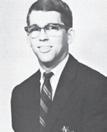
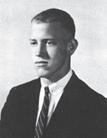
“Upon graduation from SAS, Jim entered the University of North Carolina at Chapel Hill. After one year, he transferred to Reed College in Portland, Oregon, graduating in 1973 with a major in International Studies. In 1974, Jim entered graduate school at McGill University in Montreal, Canada, majoring in Modern European Political and Intellectual History, culminating with a Ph.D. in 1983.
“In 1984, Jim entered the Johns Hopkins University School of Advanced International Studies (SAIS) majoring in International Relations, and completing a second Ph.D. in 1993. His dissertation was titled: “Reason of State: The Origins of NSC 68.” Jim was a professorial lecturer at SAIS for several years. Later in his career while on sabbatical leave, Jim was a visiting professor at the Watson Institute for International and Public Affairs at Brown University.
“In 1996, Jim joined the faculty of the Instituto Tecnologico Autonomo de Mexico (ITAM) in Mexico City, in the department of International Studies. He taught at ITAM until his retirement in 2020. While he was at ITAM, Jim used to return to his late mother’s house in Charlotte during the summers. About when he retired, COVID began to hit hard, and Jim chose to move to Charlotte in mid2020.
“In late July 2021, Jim died of either a stroke or a heart attack. No autopsy was done because of the large number of deaths then. He is survived by his
FALL 2022 CAN’T HELP BUT CONNECT / 81
older brother David in Oakland, CA, and an extensive network of friends, colleagues, and former students in Mexico City.”—Lory
Peck ’68
1998
DANIEL KANG
West Hollywood, CA
January 22, 2022
“My friend and former St. Andrew’s roommate, Daniel Kang, passed away this past January. He is survived by his parents and his extended family and a community of loving friends, including numerous St. Andreans. I could write about his many accomplishments in academia or his profession. While those aspects of Daniel are essential to him, a focus on just those parts of his life feel somewhat removed and antiseptic when compared to the vibrant, colorful, and wonderful life Daniel set out to live and did live passionately. A traditional remembrance that lists all of his résumé points misses the essence of Daniel. Life was not a progression of linear movements upward for him—it was a vast and eternal sea of possibilities and social discovery for him. Daniel and I shared a love of Star Trek and there is a principle in Star Trek—IDIC, meaning Infinite Diversity, Infinite Combinations. In many ways, he approached life with this as his ethos.
“The first time I met Daniel was on my first day at SAS. I arrived as a lost sophomore in August 1995. I wandered a little bit aimlessly to the Square Dance, and promptly situated myself at the edge of the action (trying not to be noticed). Daniel noticed me. He walked up to me, and introduced himself. He didn’t try to make me dance, because he intuitively understood that that wasn’t me. He proceeded to ask questions until we found common ground (Star Trek). It is so easy to dismiss first meetings as arbitrary, but Daniel pushing into my insulated world in that moment feels so fully representative. He always respected boundaries, but also knew when to push a friend. This played out so many times over the 25 years of our friendship. Daniel would always
want to learn about how I was doing, and quietly push me in just the right way—whether it was to a new type of cuisine or a new idea. We only lived in the same area for a year after we left St. Andrew’s, so we would always parachute into each other’s lives when we were distant—me driving to Hampshire College, New York, or Los Angeles to visit him. And he would find a way to visit me at Bard College,
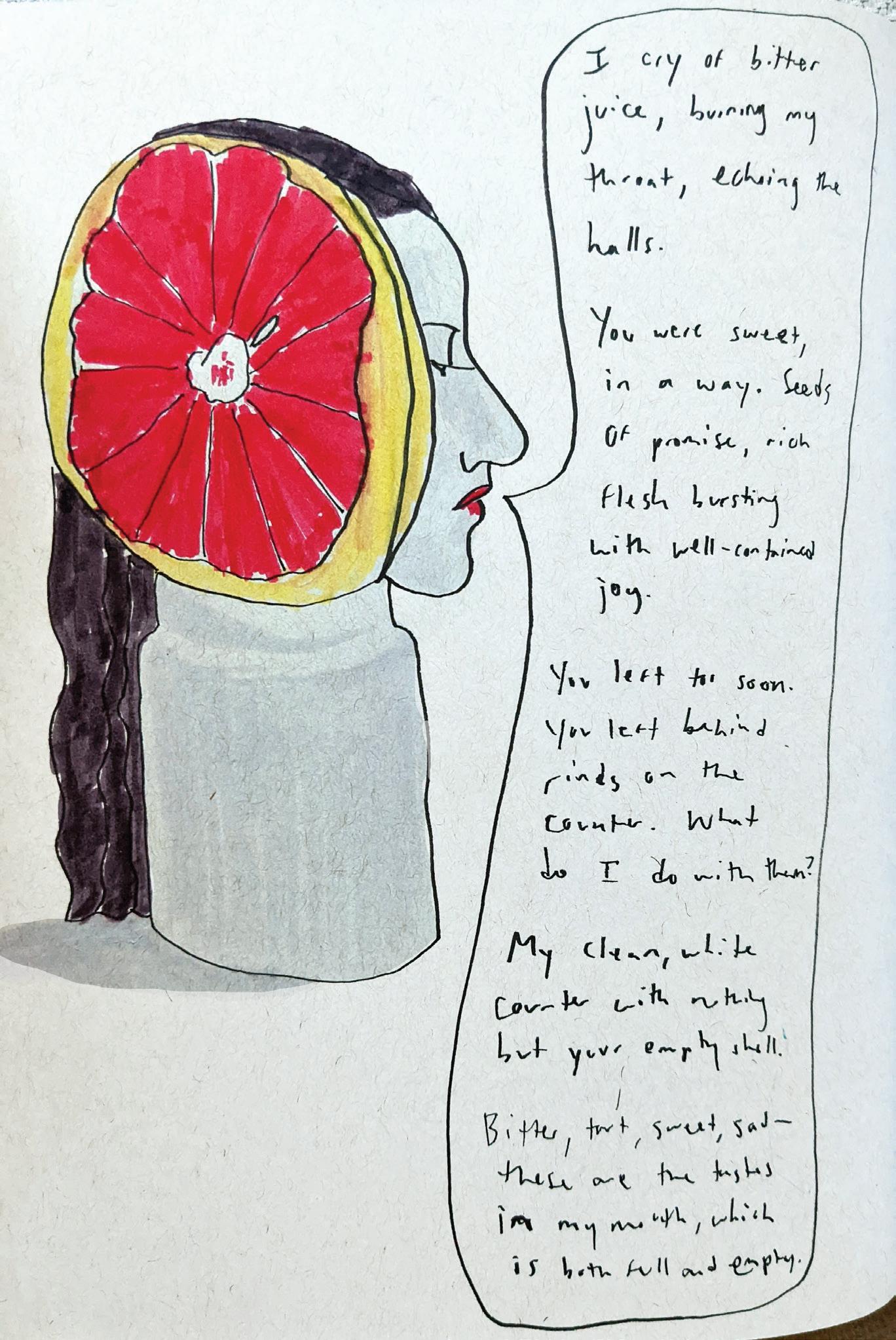
Reno, my hometown, or Allentown. No matter where we met, he always wanted to go do something new with me—ostensibly to learn about himself and his friend. We would sample new cuisine, new movies, new hangouts.
“As all long term friendships do, our friendship went through valleys and peaks. At times, we would be more distant because one of us got a little more busy, but then the other would
SAS / ST. ANDREW’S MAGAZINE 82 / CAN'T HELP BUT CONNECT
ARTWORK BY BETH BUDWIG ’98.
focus, regroup, and push to initiate a new series of interactions. I will be forever grateful that Daniel and I were in a ‘friendship peak’ when he passed away. We were separated by a continent and a pandemic and limited to phone calls towards the end of his life, but we still managed to connect with each other. And just as he did on a humid August day in the mid-90s, Daniel reached out, respected me, and pushed me. I will always be thankful for his vivacity, commitment, and friendship. I will always remember long walks around Noxontown Pond with him fondly. And I will always hold him in the light for the innate kindness he displayed in walking up to a scared new student on my first day at St. Andrew’s.”—Brad Hirsch ’98
“I reconnected with Daniel in 2008 in California. I have great memories going out with him in West Hollywood and the Castro, spending time at the beach, eating delicious food, and hanging out with classmates. In 2013, we organized a reunion of LGBTQI+ alumni and allies at St. Andrew’s, one happy effect being the many calls and visits I had with Daniel that year. I stayed with Daniel in LA shortly before the pandemic and I remember admiring the pictures he kept on his walls of happy times spent with his wide crew of friends and family. He was a kind and generous friend and I will miss him dearly.”—Patrick
Hazelton ’98
Former Staff
HAPPY VASQUEZ
Middletown, DE
April 9, 2022
Happy Vasquez died on Saturday, April 9, after a battle with cancer. Happy was an incredibly dedicated member of the St. Andrew’s community. His career spanned more than six decades, and he served under the leadership of three of our five Heads of School until his retirement in 2019. As one alumnus wrote at the time of his retirement:
“When I think of Happy, I think not only of his work ethic, consistency, and dedication. I focus my memories on his very kind eyes and that remarkable
expression on his face—a look that somehow welcomed generations of students, faculty, and staff to the school, to the mail van and a stop at George’s for a cheesesteak, to the dorm, to the Dining Hall, to the kitchen, to the very heart of the school.”
When we shared this news on SAS social media, remembrances of Happy poured in:
“Gosh, I remember him so well from my time there 25 years ago… he was such a nice guy and the kind eyes comment is so true; sad to hear of his passing.”—James Maxfield ’98
“Oh what a wonderful person he was!”—Bill Cashion (former staff)
“He was another member of my SAS family.”—Emily Rauch ’96 P’25
“Always a kind word of greeting, ready to lend a hand to help others, and exuding a positivity that was genuinely inspiring... that was him. God rest your soul and comfort your loved ones, Sir. You will be sorely missed and fondly remembered by generations. [He] was a gem to generations of us.”—Mark Cheng ’90
In Memory
1943
Morgan B. MacDonald Kettering, Ohio January 14, 2021
1948
Richard S. “Sky” Smith Naples, FL/Rochester, NY March 2, 2022
1950
John D. “Jack” Fairchild Hockessin, Delaware December 27, 2021
1951
Eric Ward Tucson, AZ October 18, 2021
“I’m so sad about this. Happy was one of the first people I looked for during Reunion Weekend and anytime that I came back to campus. He always made St. Andrew’s feel like home and even cried with me on graduation day like a proud family member. My condolences to his family.”—Chris Burton ’08
“Really sad to hear this. So much appreciation and respect for Happy.” —Bobby Rue (former faculty)
“So sorry to hear this. He was such a nice guy to everyone. Everyone should be more like him.”—Sandy Bailey (former staff)
“Happy surely left a beautiful impression on every soul he met and embodied the SAS spirit. He will be dearly missed.”—Denise Robbins (Director of Human Resources)
“St. Andrew’s and the world were a better place thanks to Happy. He will be welcomed in heaven with open arms.”—Rich Spry ’85
1978
Paul Laverty Midland, TX March 20, 2019
In Memory as of May 1, 2022.Visit standrews-de.org/ inmemory to read full obituaries and leave remembrances for departed Saints.
FALL 2022 CAN’T HELP BUT CONNECT / 83
A Tribute to Lillian Foley
by BILL AMOS
The following is excerpted from A Time to Remember: A Biography of St. Andrew’s School from the 1950s to the 1980s, by longtime faculty member Bill Amos. Bill lived and taught at St. Andrew’s from 1937 to 1984, and dined on countless meals stewarded to the table by Lillian.
Lillian Foley—wife of Steve, who tended boilers on the floor below—had joined the school’s Housekeeping Department in 1933, but soon entered the kitchen. From 1952 to 1963 her official title was dietitian, which hardly defined her wide range of responsibilities—supervising the kitchen staff of ten and planning every meal for the entire school year, more than six hundred servings a day. “Hers was a wonderful era,” [former business manager] Norm Thornton P’66 remembers. “Her personal touch was immensely important to the school’s family life.
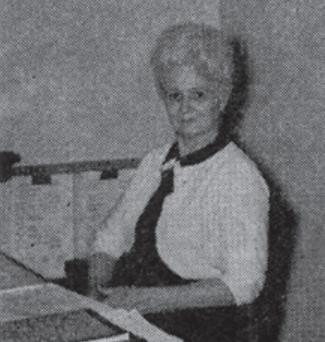
In addition to Lillian’s planning and supervisory duties, she insisted on personally baking the school’s pastry so it would be fresh and warm when served. Her pies were famous. She was a soft touch, and the boys knew it. She was never too busy to provide cookies or a dish of ice cream.
Lillian was utterly loyal and supportive of her kitchen workers, who responded by giving her the very best. The Palmers were a great team. Etta Banning, who had a lovely even temperament, was an expert vegetable cook and was proud of her salads. Helen Briscoe went about her efficient work sputtering away, mostly to herself. Calvin Davis, later of laundry fame, did all the pasteurizing of milk from the school farm. Walter Marryat, a very good chef during Lillian’s time, came in for a lot of ribbing from the boys, which he accepted good-naturedly.
Lillian’s menus were meticulously planned; the food always was practical and good, without frills. Often she tried surprises, vastly appreciated by faculty and boys with educated palates, shunned by hamburger-oriented teenagers.
Lillian put on memorable banquets for faculty and their families after students had gone home on vacation. The dining room remained open for faculty during the several days it took to enter grades and write reports. Her Thanksgiving feasts for faculty families and relatives ultimately vanished with economic belt-tightening, but what Thanksgivings they had been! Each family had a cloth-covered table in the school dining room, an enormous turkey at the head of each, traditional dishes at hand; all we provided was our favorite carving set. Leftovers were wrapped to take home. Afteward, adults gathered over coffee, and the dining room and main common room rang with shrieks and pounding feet as small faculty children dashed about in their holiday best. J
SAS / ST. ANDREW’S MAGAZINE 84 / THE LAST WORD
SHE WAS A SOFT TOUCH, AND THE BOYS KNEW IT. SHE WAS NEVER TOO BUSY TO PROVIDE COOKIES OR A DISH OF ICE CREAM.
together. SAS
When the St. Andrew’s family comes together, the results are remarkable.
We did it!
This year, your generosity pushed the Saints Fund to new, record‑breaking heights!
Your annual gifts to St. Andrew’s make a real difference to the school and students of today, and will echo throughout our shared future.
We are so grateful for your support!
Scan the QR code above to enjoy a special thank you from all of us.






































 BY CHRIS HAYES
BY CHRIS HAYES

 WILLIAM ATKINSON AMHERST • SQUASH
SAGE COOKERLY SEWANEE • LACROSSE
ELIZABETH RAINEY COLGATE • SWIMMING
ALLAIRE BERL KENYON • TENNIS
GAVIN GREEN BROWN • ROWING
CLEO RAY BUCKNELL • ROWING
FLYNN BOWMAN SEWANEE • LACROSSE
PHINEAS HUNT MIDDLEBURY • FOOTBALL
SUNNY TRIVITS BOSTON COLLEGE • ROWING
WILLIAM ATKINSON AMHERST • SQUASH
SAGE COOKERLY SEWANEE • LACROSSE
ELIZABETH RAINEY COLGATE • SWIMMING
ALLAIRE BERL KENYON • TENNIS
GAVIN GREEN BROWN • ROWING
CLEO RAY BUCKNELL • ROWING
FLYNN BOWMAN SEWANEE • LACROSSE
PHINEAS HUNT MIDDLEBURY • FOOTBALL
SUNNY TRIVITS BOSTON COLLEGE • ROWING



























 Chaplain Jay Hutchinson
Chaplain Jay Hutchinson































































































 For more memories of Happy, who died early this year, see page 83.
For more memories of Happy, who died early this year, see page 83.


















































































